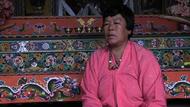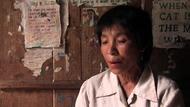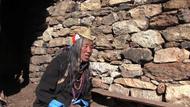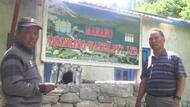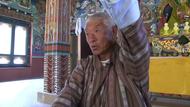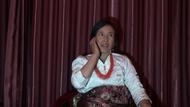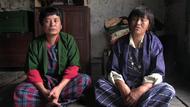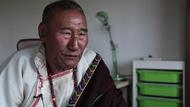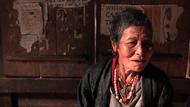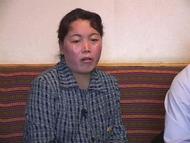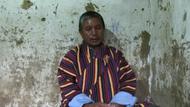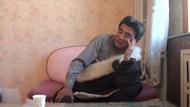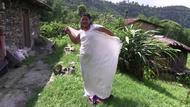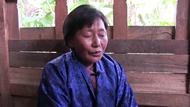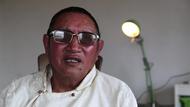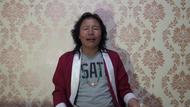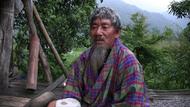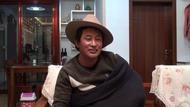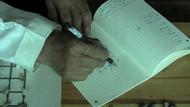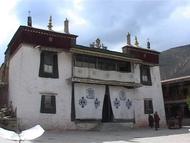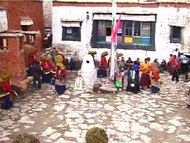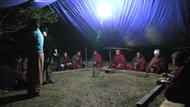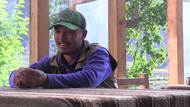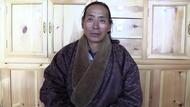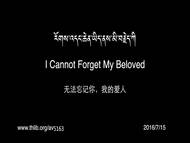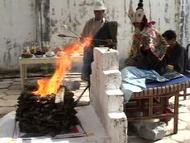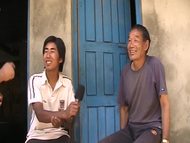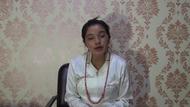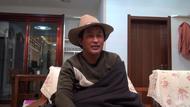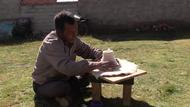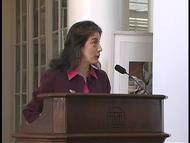Video Overview
Lhakpa Tseten on the history of the Lhasa Jokhang Temple
- Jokhang
- ཀཡ་ད་ངས་དེ་རིང་གཙུག་ལག་ཁང་གིའི་ལོ་རྒྱུས་མདོར་བསྡུས་ཅིག་ཞུ་གི་ཡིན།Well, I am going to tell a brief history of the Jokhang Temple.
- ཀད་སྤྱིར་བཏང་གཙུག་ལག་ཁང་ཟེར་ན། བོད་སྐད་ལ་ཡ་ཨ་ནི་གཅིག་གིའི་མཚན་ལ་ཡ་ཞུ་སྟངས་མང་པོ་ཡོའོ་༼ཡོད་༽རེད།Generally speaking, there are many different names for the Jokhang Temple in Tibetan.
- ཀལྷ་ས་ལ་ཡ་ཆ་བཞག་པ་ཡིན་ན། ད་ལྟ་གཙུག་ལག་ཁང་ཞུ་གི་ཡོའོ་༼ཡོད་༽རེད།In Lhasa it is called "Tsuklak Kang.”
- ཀད་དུང་ར་ས་འཕྲུལ་སྣང་གི་གཙུག་ལག་ཁང་ཞུ་གི་ཡོའོ་༼ཡོད་༽རེད།And it is also called the Rasa Trülnang Temple.
- ཀད་དུང་ག་རེ་རས་༼རེད་དམ་༽ཟེར་ན་ཇོ་ཁང་ཟེར་བྱས་དེ་འདྲས་༼དེ་འདྲ༽ཟེར་ཐ་སྙད་མང་པོ་གཅིག་འབོད་ཀྱི་ཡོའོ་༼ཡོད་༽རེད།And it is also called the Jokang. So, [we call the Jokang Temple by] many terms.
- ཀཡིན་ནའི་༼ཡིན་ནའང་༽ཐ་སྙད་ག་ཚད་༼ག་ཚོད་༽བཏགས་པ་ཡིན་ནའི་༼ཡིན་ནའང༽ད་ལྟ་ལྷ་ས་ལ་ཡོད་པའི་གི་ཨ་ནི་གཙུག་ལག་ཁང་རང་རེད།Regardless of how many terms are designated for the Jokang Temple, [they all refer] to the Jokang Temple in Lhasa.
- ཀད་ལྟ་ལོ་རྒྱུས་ཐོག་ནས་བཤད་པ་ཡིན་ན་ཨ་ནི།Now, if [we] speak in terms of historical context
- ཀཇོ་ཁང་ཟེར་མཁན་དེ་ག་འདྲས་ཟེར་༼གང་འདྲ་ཟེར་༽བྱུང་པ་རས་༼རེད་དམ་༽ཟེར་ན།the ways in which the term "Jokang" was developed,
- ཀཇོ་ཁང་བྱུང་ཡག་གི་ལོ་རྒྱུས་དེ།the history of the term "Jokang" is
- ཀརིང་པོ་ཞེ་དྲག་ཡོའོ་༼ཡོད་༽མ་རེད།not very long.
- ཀག་ཡིན་ཟེར་ན་ད་ལྟ་བར་དུ་ལོ་དྲུག་བརྒྱ་མ་ཟིན་ཙམ་གཅིག་རེད།Because, it has been around for a little over 600 years.
- ཀསྤྱི་ལོའི་དུས་རབས་བཅོ་ལྔའི་ནང་ལོག་ལ་ཡ་རྒྱལ་དབང་ཙོང་ཁ་པས་ཨ་ནི།In the 15th century
- ཀསྤྱི་ལོ་ ༡༤༠༩ ལ་ཡ་ཨ་ནི།in the year 1409
- ཀལྷ་ལྡན་སྨོན་ལམ་ཆེན་མོ་དབུ་ཚུགས་ནས།after having founded the Lhasa Monlam Celebration
- ཀཨ་ནི་གཙུག་ལག་ཁང་གི་ད་ལྟ་འཁྱམ་རའི་ཚོད་དེ་ཕར་རྒྱ་བསྐྱེད་བཏང་གནང་པ་རེད།Gyalwang Tsongkhapa extended the corridor of the Temple.
- ཀརྒྱ་བསྐྱེད་བཏང་ཨ་ནི།Having extended [the corridor]
- ཀལྷ་ས་གཙུག་ལག་གི་རྟེན་གཙོ་ལ་ཡ་བཞུགས་པའི་ཇོ་བོ་ཤཱཀྱ་མུ་ནི་ཡར་དབུ་པྲོག་ཕུལ་བྱས།[Gyalwang Tsongkhapa] adorned the Jowo Shakyamuni residing as the main statue in the Lhasa Temple with a head ornament.
- ཀཨ་ནི་གཞི་ནས་ག་རེ་རེད་༼རེད་དམ་༽ཟེར་ན།And only then
- ཀཨ་ནི་ཤཱཀྱ་ཐུབ་པ་སྤྲུལ་སྐུའི་ཆ་ཆས་དེ་ལོངས་སྐུའི་ཆ་ཆས་ལ་ཡ་བསྒྱུར་པ་རེད།the Shakyamuni in the form of an Emananation Body was transformed into the form of an Enjoyment Body.
- ཀལོངས་སྐུའི་ཆ་ཆས་ལ་ཡ་བསྒྱུར་བྱས་གཞི་ནས་ཨ་ནི།It was only then [when] it was transformed into the form of an Enjoyment Body
- ཀཤཱ་ཀྱ་ཐུབ་པའི་མཚན་ལ་ཡ་ཇོ་བོ་ཇོ་བོ་ཟེར་ཨ་ནི་འབོད་པ་རེད།that [people] started referring to Shakyamuni as “Jowo.”
- ཀདེ་འདྲས་ཟེར་༼དེ་འདྲ་ཟེར་༽ཞུ་དུས་ཇོ་བོ་བཞུགས་སའི་ཨ་ནི་ཁང་པ་ཡིན་ནའི་༼ཡིན་ནའང་༽འདྲ།So, whether it is the house [Tib. kangpa] for the Jowo
- ཀཇོ་བོ་བཞུགས་སའི་ལྷ་ཁང་ཡིན་ནའི་༼ཡིན་ནའང་༽འདྲ།or whether it is the temple [Tib. lhakang] for the Jowo
- ཀཡང་ན་ཨ་ནི་ཇོ་བོར་ཡ་ལྷ་ཡི་ལྷ་ཟེར་འབོད།the Jowo is referred to as the “god among gods”
- ཀལྷ་ཡིའི་ལྷ་བཞུགས་སའི་ཁང་པ་ཡིན་པས་ན་ཨ་ནི་ལྷ་ཁང་ཟེར་བྱས་བྱས།and because [the Temple] is the house [Tib. kangpa] for the god among gods, it is referred to as a temple [Tib. lhakang].
- ཀདེ་འདྲས་ཟེར་༼དེ་འདྲ་ཟེར་༽བྱས་བྱས་ཨ་ནི་ཇོ་བོ་ཤཱཀྱ་ཐུབ་པ་བཞུགས་ས་སོང་ཙང།So, because it is the residence of the Jowo Shakyamuni
- ཀཨ་ནི་གཙུག་ལག་ཁང་ཟེར་ནའི་༼ཟེར་ནའང་༽འདྲ། ཇོ་ཁང་ཟེར་ནའི་འདྲ།whether [you] call it the Tsuklak Kang or Jokang
- ཀའོ་དེ་འདྲས་ཟེར་༼དེ་འདྲ་ཟེར་༽མཚན་བཏགས་པ་རེད།this is how the name developed.
- ཀད་གཙུག་ལག་ཁང་དེ་ག་དུས་བསྐྱོན་པ་རས་༼རེད་དམ་༽ཟེར་ན།As for when the Tsuklak Kang was built,
- ཀཨ་ནི་སྤྱི་ལོའི་སྔོན་གྱི་སྤྱི་ལོའི་སྔོན་ཟེར་གྱི་ཡོའོ་༼ཡོད་༽མ་རེད། སྤྱི་ལོའི་གི་དུས་རབས་བདུན་པའི་ནང་ལོགས་ལ་ཡ་གཏུགས་གི་ཡོའོ་༼ཡོད་༽རེད།[the time period for this] goes back to 7th century CE, not to the 7th century BCE.
- ཀསྤྱི་ལོའི་དུས་རབས་བདུན་པའི་སྐབས་ལ་ཡ་ད་བོད་ཀྱི་མཐོ་བོད་རྒྱལ་རབས་བྱས་པ་ཡིན་ན།According to Tibetan history, by the 7th century
- ཀརྒྱལ་ཐོག་མང་པོ་བྱོན་པ་རེད།[Tibet] had had many kings.
- ཀརྒྱལ་ཐོག་མང་པོའི་ནང་ལོགས་ནས་ཨ་ནི།Out of these many kings
- ཀད་འགའ་ཤས་གཅིག་གིས་༼ཁ་ཤས་གཅིག་གིས་༽རྒྱལ་ཐོག་གསུམ་ཅུ་སོ་གཉིས་ཡའི་༼ཡང་༽ཟེར་གྱི་ཡོའོ་༼ཡོད་༽རེད།[it was Songtsen Gampo who] was referred to as the 32nd king by some [scholars]
- ཀའགའ་ཤས་༼ཁ་ཤས་༽གཅིག་གིས་རྒྱལ་ཐོག་གསུམ་ཅུ་སོ་གསུམ་ཡའི་༼ཡང་༽ཟེར་གྱི་ཡོའོ་༼ཡོད་༽རེད།and others refer to [him] as the 33rd king.
- ཀརྒྱལ་ཐོག་སུམ་ཅུ་སོ་གཉིས་ལ་ཡ་ལྟོས་བྱས་ཞུས་པ་ཡིན་ན།If [I] tell the story considering [him] as the 32nd king
- ཀཨ་ནི་རྒྱལ་པོ་སྲོང་བཙན་སྒམ་པོའོ་སྐབས་ལ་ཡ།during the time of King Songtsen Gampo
- ཀགཞི་ནས་ཨ་ནི་ད་ལྟའི་གཙུག་ལག་ཁང་དེ་ཕྱག་བཏབ་གནང་པ་རེད།the Temple was first established.
- ཀརྒྱལ་པོ་སྲོང་བཙན་སྒམ་པའི་སྐབས་ལ་ཡ་ཨ་ནི། སྐབས་དེ་དུས་བོད་ཀྱི་ཨ་ནི་ཆབ་སྲིད་ཡིན་ནའི་༼ཡིན་ནའང་༽འདྲ་དཔལ་འབྱོར་ཡིན་ནའི་༼ཡིན་ནའང་༽འདྲ་རིག་གནས་ཡིན་ནའི་༼ཡིན་ནའང་༽འདྲ།During the time of King Songtsen Gampo, Tibetan political affairs, economy, and culture
- ཀཆེད་ཨ་ནི་དར་རྒྱས་ཆེན་པོ་ཞིག་གི་སྐབས་ཡིན་པ་རེད།were all a great success.
- ཀདེ་འདྲས་ཟེར་༼དེ་འདྲ་ཟེར་༽ཆགས་པའི་སྐབས་ལ་ཡ་ཨ་ནི་ག་རེ་བྱས་པ་རས་༼རེད་དམ་༽ཟེར་ན།So, when Tibet [was enjoying such a great success]
- ཀརྒྱ་བལ་ནས་ཨ་ནི་བཙུན་མོ་མི་འདྲ་བ་གཉིས་བསུས་པ་རེད།[they] took two princesses, one from China and one from Nepal.
- ཀརྒྱ་ནག་ཡུལ་ནས་ཨ་ནི་ལྦུན་ཤིང་ཀོང་ཇོ་བསུས།Wencheng Kongjo was invited from China.
- ཀཨ་ནི་བལ་པོའི་ཡུལ་ནས་ཨ་ནི་ཁྲི་བཙུན་ཨ་ནི་བསུས་བྱས།And Tritsun was invited from Nepal.
- ཀགཞི་ནས་ག་རེ་རས་༼རེད་དམ༽ཟེར་ན་ཁྲི་བཙུན་མ་རེད། བལ་བཟའ་ཁྲི་བཙུན།[She] was not the main queen [Tib. tritsun], but the Nepalese princess, Tritsun.
- ཀའོང་བལ་བཟའ་ཁྲི་བཙུན་བསུས་བྱས་གཞི་ནས་ཨ་ནི།Only after Tritsun, the Nepalese princess was invited,
- ཀའདའི་༼འདིར་༽ག་རེ་རས་༼རེད་དམ་༽ཟེར་ན་གཙུག་ལག་ཁང་དེ་ཕྱག་བཏབ་ཡས་ཀྱི་གྲོས་འགོ་བཏིང་གནང་པ་རེད།did the project for establishing the Temple begin.
- ཀའདི་འདྲས་ཟེར་༼འདི་འདྲ་ཟེར་༽གྲོས་འགོ་བཏིང་གནང་པའི་སྐབས་ལ་ཡ་ག་རེ་བྱེད་ཀྱི་ཡོའོ་༼ཡོད་༽རས་༼རེད་དམ་༽ཟེར་ན།What [they] did when [they] started the project was,
- ཀགཙུག་ལག་ཁང་འདི་སྐབས་དེ་དུས་གནས་སའི་ས་ཆ་དེ་འོ་ཐང་གི་མཚོ་ཟེར་གྱི་ཡོའོ་༼ཡོད་༽རེད།the place where the Temple stands now was called Otang gi Tso (lake of a plain of milk).
- ཀའོ་ཐང་གི་མཚོ་ཟེར་ཡས་དེའི་གནས་ས་དེ་སྐམ་ས་མ་རེད།Otang gi Tso (lake of a plain of milk) was not located on dry land.
- ཀསྐམ་ས་མ་ཡིན་པ་བྱས་འདམ་རྫབ་ཀྱི་ཁྲོད་དང།It was located on a marshd, not on dry land.
- ཀཨ་ནི་འདིའི་དཀྱིལ་འདའི་༼འདིར་༽མཚོ་གཅིག་ཡོའོ་༼ཡོད་༽རེད།And there was a lake in the middle of it.
- ཀམཚོ་འདི་ལ་ག་རེ་ཞུ་གི་ཡོའོ་༼ཡོད་༽རས་༼རེད་དམ་༽ཟེར་ན་འོ་མ་མཚོ་ཞུ་གི་ཡོའོ་༼ཡོད་༽རེད།The name of the lake was Oma Tso (milk lake).
- ཀབྱས་ཙང་འོ་མ་མཚོ་ཞུ་ཡག་དེ་བོད་ཀྱི་ཨ་ནི་ས་བཅད་བརྟག་པའི་སྐབས་ལ་ཡ།The reason why it is called Oma Tso (milk lake) according to the geographical analysis is that
- ཀག་རེ་རས་༼རེད་དམ་༽ཟེར་ན་བོད་ཀྱི་ས་ཆེན་པོ་དེ་ཨ་ནི་སྲིན་མོ་གན་གྱལ་ལ་ཡ་ཉལ་པ་འདྲ་པོ་གཅིག་ཡོད་ཟེར།the vast land of Tibet looks like a demoness sleeping with her front body facing up.
- ཀསྲིན་མོ་གན་གྱལ་ལ་ཡ་ཉལ་པ་འདྲ་པོའི་ནང་ལོགས་ནས་ཨ་ནི།Among [the body parts of] the demoness lying with the front of her body facing up
- ཀགཙུག་ལག་ཁང་གནས་ས་དེ་སྲིན་མོའི་སྙིང་ཁྲག་གི་ཚོད་དེ་ཡིན་ཟེར་གྱི་ཡོའོ་༼ཡོད་༽རེད།the temple was situated on the heart's blood of the demonness.
- ཀབྱས་ཙང་སྲིན་མོའི་སྙིང་ཁྲག་འདི་ཨ་ནི་གནོན་ཡག་གིའི་ཆེད་དུ།So, in order to suppress the heart's blood
- ཀཨ་ནི་གཙུག་ལག་ཁང་གཅིག་ཕྱག་བཏབ་ཡག་ལ་ཡ་གཏན་འཁེལ་པ་རེད།a decision was made to build a temple there.
- ཀགཏན་འཁེལ་བྱས་སྐབས་དེ་དུས་ག་རེ་རས་༼རེད་དམ་༽ཟེར་ན།Well, during the time when the decision was being made,
- ཀརྒྱ་ནག་ཡུལ་ནས་ཕེབས་པའི་རྒྱ་བཟའ་ཀོང་ཇོ།because the Chinese princess Kongjo
- ཀཨ་ནི་རྩིས་ལ་མཁས་པ་ཡོད་ཙང་།was skilled in astrology
- ཀཨ་ནི་རྒྱའི་སྤོར་ཐང་ཨ་ནི་བརྒྱད་ཅུ་བསྐོར་ནས།[she] did the Chinese divination eighty times
- ཀས་དཔྱད་ལ་བརྟག་པ་བྱེད་པའི་སྐབས་ལ་ཡ་ཨ་ནི་ས་དཔྱད་དེ་འདའི་༼འདིར་༽གཏན་འཁེལ་པ་རེད།when the geomantic signs were examined, it determined this [place] here
- ཀའདའི་༼འདིར་༽གཏན་འཁེལ་པའི་སྐབས་ལ་ཡ་ཨ་ནི།when this [place] was determined,
- ཀག་རེད་བྱས་པ་རས་༼རེད་དམ་༽ཟེར་ན་མཚོ་ག་ཚད་༼ག་ཚོད་༽བསུབ་པ་ཡིན་ནའི་༼ཡིན་ནའང་༽ཨ་ནི་ཀ་བ་ག་ཚོད་བརྒྱབ་པ་ཡིན་ནའི་༼ཡིན་ནའང་༽no matter how hard [they tried to] get rid of the lake and no matter how hard [they tried to] put up pillars
- ཀབསུབ་ཐུབ་ཀྱི་ཡོའོ་༼ཡོད་༽མ་རེད།[they were] not able to get rid of it.
- ཀབསུབ་མ་ཐུབ་ཙང་ཨ་ནི་བལ་བཟའི་ཐུགས་ལ་ཡ་ད་ཕལ་ཆེར་རྒྱ་བཟའ་ཀོང་ཇོས་ང་ལ་ཕྲག་དོག་བྱས་བྱས།As [they] were unable to get rid [of the lake], the Nepalese princess thought that it was probably because the Chinese princess was jealous of her.
- ཀཨ་ནི་ང་ད་ལྟ་ག་རེ་རས་༼རེད་དམ་༽ཟེར་ན་དགོན་པ་ཕྱག་བཏབ་སའི་ས་ཆ་དེ།So, [the Nepalese princess] thought that the place where the temple was to be built
- ཀཡག་པོ་གཅིག་ག་རེ་རས་༼རེད་དམ་༽ཟེར་ན་བསྟན་གནང་ཡོའོ་༼ཡོད་༽མ་རེད་ཐུགས་ལ་དགོངས་པ་རེད།was not chosen well [by the Chinese princess].
- ཀདེ་འདྲས་༼དེ་འདྲ་༽དགོངས་བྱས་ག་རེ་བྱས་པ་རས་༼རེད་དམ་༽ཟེར་ན།So, what [she] did after this was
- ཀརྒྱལ་པོ་ལའི་༼ལ་ཡང་༽མ་ཞུས་པ་བྱས་ཐབས་ཤེས་སྣ་ཚོགས་བྱས་པ་རེད་སྟེ།she tried to come up with many plans without consulting the king
- ཀགཞུག་གུར་༼རྗེས་ལ་༽ཐབས་ཤེས་མེད་བྱས་འུ་ཐུག་བྱས།but in the end [she] became hopeless and helpless
- ཀཨ་ནི་རྒྱལ་པོ་སྲོང་བཙན་སྒམ་པོར་ཡ་ཞུས་པ་རེད།and reported it to King Songtsen Gampo.
- ཀརྒྱལ་པོ་སྲོང་བཙན་སྒམ་པོར་ཡ་ཞུས་བྱས་ཨ་ནི་རྒྱལ་པོས་ག་རེ་གནང་པ་རས་༼རེད་དམ་༽ཟེར་ན།What the King did after he had been reported was
- ཀརྒྱལ་པོས་མཁྱེན་གྱི་ཡོའོ་༼ཡོད་༽རེད།the King knew that
- ཀདངོས་སུ་ག་རེ་རས་༼རེད་དམ་༽ཟེར་ན་ཨ་ནི་རྒྱ་བཟའ་ཀོང་ཇོས་བསྟན་པའི་ས་དེ་འགྲིགས་གི་ཡོའོ་༼ཡོད་༽རེད།the place that the Chinese princess suggested [for the Temple location] would work.
- ཀཡིན་ནའི་༼ཡིན་ནའང་༽བལ་མོས་ཨ་ནི།But, the Nepalese princess
- ཀརྒྱ་བཟའ་ཀོང་ཇོའི་འཁྲིས་ལ་བཏང་བཞག་པའི་ཨ་ནི།sent over to the Chinese princess
- ཀགཡོག་མོ་གཅིག་ཡོའོ་༼ཡོད་༽རེད་པཱ།a servant, right?
- ཀགཡོག་མོ་དེས་ག་རེ་རས་༼རེད་དམ་༽ཟེར་ན།What this servant did was
- ཀརྒྱ་བཟའ་ཀོང་ཇོས་གསུངས་པ་ནང་བཞིན་གྱིའི་ལན་དེ་འཁྱོར་ཐུབ་མེད་ཟེར་གྱི་ཡོའོ་༼ཡོད༽རེད།[she] could not convey the whole message dispatched by the Chinese princess.
- ཀལན་དེ་མ་འཁྱོར་ཙང་ཨ་ནི་ག་རེ་རས་༼རེད་དམ་༽ཟེར་ན།Because the complete message was not conveyed
- ཀའདིའི་ཁ་ཐུག་འདའི་༼འདིར་༽ཨ་ནི་གཅིག་གི་ཟློག་བཅོས་བྱེད་ཡག་ཁག་གཅིག་བྱེད་མ་ཐུབ་པ་བྱས་བྱས།some of the obstacle-expelling rituals could not be conducted during that time.
- ཀས་དེ་ཨ་ནི་བསྐང་མ་ཐུབ་པ་ཡིན་ཟེར་གྱི་ཡོའོ་༼ཡོད་༽རེད།Because of that, [they] were unable to fill up the place.
- ཀདེ་འདྲས་ཟེར་༼དེ་འདྲ་ཟེར་༽བསྐང་མ་ཐུབ་པ་བྱས་གཞུག་གུར་༼རྗེས་ལ་༽ག་རེ་རས་༼རེད་དམ་༽ཟེར་ན།So, [they] were unable to fill it up. What they did next was
- ཀསྲོང་བཙན་དང་བལ་བཟའ་གཉིས་ཨ་ནི།Songtsen and the Nepalese princess
- ཀསྤྲོ་འཆམ་ལ་ཡ་ཐད་པའི་སྐབས་རེད།went out for fun.
- ཀདེ་དུས་སྤྲོ་འཆམ་ཐད་པའི་སྐབས་ལ་ཡ་ཁོང་ཚོ་རྟ་ཐོག་ལ་ཡ་ཆིབས་བྱས་ཐད་པ་རེད།When they were out for fun, they rode horses.
- ཀརྟ་ཐོག་ལ་ཡ་ཆིབས་བྱས་ཐད་པའི་སྐབས་ལ་ཡ་ཨ་ནི།When they were riding the horses,
- ཀས་ཆ་འདའི་༼འདིར་༽ཚོད་འདའི་ཕེབས་དུས།and they arrived somewhere here
- ཀཨ་ནི་སྲོང་བཙན་སྒམ་པོས་ག་རེ་གསུངས་རས་༼རེད་དམ་༽ཟེར་ན།Songtsen Gampo said to
- ཀབལ་བཟའ་ལ་ཡ་ཁྱེད་རང་གི་ཨ་ནི་ཚིགས་ཁེབས་དེ་ནམ་མཁའི་མཐོངས་ལ་ཡ་སྐྱུར་དང་ཟེར།the Nepalese princess: “Throw your ring up to the expanse of sky.”
- ཀནམ་མཁའི་མཐོངས་ལ་ཡ་སྐྱུར་དང་ཟེར་ལབ་པའི་སྐབས་ལ་ཡ་ག་རེ་བྱས་པ་རས་༼རེད་དམ་༽ཟེར་ན།When [he] asked [her] to throw [the ring] up to the expanse of sky,
- ཀབལ་བཟས་ནམ་མཁའི་མཐོངས་ལ་ཡ་བསྐྱུར་པ་རེད།the Nepalese princess threw [the ring] up to the expanse of sky.
- ཀབསྐྱུར་པའི་སྐབས་ལ་ཡ་ཨ་ནི་ཚིགས་ཁེབས་ཟགས་སའི་གནས་གང་ཡིན་པ་དེ་ཨ་ནི་གཙུག་ལག་ཁང་ཕྱག་བཏབ་སའི་གནས་ལ་ཡ་གཏན་འཁེལ་པ་ཡིན་ཟེར་གསུངས་པ་རེད།As [she] threw [the ring], [the King] said that wherever the ring fell down, that place would be confirmed as the location for building the Temple.
- ཀའདི་འདྲས་ཟེར་༼འདི་འདྲ་ཟེར་༽གསུངས་དུས་ཚིགས་ཁེབས་དེ་སྐམ་སའི་ཐོག་ལ་ཡ་ཟགས་ཡོའོ་༼ཡོད་༽མ་རེད།So, the ring did not fall on dry land.
- ཀག་པར་ཟགས་པ་རས་༼རེད་དམ་༽ཟེར་ན་འོ་མ་མཚོ་དེའི་དཀྱིལ་འདའི་ཟགས་པ་རེད།It fell right in the middle of Oma Tso (milk lake).
- ཀའོ་མ་མཚོ་དེའི་དཀྱིལ་འདའི་༼འདིར་༽ཟགས་དུས།When [it] fell in the middle of Oma Tso (milk lake),
- ཀཨ་ནི་དེ་ནས་ག་རེ་རས་༼རེད་དམ༽ཟེར་ན་ཁ་དོག་ཨ་ནི་སྣ་ཚོགས་པའི།well, hum,
- ཀཨ་ནི་འོད་ཟེར་གྱིའི་ཕུང་པའི་ཁྲོད་ལ་ཡ་ཨ་ནི་འདིའི་ཁ་ཐུག་འདའི་ཨ་ནི་རྗེ་བློན་ཀུན་གྱིས་གཟིགས་པ་ཡིན་ཟེར་གྱི་ཡོའོ་རེད།the king and all his ministers saw [a stupa] here in the midst of light beams with various colors.
- ཀམཆོད་རྟེན་འདི་འདྲས་༼འདི་འདྲ་༽གཅིག་འཕྲུལ་སྣང་གི་མཆོད་རྟེན་གཅིག།[They saw] a miraculous stupa like that.
- ཀའདིའི་སྐབས་ལ་ཡ་ཨ་ནི་བློན་པོ་ཚོས་ག་རེ་རས་༼རེད་དམ་༽ཟེར་ན་ཕྱོགས་བཞི་ནས་རྡོ་འཕངས།So, when this was happening, the ministers threw stones from all four directions.
- ཀཨ་ནི་ཆོས་རྒྱལ་གྱིས་བདེན་ཚིག་བྱས།And the dharma king said some prayers of truth.
- ཀའདི་འདྲས་ཟེར་༼འདི་འདྲ་ཟེར་༽སྒྲུབ་པའི་སྐབས་ལ་ཡ་གཞུག་གུར་༼རྗེས་ལ་༽ག་རེ་རས་༼རེད་དམ་༽ཟེར་ན།When they were doing all these things,
- ཀཨ་ནི་མཆོད་རྟེན་གཅིག་གྲུབ་པ་ཡིན་ཟེར་གྱི་ཡོའོ་༼ཡོད་༽རེད།a stupa was formed in the end.
- ཀམཆོད་རྟེན་གཅིག་གྲུབ་བྱས། མཆོད་རྟེན་གྱི་ཁ་ལ་ཡ་ཨ་ནི།A stupa was formed. A beam was put on the stupa.
- ཀགདུང་མ་བཏང་བྱས། གདུང་མའི་སྣེ་མཆོད་རྟེན་འདའི་༼འདིར་༽བཞག་ཨ་ནི།One end of beam was put on the stupa
- ཀསྣེ་གཞན་ཨ་ནི་མཐའ་ལ་ཕར་བསྐྱལ་བྱས།and the other end was taken all the way out.
- ཀཨ་ནི་འདིའི་ཁ་འདའི་༼འདིར་༽ག་རེ་རས་༼རེད་དམ་༽ཟེར་ན་ཨ་ནི།So, it is believed that this
- ཀམཚོ་དེ་བསུབ་པ་ཡིན་ཟེར་གྱི་ཡོའོ་༼ཡོད་༽རེད།emptied out the lake.
- ཀད་མཚོ་བསུབ་ཚུལ་གི་༼གྱི་༽སྐོར་དེ་ང་ཚོའི་ལོ་རྒྱུས་ཐོག་ལ་བཤད་པ་ཡིན་ན།With regards to emptying out the lake according to our history book,
- ཀསྤྱིར་བཏང་ཡོངས་གྲགས་བྱས་ན་ད་ལྟ་ར་ས་འཕྲུལ་སྣང་གི་གཙུག་ལག་ཁང་།it is generally [believed that] when the Rasa Trülnang Tsuklak Kang was being built,
- ཀབཞེངས་པའི་སྐབས་ལ་ཡ་ར་ཟེར་དུས་ནི་ང་རང་ཚོའི་སྲོག་ཆགས་ར་རེད།[the Tibetan word] “ra” refers to the animal, goat, as in
- ཀར་ལུག་གཉིས་ཀྱིའི་ནང་ལོགས་གི་ར་དེ་རེད།ra (goat) and luk (sheep).
- ཀས་ཟེར་དུས་ནི་ས་ཆ་རེད།And [the Tibetan word] “sa” refers to earth.
- ཀཨ་ནི་སྤྱིར་བཏང་ཡོངས་གྲགས་བཤད་པ་ཡིན་ན།And it is widely believed that
- ཀརའི་སྒལ་པ་ལ་ཡ་ས་ཁིར་༼འཁྱེར་༽བྱས་ཨ་ནི་མཚོ་དེ་བསུབ་པ་ཡིན་ཟེར་གི་༼གྱི་༽ཡོའོ་༼ཡོད་༽རེད།the lake was emptied out by taking earth on the back of goats.
- ཀཡིན་ནའི་༼ཡིན་ནའང་༽རྒྱལ་དབང་ལྔ་པས་མཛད་བཞག་པའི་ད་ལྟ་གཙུག་ལག་ཁང་གི་དཀར་ཆགས་ཀུན་གསལ་མེ་ལོང་ནང་ལོགས་ལ་ཡ།However, the Fifth Dalai Lama's catalogue of the contents of the Temple [called] Künsel Melong
- ཀའདི་ག་རས་༼ག་རེ་༽རེད་ཟེར་ན། རས་བསུབ་པའི་ཚུལ་དེ་གསལ་པོ་ཞེ་དྲག་གསུང་གི་མི་འདུགclearly does not talk about emptying [the lake] by goats.
- ཀདེ་འདྲས་སེ་མ་གསུངས་པ་བྱས། ཡིན་ནའི་གལ་སྲིད་རས་བསུབ་པ་ཡིན་ན།So, [he] did not mention it. But if goats emptied out [the lake]
- ཀསྐབས་དེ་དུས་ག་རེ་རས་༼རེད་དམ་༽ཟེར་ན་ཡུལ་སྐོར་མཁན་ཁག་གཅིག་གི་ཐུགས་ལ་ཡ་དགོངས་པ་བཞེས་ཀྱི་རེད།some of the tourists might wonder
- ཀཨ་ནི་རས་མཚོ་དེ་བསུབ་དགོས་པའི་རྒྱུ་མཚན་ག་རེ་ཡིན་ན།why goats had to empty out the lake,
- ཀརྟ་དང་གཡག་ལ་སོགས་པའི་ཨ་ནི་སེམས་ཅན་མང་པོ་ཡོའོ་༼ཡོད་༽རེད། དེ་ཚོའི་སྒལ་པ་ལ་ཡ་ཁིར་༼འཁྱེར་༽ཕྱིན་པ་ཡིན་ན་ཨ་ནི་སྟོབས་ཡའི་༼ཡང་༽ཆེན་པོ་རེད།there are many animals such as horses, yaks, and so forth. They are stronger, and they could have carried [the earth] on their back.
- ཀར་ཨ་ནི་སྟོབས་ཆུང་ཆུང་གི་སེམས་ཅན་གཅིག་ལ་ཡ་ཨ་ནི། ཁལ་བཀལ་བྱས་ཨ་ནི་འདི་བསུབ་པ་ཡིན་ན།[Some] might wonder how weak and small animal like goats emptied [the lake] with loads [of earth]
- ཀདཀའ་ལས་ཁག་པོ་རེད། དུས་ཚོད་མང་པོ་འགོར་གི་༼གྱི་༽རེད་དགོངས་ན།it would be really difficult and it would also take a long time.
- ཀདེ་ག་རེ་རས༼རེད་་དམ་༽ཟེར་ན་བོད་ཀྱི་མི་ལྐུགས་པ་ཡིན་པའི་རྟགས་མ་རེད།This is not because Tibetan people were stupid,
- ཀསྐབས་དེ་དུས་བོད་གི་༼ཀྱི་༽མི་ཞེ་དྲག་༼ཧ་ཅང་༽སྤྱང་པོ་རེད།Tibetan people were really intelligent.
- ཀསྤྱང་པོ་ཡིན་པའི་རྒྱུ་མཚན་ག་རེ་རས་༼རེད་དམ་༽ཟེར་ན།The reason why they were intelligent is because
- ཀརྟ་དང་གཡག་ལ་སོགས་པའོ་ཁལ་ཁིར་༼འཁྱེར་༽བྱས་ཨ་ནི། ས་དེ་སྐམ་པ་ཡིན་ན།if [they] were to make the area dry by carrying loads on the backs of horses and yaks,
- ཀངས་ད་གིན་ཞུས་པ་ནང་བཞིན་འོ་མ་མཚོའི་མཐའ་དེ་འདམ་རྫབ་རེད་པཱ།as I mentioned earlier the shore of the lake was all marshy,
- ཀའདམ་རྫབ་གི་༼གྱིའི་༽ཁྲོད་ལ་ཡ་ཨ་ནི་རྟ་དང་གཡག་ལ་སོགས་པ་དེ་ཚོ་ལུས་ཕོང་༼ལུས་ཕུང་༽ལྗིད་པོ་སོང་ཙང་།and since horses and yaks are heavy
- ཀཨ་ནི་མར་དིམ་ཡག་གི་ཉེན་ཁ་ཡོའོ༼ཡོད་༽རེད།there is the danger of getting stuck in the marsh.
- ཀའདི་འདྲས་༼འདི་འདྲ་༽དིམ་ཡག་ཉེན་ཁ་ཡོད་ཙང་།Since there was such danger
- ཀཨ་ནི་ག་རེ་བྱས་པ་རས་༼རེད་དམ་༽ཟེར་ན།what they did was
- ཀརའི་སྒལ་པ་ལ་ཡ་ཁིར་༼འཁྱེར་༽བྱས་ར་ལུས་ཡང་པོ་རེད།[they made] goats carry [the loads] on their back, as goats were not heavy.
- ཀཁོ་རང་གི་སྒལ་པ་ལ་འཁྱོག་ཚོད་ཀྱི་ས་གཅིག་བསྐུར་བཞག་དུས།Because of putting enough loads of earth on the goats’ backs,
- ཀཨ་ནི་མཚོ་དེ་བཀང་ཐུབ་པ་ཡིན་ཟེར་གི་༼གྱི༽ཡོའོ་༼ཡོད་༽རེད།it is believed that [they] were able to fill up the lake [with earth].
- ཀད་འདའི་༼འདིར་༽ང་རང་ཚོའི་གཙུག་ལག་ཁང་གི་ནང་ལོགས་ལ་ཡོད་པའི་ད་ལྟ་ཕ་གའི་ལྷོ་སྒོ་མེ་ལོང་ཅན་ཞུ་ཡས་གཅིག་ཡོའོ༼ཡོད་༽རེད་པཱ།Well, there is [a door] called Lhogo Melongjen [Eng. South mirror door) inside the Temple, right?
- ཀའདིའི་འཁྲིས་འདའི་༼འདིར་༽ག་རེ་རས་༼རེད་དམ་༽ཟེར་ན་ཨ་ནི།Beside it
- ཀད་ལྟ་བྱམས་པ་ཕྱི་གཤིའི་ལྷ་ཁང་ཡོད་པ་བྱས།stands a temple called Jampa Chishi.
- ཀབྱམས་པ་ཕྱི་གཤིའི་ལྷ་ཁང་གི་ཨ་ནི་ཁུག་ཀྱོག་འདའི་༼འདིར༽།At the corner of the Jampa Chishi Temple
- ཀཇོ་བོ་ར་མ་རྒྱ་མོ་ཟེར་མཁན་གཅིག་ཡོའོ་༼ཡོད་༽རེད།stands Jowo Rama Gyamo.
- ཀཇོ་བོ་ར་མ་རྒྱ་མོ་ཟེར་ཡས་འདི་ར་འདི་ག་རེ་རས་༼རེད་དམ་༽ཟེར་ན།The [Tibetan letter] “ra” symbolizes that
- ཀསྤྲུལ་པ་གཞུར་གུར་༼རྗེས་ལ་༽ག་རེ་རས་༼རེད་དམ་༽ཟེར་ན་རྡོ་ལ་ཡ་རང་བྱོན་དེ་བྱུང་པ་ཡིན་ཟེར་གི་༼གྱི་༽ཡོའོ་༼ཡོད་༽རེད།[the goat] was an emanation which came out naturally from a stone.
- ཀའདི་འདྲས་ཟེར་༼འདི་འདྲ་ཟེར་༽བྱས་བྱས་འདི་མཚོན་བྱེད་གཅིག་རེད།This is a symbol of that.
- ཀད་ཡིན་ནའི་༼ཡིན་ནའང་༽སྐབས་དེ་དུས་ང་རང་བསམ་བློ་བཏང་པ་ཡིན་ན་ར་གཅིག་ཚད་གི་༼ཀྱི་༽མ་རེད་བསམ་གིས་༼གྱིས་༽But, as I think about it, it seems like there was more than one goat,
- ཀགལ་སྲིད་ར་ཡིན་པའི་དབང་དུ་བཏང་པ་ཡིན་ན།assuming that it was the goat [who did all the carrying].
- ཀད་དེ་འདྲས་ཟེར་༼དེ་འདྲ་ཟེར་༽བྱས་བྱས་ཨ་ནི་རའི་སྒལ་པར་ཁིར་ནི་༼འཁྱེར་ནི་༽ས་བྱས།Then comes the [Tibetan word] “sa” [meaning] “earth,” which was carried by the goats.
- ཀཨ་ནི་འཕྲུལ་སྣང་ཟེར་དུས་སྐབས་དེ་དུས་ཨ་ནི་མཆོད་རྟེན་དེ་འདྲས་༼དེ་འདྲ༽ཅིག་འཁྲུངས་པ་རེད།And [the Tibetan word] “trülnang” [which means] “miraculous appearance” and indicates that a stupa was formed there.
- ཀམཆོད་རྟེན་འདི་འདྲས་༼འདི་འདྲ༽གཅིག་འཁྲུངས་བྱས། ཨ་ནི་འཕྲུལ་གྱི་སྣང་བ་ཟེར་ནའི་འདྲ།Such a [miraculous] stupa arose there. So, whether we call it a miraculous appearance or not,
- ཀའདི་འདྲས་༼འདི་འདྲ༽གཅིག་འཆར་བྱས་ད་དེ་ནས་ག་རེ་རས་༼རེད་དམ་༽ཟེར་ན།such [a stupa] did appear [there]. And furthermore
- ཀཆོས་རྒྱལ་གྱི་བདེན་ཚིག་བྱས། ལྷག་པར་དུ་ཆོས་རྒྱལ་གྱི་སྤྲུལ་འགྱུར་ཐོག་ནས།the king did the prayers of truth. Particularly through the dharma king's emanation [power]
- ཀཨ་ནི་བཟོ་བོ་མང་པོར་བསྐྲུན། ཨ་ནི་བོད་འབངས་ཐམས་བཅད་ལས་ལ་བསྐུལ།many craftsmen were emanated. And [he] made all Tibetan people work.
- ཀའོང་འདི་འདྲས་༼འདི་འདྲ་༽བྱས་བྱས་ཨ་ནི་གཙུག་ལག་ཁང་དེ་བཞངས་པ་ཡིན་ཟེར་གྱི་ཡོའོ་༼ཡོད་༽རེད།So, it is said that this is how the Temple was built.
- ཀད་ད་ལྟ་དེའི་ནང་ལོགས་ལ་བཞུགས་པའི་མཆོད་རྟེན་དེ་ལ་ག་རེ་ཟེར་གྱི་ཡོའོ་༼ཡོད་༽རས་༼རེད་དམ་༽ཟེར་ན།The name of the stupa that is in the Temple is
- ཀམཚན་ཡོངས་གྲགས་ལ་ཡ་རྟག་པ་མཆོད་རྟེན་ཟེར་གྱི་ཡོའོ་༼ཡོད་༽རེད།known as Takpa Chörten.
- ཀརྟག་པ་མཆོད་རྟེན་ཟེར་ཡག་འདི་ད་ལྟ་ང་རྣམ་ཚོས་མཇལ་རྒྱུ་ཡོད་པ་དེ་ག་རས་ཟེར་ན།The Takpa Chörten that we can visit now was
- ཀས་སྐྱ་པན་ཌི་ཏ་ཨ་ནི་དུས་རབས་བཅུ་གསུམ་ནང་ལོགས་ལ་ཡ་ས་སྐྱ་པན་ཌི་ཏས་གིས་ཨ་ནི་བཞངས་༼བཞེངས་༽གནང་པའི་མཆོད་རྟེན་དེ་རེད།originally built by Sakya Pandita in 13th century.
- ཀམཆོད་རྟེན་དེ་ག་རེ་རས་༼རེད་དམ་༽ཟེར་ན།This stupa was
- ཀསྐབས་དེ་དུས་མཚོ་དབུས་ནས་ཐོན་པའི་མཆོད་རྟེན་དེ་ཨ་ནི་ཕ་གིར་ཆགས་དབྱིབས་ལ་ཡ་ག་རེ་རས་༼རེད་དམ་༽ཟེར་ན་ཇི་བཞིན་དུ་ཨ་ནི་ཕ་གའི་བཞངས་༼བཞེངས་༽པ་ཡིན་ཟེར་གི་༼གྱི་༽ཡོའོ་༼ཡོད་༽རེད།believed to be built in accordance with the original shape of the stupa that came out from the middle of the lake.
- ཀད་ང་རང་ཚོས་དེང་སང་སྐད་ཆ་བྱས་པ་ཡིན་ན་ཨ་ནི་དྲན་རྟེན་གི་ཚོད་ཅིག་ལ་ཡ་བཞངས་༼བཞེངས་༽པ་ཡིན་ཞུ་གི་༼གྱི་༽ཡོའོ་༼ཡོད་༽རེད།In our modern language term, we can say that it was built in memory of [that stupa].
- ཀཡིན་ནའི༼ཡིན་ནའང་༽སྐབས་དེའི་སྐབས་ལ་ཡ་བཞངས་པའི་མཆོད་རྟེན་འདི་རིག་གནས་གསར་བརྗེའི་སྐབས་ལ་ཡ་ཉམས་ཆག་ཕྱིན་པ་རེད།But the stupa that was built during that time underwent some damage during the Cultural Revolution.
- ཀད་ལྟ་ཡོད་པ་དེ་ག་རེ་རས་༼རེད་དམ་༽ཟེར་ན་རིག་གནས་གསར་བརྗེའི་རྗེས་ལ་ཡ། ཨ་ནི་ཉམས་གསོ་གནང་པ་དེ་རེད།The one that is here now is the one that was restored after the Cultural Revolution.
- ཀའདི་འདྲས་ཟེར་༼འདི་འདྲ་ཟེར༽བྱས་ད་སྲོང་བཙན་རང་གི་འདིའི་ནང་ལོགས་ལ་ཡ་ཕྱག་བཟོ་ག་རེ་མཇལ་རྒྱུ་ཡོའོ་༼ཡོད་༽རས་༼རེད་དམ་༽ཟེར་ན།So, what are some of Songtsen Gampo's own works that we can see here?
- ཀང་རང་ཚོའི་མངོན་གསལ་དོད་ཤོས་གཙུག་ལག་ཁང་གི་ད་ད་ལྟ་འདའི་༼འདིར་༽བར་ཐོག་ནས་མཇལ་པའི་སྐབས་ལ་ཡ་འཁྱམ་ཆེན་པོ་འདིའི་གཡས་གཡོན་ལ་ཡ་སེང་གེ་བརྒྱ་ལ་མི་གདོང་གཅིག་ཟེར་ཡག་གིའི་སྐད་ཆ་གཅིག་ཡོའོ་༼ཡོད་༽རེད།The most obvious one is, when you look from the middle floor of the Temple, the Senge Gyala Midong Cig (One Hundred Snow Lions with One Human Face) which is on either side of the big corridor.
- ཀད་ཡིན་ནའི་༼ཡིན་ནའང་༽དེ་སེང་གེ་བརྒྱ་ཟེར་ལོ་རྒྱུས་ཐོག་ལ་ཡ་སེང་གེ་བརྒྱ་ཟེར་གསལ་ཡོའོ་༼ཡོད་༽རེད་དེ་ཡིན་ནའི་༼ཡིན་ནའང་༽Even though it is clearly mentioned that there are one hundred snow lions in history books
- ཀགྲངས་ཀ་ཞིབ་ཕྲ་བརྒྱབ་པའི་སྐབས་ལ་ལ་བརྒྱ་དང་ཞེ་བཅུ་ཞེ་བཞི་ཡོའོ་༼ཡོད་༽རེད།but if you count them thoroughly there are 144.
- ཀབརྒྱ་དང་ཞེ་བཅུ་ཞེ་བཞི། བརྒྱ་དང་ཞེ་བཅུ་ཞེ་བཞིའི་ནང་ལོགས་ལ་ཡ་ཨ་ནི་མིའི་གདོང་འཁྱེར་པའི་སེང་གེ་གཅིག་ཡོའོ་༼ཡོད་༽རེད།144. Amongst these 144 [snow lions] there is one snow lion with a human face.
- ཀཨ་ནི་སེང་གེ་འདི་ཀྱས་༼དེ་ཚོ་༽ཚང་མ་ག་རེ་རས་༼རེད་དམ་༽ཟེར་ན་སྣ་ཤོ་བསྡད་ཡོའོ་༼ཡོད་༽རེད།All of these snow lions have their noses torn apart.
- ཀསྣ་ཤོ་པའི་རྒྱུ་མཚན་ག་རེ་རས་༼རེད་དམ༽ཟེར་ན།The reason why [their] noses are torn apart is because,
- ཀསྐབས་དེ་དུས་སྲོང་བཙན་གིས་༼གྱིས་༽ཨ་ནི་བཟོ་མི་འདྲ་བ་ཨ་ནི་བརྒྱ་ལྷག་ཙམ་ལ་ཡ་སྤྲུལ་བྱས་ཨ་ནི།Songtsen had emanated himself into a hundred different craftsmen and
- ཀསེང་གེ་འདི་བཞངས་པའི་སྐབས་ལ་ཡ།[while they] were working on snow lions,
- ཀཨ་ནི་ནམ་ཞིག་བལ་བཟའ་ཁྲི་བཙུན་གིས་༼གྱིས་༽ཨ་ནི་གཡོག་མོ་མངགས་བྱས།at some point the Nepalese princess Tritsun sent her servant
- ཀཞལ་ལག་ཕུལ་གར་བཏང་པ་ཡིན་ཟེར་གི་༼གྱི་༽ཡོའོ་༼ཡོད་༽རེད།to give food [to them].
- ཀཞལ་ལག་ཕུལ་གར་བཏང་པའི་སྐབས་ལ་ཡ་སྒོ་མ་དཀྲོག་པར་ལ་ཡ་ཨ་ནི།As [the servant] entered without knocking on the door
- ཀའཛུལ་ཡོང་དུས་ཨ་ནི་སྲོང་བཙན་ད་ཞེ་ས་མ་ཞུས་ན་འདྲོགས་ཀ་ལངས་པའི་བཟོ་འདྲ་བྱས་བྱས།Songtsen got frightened, if we could use ordinary word to [explain his emotion],
- ཀཨ་ནི་སེང་གེའི་གི་སྣ་དེ་ལ་ཡ་ཨ་ནི་སྟེའུ་ཁ་ཤོར་བྱས།and he accidentally hit the snow lion's nose with a hatchet.
- ཀསྣ་དེ་ཆད་པ་ཡིན་ཟེར་གི་༼གྱི་༽ཡོའོ་༼ཡོད་༽རེད།That is why [their] noses are chopped off.
- ཀའོང་དེ་འདྲས་༼དེ་འདྲ་༽གིའི་ལོ་རྒྱུས་བཤད་གི་༼གྱི་༽ཡོའོ་༼ཡོད་༽རེད།This is the story [that we] tell.
- ཀསྲོང་བཙན་རང་གི་ཕྱག་ནས་རེད་ལ། ཨ་ནི་སྐབས་དེ་དུས་ཀྱི་ལོ་རྒྱུས་ཐོག་ལའི་༼ལ་ཡང་༽ད་ག་ནང་བཞིན་གསལ་བསྡད་ཡོའོ་༼ཡོད་༽རེད།[These] were made [with] Songtsen's own hands. It is clearly mentioned in history books also.
- ཀད་ད་ལྟ་འདུག་ཟེར་༼འདི་འདྲ་ཟེར་༽གཅིག་ཞུས་པ་རེད་པཱ།This is one explanation.
- ཀར་ས་འཕྲུལ་སྣང་གི་གཙུག་ལག་ཁང་ཟེར་བྱས་བྱས་གཅིག་ཞུས།This explanation is all about the Rasa Trülnang.
- ཀདེ་ནས་ད་ལྟ་དེ་ནས་ཡར་གཙུག་ལག་ཁང་གི་ནང་ལོགས་འདུག་ཟེར་༼འདི་འདྲ་ཟེར་༽ང་རང་ཚོ་ད་དེང་སང་ཡོད་པའི་རྒྱལ་སྒོ་འདུག་ཟེར་༼འདི་འདྲ་ཟེར་༽འཛུལ་བྱས་ཡོང་པ་ཡིན་ན།And if we enter into the Temple through the main gate
- ཀདེའི་ནང་ལོགས་ལ་ག་རེ་ཡོའོ་༼ཡོད་༽རས་༼རེད་དམ་༽ཟེར་ན་བར་འཁྱམས་ཆེན་པོ་ཅིག་སླེབས་ཀྱི་རེད།we will get to a big corridor inside it.
- ཀད་བར་འཁྱམ་ཆེན་པོ་དེ་གཙོ་བོ་ག་རེ་རེད་ཟེར་ན། བོད་ལ་ཡ་སྐད་གྲགས་ཡོད་པའི་ཨ་ནི་སློབ་གནས། ལྷག་པར་དུ་དགོན་སྡེ་ཁག་གསུམ་ལ་ཡ་ཆ་བཞག་ནའི་༼ནའང་༽འདྲ།So, what is this corridor? For instance there are three monasteries
- ཀཨ་ནི་སེ་ར། འབྲས་སྤུངས། དགའ་ལྡན་ལྷ་ས་ལ་ཡོད་པའི་དགེ་ལུགས་དགོན་ཆེན་གསུམ་ཡིན་ནའི་༼ཡིན་ནའང་༽འདྲ།such as Sera, Drepung, and Ganden, the three Gelug monasteries in Lhasa that are famous in Tibet,
- ཀཨ་ནི་ལྷ་ས་མ་ཡིན་པའི་དགོན་ཆེན་ཁག་ལ་ཡ།or even at other big monasteries that are not located in Lhasa
- ཀབོད་ཀྱི་གཞུང་བཀའ་བོད་ལྔ་ལ་ཡ་སྦྱངས་པ་མཐར་ཕྱིན་སོང་ན།when one completes the [studies of the] five volumes of texts
- ཀཨ་ནི་དགེ་བཤེས་ཀྱི་ཡིག་ཚད་བཏང་ཡག་གཅིག་ཡོའོ་༼ཡོད་༽རེད།there is the exam for the geshe degree.
- ཀད་ལྟ་འདིའི་ནང་ལོགས་ལ་འཁྱམ་ར་འདིའི་ནང་ལོགས་ལ་ཡ་ག་རེ་ཡོའོ་༼ཡོད་༽རས་༼རེད་དམ་༽ཟེར་ན།So, in this corridor
- ཀསེ་འབྲས་དགའ་གསུམ་ནས་ཨ་ནི་གྲྭ་པ་ཚང་མ་འདུས་བྱས།all the monks from Sera, Drepung, and Ganden would gather.
- ཀགྲ་ཆགས་བརྒྱབ་པ་ནང་བཞིན་བྱས།(no clue what this means ???)
- ཀགྲ་པའི་ནང་ལོགས་ནས་ཨ་ནི་སློབ་སྦྱོང་ཨང་ཀི་དང་པོ།Among monks it is those who are the best in academic success,
- ཀརྩེ་འདྲ་ཨ་ནི་ལྷ་རམས་པའི་འཛིན་གྲྭའི་ནང་ལོགས་ལ་ཡ་བཞུགས་ཡོད་པ།those who are in the class of the most prestigious geshe degree, Lharampa
- ཀགཞུང་བཀའ་བོད་ལྔ་མཐར་ཕྱིན་བྱས།who have completed the five volumes of texts
- ཀསྦྱངས་པ་མཐར་ཕྱིན་བྱས་ཨ་ནི་གཞུག་གུ་གཞུག་གུར་༼རྗེས་ལ་༽ག་རེ་རས་༼རེད་དམ་༽ཟེར་ན།finally once they have successfully completed [the five volumes of texts]
- ཀལྷ་ལྡན་སྨོན་ལམ་ཆེན་མོའི་སྐབས་ལ་ཡ། ཨ་ནི་འདའི་༼འདིར་༽རྒྱུགས་འབུལ་གནང་གར་ཕེབས་གི་ཡོའོ་༼ཡོད་༽རེད།they come here to take the exams during the Lhasa Monlam Ceremony.
- ཀསྨོན་ལམ་ཆེན་མོའི་རྒྱུགས་འབུལ་དེ་ག་དུས་འགོ་བཙུགས་གི་ཡོའོ་རས་༼ཡོད་པ་རེད་དམ་༽ཟེར་ན།The exams [for the Lharamapa degree] at the Monlam Ceremony usually start
- ཀད་སྤྱིར་བཏང་ག་རེ་རས་༼རེད་དམ་༽ཟེར་ན་སྨོན་ལམ་ཆེན་མོ་འགོ་བཙུགས་དུས།when the Monlam Ceremony begins.
- ཀབོད་ཟླའི་ཟླ་བ་དང་པོའི་ཚེས་གསུམ་ནས་འགོ་བཙུགས་བྱས་བཅོ་ལྔ་བར་དུ་བརྐྱངས།It starts on the 3rd of the first month of the Tibetan Lunar calendar and goes until the 15th [of that month].
- ཀགཞུག་གུར་༼རྗེས་ལ་༽ག་རེ་རས་༼རེད་དམ་༽ཟེར་ན་བཅུ་དྲུག་གི་སྐབས་ལ་ཡ།And on the 16th [of the month]
- ཀད་ལྟ་འདིའི་ནང་ལོགས་ལ་ཡོད་པའི་བྱམས་པ་ཆེད་གཞི་ཟེར་ཡག་གི་ལྷ་ཁང་འདིའི་ནང་ལོགས་ལ་ཡོད་པའི། བྱམས་པ་དེ་ཨ་ནི་གདན་འདྲེན་ཞུས་བྱས་ཨ་ནི་གཙུག་ལག་ཁང་ལ་ཡ་བསྐོར་བ་གཅིག་བརྒྱབ།the Maitreya [statue] that is in the temple called Jampa Chezhi is carried out to make a circumambulation of the Temple.
- ཀབརྒྱབ་ནས་ག་རེ་བྱེད་ཀྱི་ཡོའོ་༼ཡོད་༽རས་༼རེད་དམ་༽ཟེར་ན།The reason why [they] make a circumambulation [with the statue of Maitreya] is
- ཀམ་འོངས་པའི་ཨ་ནི་བསྟན་པ་ཤར་ཡས་ག་རེ་རས་༼རེད་དམ་༽ཟེར་ན། བསྟན་པ་ཤར་བའི་སྐབས་ལ་ཡ་ཨ་ནི། རང་ཉིད་ཨ་ནི་སངས་རྒྱས་དེའི་སྐུ་མདུན་དུ་ཨ་ནི་སྐྱེས་ཤིང་། ཨ་ནི་དམ་པའི་ཆོས་ཉི་མ་ཤར་བ་ནང་བཞིན་ཨ་ནི། ཡོང་ཡག་འདི་འདྲས་གིའི་༼འདི་ལྟ་བུའི་༽ཨ་ནི་སྨོན་ལམ་མཚོན་བྱེད་རེད།to indicate the wish to be born near the [future] Buddha's presence and the wish for the spread of [his] holy dharma like the sun when the [Buddha Maitreya's] Dharma spreads in future.
- ཀད་དེ་འདྲས་༼དེ་འདྲ་༽བྱས་བྱས་༼བྱས་ནས་༽དེའི་སྐབས་ལ་ཡ་ག་རེ་རས་༼རེད་དམ་༽ཟེར་ན།And it is during this time that
- ཀགྲ་པ་ཚང་མ་འདུས་ནས།all monks gather
- ཀཨ་ནི་ལྷ་རམས་པའི་རྒྱུགས་འབུལ་བྱེད་དགོས་ཀྱི་ཡོའོ་༼ཡོད་༽རེད།and take the Lharampa exams.
- ཀརྒྱུགས་འབུལ་བྱེད་ས་འདའི་༼འདིར་༽ག་རེ་ཞུ་གི་ཡོའོ་༼ཡོད་༽རས་༼རེད་དམ་༽ཟེར་ན།The name of the exam location is,
- ཀཨ་ནི་ཕ་གའི་ག་རེ་རས་༼རེད་དམ་༽ཟེར་ན་གཤམ་མ་གའི་ཡོའོ་༼ཡོད་༽རེད།it is down there.
- ཀརྡོའི་བཞུགས་ཁྲི་ཆེན་པོ་གཅིག་ཡོའོ་༼ཡོད་༽རེད།There is a big stone throne.
- ཀབཞུགས་ཁྲིའི་གཡས་གཡོན་ལ་ཡ་ག་རེ་བཞུགས་གི་ཡོའོ་༼ཡོད་༽རས་༼རེད་དམ་༽ཟེར་ན།The people who sit on either side of the throne
- ཀདགའ་ལྡན་ཤར་རྩེ་ཆོས་རྗེའི་ཤར་རྩེ་དང་། འོང་བྱང་རྩེ། ཁོང་ཚོས་ག་རེ་རས་༼རེད་དམ་༽ཟེར་ན་ཆོས་རྗེ་བཞུགས་གི་༼ཀྱི་༽ཡོའོ་༼ཡོད་༽རེད།are the Ganden Shartsé [Chöjé] and Ganden Jangtsé [Chöjé]. They are called chöjé (Dharma King) in Tibetan.
- ཀདེ་ནས་མདུན་འདའི་ག་རེ་བཞུགས་གི་༼ཀྱི་༽ཡོའོ་༼ཡོད་༽རས་༼རེད་དམ༽ཟེར་ན། དགའ་ལྡན་ཁྲི་པ་བྱས།And the one who sits up in front is the Throne-holder of the Geluk School.
- ཀཨ་ནི་བཞུགས་ཁྲིའི་ཐོག་ལ་ཡ་ག་རེ་བཞུགས་གི་༼ཀྱི་༽ཡོའོ་༼ཡོད་༽རས་༼རེད་དམ་༽ཟེར་ན།And the one who sits above this throne is
- ཀཨ་ནི་རྒྱལ་བ་རིན་པོ་ཆེ་བཞུགས་གི་༼ཀྱི་༽ཡོའོ་༼ཡོད་༽རེད།the Dalai Lama.
- ཀདེ་འདྲས་ཟེར་༼དེ་འདྲ་ཟེར་༽བྱས་བྱས་༼བྱས་ནས་༽ཨ་ནི་རྒྱུགས་འབུལ་གནང་བྱས།This is how the exams are conducted.
- ཀད་རྒྱུགས་འབུལ་གནང་ཡས་གི་༼ཀྱི་༽ལུགས་སྲོལ་དེ་ག་དུས་དར་པ་རས་༼རེད་དམ་༽ཟེར་ན།So, when did the tradition of taking exams begin?
- ཀ༡༤༠༩ ལ་ཡ། རྒྱལ་དབང་ཙོང་ཁ་པས་ཨ་ནི་སྲོལ་ཕྱེ་པ་རེད།It was started by the Lord Tsongkhapa in 1409.
- ཀརྒྱལ་དབང་ཙོང་ཁ་པས་སྲོལ་ཕྱེ་བྱས་ཨ་ནི།The Lord Tsongkhapa started the tradition and
- ཀཨ་ནི་འཁྱམ་ར་ཆེན་པོ་འདི་ཡའི་༼འདི་ཡང་༽ག་ལེར་ག་ལེར་ཨ་ནི་དར་རྒྱས་བྱུང་པ་རེད།this big corridor also gained its popularity gradually.
- ཀད་འཁྱམ་ར་ཆེན་པོའི་འདིའི་ནང་ལོགས་ལ་ཡ་ཨ་ནི།In this big corridor
- ཀལྡེབས་རིས་མང་པོ་མཇལ་རྒྱུ་ཡོའོ་༼ཡོད་༽རེད།there are many wall paintings that you can see.
- ཀལྡེབས་རིས་དེ་ག་རེ་རས་༼རེད་དམ༽ཟེར་ན།These wall paintings
- ཀགཙོ་བོ་ཨ་ནི་ཁག་གསུམ་ལ་བགོས་ཆོག་གི་ཡོའོ་༼ཡོད་༽རེད།can be divided into three main categories.
- ཀཕྱོགས་གཅིག་ག་རེ་ཡོའོ་༼ཡོད་༽རས་༼རེད་དམ་༽ཟེར་ན།On one side there is the
- ཀཨ་ནི་སངས་རྒྱས་ཀྱིའི་འཁྲུངས་རབས་མཚོན་བྱེད་ཀྱི་ཨ་ནི་ལྡེབས་རིས་རེད།wall painting that represents the previous birth stories of the Buddha.
- ཀསངས་རྒྱས་བཅོམ་ལྡན་འདས་ཨ་ནི་སངས་མ་རྒྱས་གོང་གི་འཁྲུངས་རབས་མཚོན་བྱེད་བྱས།It represents the birth stories of the Buddha before he became a buddha.
- ཀཕྱོགས་གཅིག་ག་རེ་རས་༼རེད་དམ་༽ཟེར་ན་ཨ་ནི་རྒྱལ་དབང་ཙོང་ཁ་པའི་ཨ་ནི་རྣམ་ཐར་མཚོན་གི་༼གྱི་༽ཡོའོ་༼ཡོད་༽རེད།And one side represents the life story of the Lord Tsongkhapa.
- ཀཨ་ནི་ག་རེ་རས་༼རེད་དམ་༽ཟེར་ན་བྱང་ངོས་ཕྱོགས་ལ་ཡོད་པ་དང་།And the one that is on the northern wall,
- ཀད་ལྟ་འདའི་༼འདིར་༽ང་རང་ཚོ་ཤར་ལ་ཡ་ཞལ་སློགthe one that faces to the east,
- ཀའོང་ནུབ་གི་༼གྱི་༽གྱང་ངོས་ཕྱོགས་འདའི་༼འདིར་༽ཡ་ག་རེ་ཡོའོ༼ཡོད་༽རས་༼རེད་དམ་༽ཟེར་ན།so, what is on the western wall?
- ཀསྐབས་དེ་དུས་ཨ་ནི་རྒྱལ་བ་ལྔ་པ་དང་ཨ་ནི་གུ་ཤི་ཧན་བསྟན་འཛིན་ཆོས་རྒྱལ་གཉིས། བཀའ་མོལ་གནང་པའི་ལྡེབས་རིས་གཅིག་བཀོད་ཡོའོ་༼ཡོད་༽རེད།There is a wall painting which depicts the Fifth Dalai Lama and Gushri Khan Tenzin Chögyal having a conversation.
- ཀདེ་ག་རེ་རས༼རེད་དམ་༽ཟེར་ན་སྐབས་དེ་དུས། གུ་ཤི་ཧན་གིའི་༼གྱིའི་༽རྒྱབ་སྐྱོར་འོག་ལ་ཡ། གཙང་པ་སྡེ་སྲིད་ཆམ་ལ་ཕབ།What this represents is that during that time with the support of Gushri Khan, the Tsangpa ruler was destroyed.
- ཀཆམ་ལ་ཕབ་བྱས་ཨ་ནི་དགའ་ལྡན་ཕོ་བྲང་ཕྱོགས་ལས་རྣམ་རྒྱལ་ཟེར་ཡག་གི་སྲིད་གཞུང་དེ་བཙུགས་པ་རེད། རྒྱལ་བ་ལྔ་པའི་སྐུ་དུས་ལ་ཡ།[He] was defeated and [they] founded the Tibetan government during the time of the Fifth Dalai Lama.
- ཀདེ་སྲིད་གཞུང་དེ་བཙུགས་ཡས་དེ་ག་པར་རས་༼རེད་དམ་༽ཟེར་ན།Where was this government founded?
- ཀའབྲས་སྤུངས་དགའ་ལྡན་ཕོ་བྲང་ལ་ཡ་རེད།It was founded at the Ganden Palace of Drepung Monastery.
- ཀད་ལྟ་དགའ་ལྡན་ཕོ་བྲང་ཞུ་ཡག་དེ། འབྲས་སྤུངས་དགའ་ལྡན་ཕོ་བྲང་ལ་ལ་བཙུགས་བྱས་གཞུ་གུར་ཡ་ག་རེ་བྱས་པ་རས༼རེད་དམ་༽ཟེར་ན།The Tibetan government was founded at the Drepung Monastery, and eventually what happened was
- ཀདགའ་ལྡན་ཕོ་བྲང་གི་གནས་ས་དེ་ཨ་ནི་རྩེ་པོ་ཏ་ལ་ལ་གདན་འདྲེན་ཞུས་པ་རེད།the site for the Tibetan government was moved to the Potala.
- ཀརྩེ་པོ་ཏ་ལ་ཡར་ག་རེ་རས་༼རེད་དམ་༽ཟེར་ན་ཆགས་པ་རེད།So, it was stationed at the Potala.
- ཀརྩེ་པོ་ཏ་ལ་ཡར་ད་ལྟ་ག་རེ་རས་༼རེད་དམ་༽ཟེར་ན་ཕོ་བྲང་དཀར་པོ་གཅིག་བྱས། ཕོ་བྲང་དམར་པོ་གཅིག་བྱས་བྱས་གྲུབ་ཆ་གཉིས་ལས་གྲུབ་ཡོའོ་༼ཡོད་༽རེད།The Potala is made up of two sections-the White Palace and the Red Palace.
- ཀཕོ་བྲང་དཀར་པོ་འདི་ཡའི་༼ཡང་༽ག་རེ་རས་༼རེད་དམ་༽ཟེར་ན།As for the White Palace
- ཀརྒྱལ་བ་ལྔ་པ་བཞེངས་ལ་ཕེབས་མ་ཕེབས་གིའི་༼ཀྱིའི་༽མཚམས་ནས་བྱས་བྱས།some time around the time of the Fifth Dalai Lama's death
- ཀའགོ་བཙུགས་ནས་རྒྱ་བསྐྱེད་གནང་བཞག་པ་གཅིག་རེད།it was started and expanded
- ཀསྡེ་སྲིད་སངས་རྒྱས་རྒྱ་མཚོའི་སྐབས་ལ་ཡ།during the time of the regent, Sangyé Gyatso.
- ཀད་རྒྱ་བསྐྱེད་གནང་བྱས་དེང་སང་གིའི་གནས་སྟངས་ལ་བྱས་པ་ཡིན་ན།It was expanded, and nowadays the situation is as follows:
- ཀཕོ་བྲང་དམར་པོ་དེ་ཆོས་ཕྱོགས་གིའི་༼ཀྱིའི་༽བྱེད་སྒོ་གནང་ཡག་དང།The Red Palace is for conducting religious ceremonies,
- ཀདེའི་ནང་ལོགས་ལ་རྒྱལ་བའི་སྐུ་མདུང་ལ་སོགས་པ།and there are the bodily remains of the Dalai Lamas,
- ཀཨ་ནི་རྒྱལ་བ་སྐུ་ཕྲེང་ལྔ་པ་བྱས།for instance the Fifth Dalai Lama's,
- ཀབདུན་པ་བྱས་བརྒྱད་པ་བྱས་དགུ་པ་བྱས་བཅུ་པ་བྱས་བཅུ་གཅིག་བྱས་བཅུ་གཉིས་བྱས་བཅུ་གསུམ་གིའི་ཨ་ནི།the Seventh Dalai Lama's, the Eight Dalai Lama's, the Ninth Dalai Lama's, the Tenth Dalai Lama's, the Eleventh Dalai Lama's, and the Twelfth Dalai Lama's
- ཀསྐུ་མདུང་ཡོད་པ་གང་ཞིག་དེའི་ནང་ལོགས་ལ་ཡ།bodily remains reside in there. In addition to that
- ཀཨ་ནི་དགེ་ལུགས་པའི་ལྷ་སྐུ།there are the statues of the deities belonging to the Geluk School,
- ཀཨ་ནི་སྙིང་མའི་ལྷ་སྐུ།and the statues of the deities belonging to the Nyingma School in it.
- ཀའོང་དེ་འདྲས་ཟེར་༼དེ་འདྲ་ཟེར་༽བྱས་བྱས་མདོར་ན་སྤྱིན་བཏང་བྱས་པ་ཡིན་ན།So, generally speaking, in brief,
- ཀབོད་ལ་ཡོད་པའི་བོད་དར་སངས་རྒྱས་ཆོས་ལུགས་གིའི་༼ཀྱིའི་༽གྲུབ་མཐའ་ཆེ་ཁག་བཞིའི། ཨ་ནི་མཁས་དབང་ཆེན་པོ་ཚོའི་སྐུ་འདྲ་ལ་སོགས་པ།the statues of the great scholars of the four schools of Buddhism that spread in Tibet and
- ཀབཀའ་འགྱུར་བསྟན་འགྱུར་ལ་སོགས་པ་མང་པོ་ཡོའོ་༼ཡོད་་༽་རེད།many canons of the Buddha's Words and Treatises are here.
- ཀབཀའ་འགྱུར་བསྟན་འགྱུར་ཡའི་༼ཡང་༽ཨ་ནི་དམིགས་བསལ་གིའི་༼གྱིའི་༽ཨ་ནི་ཁྱད་ཆོས་ལྡན་པ།As for the canons of the Buddha's Words and Treatises, they are very unique in that
- ཀབཀའ་འགྱུར་གསེར་བྲིས་ཨ་ནི་ཤུ་གུ་༼ཤོག་བུ་༽ཐིང་ཤོག་སྒང་ལ་ཡ་བྲིས་བཞག་པ།there are the canon of the Buddha's Words written in gold on blue paper and
- ཀརིན་ཆེན་སྣ་བདུན་གིས་༼གྱིས་༽བྲིས་བཞག་པ།written with the Seven Precious Gems.
- ཀཨ་ནི་འདི་འདྲས་ཟེར་༼འདི་འདྲ་ཟེར་་༽བྱས་བྱས་མང་པོ་ཡོའོ་༼ཡོད་༽རེད།So, there are many of them like these.
- ཀདེ་ཀྱས་༼དེ་རྣམས་༽ག་རེ་རས་༼རེད་དམ་༽ཟེར་ན་ཆོས་ཕྱོགས་གིའི་༼གྱིའི་༽བྱས།These are for the purpose of religious ceremonies.
- ཀཨ་ནི་ཕོ་བྲང་དཀར་པོ་དེ་ག་རེ་རས་༼རེད་དམ་༽ཟེར་ན།And as for the White Palace
- ཀགཙོ་བོ་སྲིད་གིའི་༼ཀྱིའི་༽ཕྱག་ལས་གནང་ས་ཡིན་ཟེར་གི་༼གྱི་༽ཡོའོ་༼ཡོད་༽རེད།it is mainly for conducting political affairs.
- ཀསྲིད་གིའི་༼ཀྱིའི་༽ཕྱག་ལས་གནང་ས་དང་རྒྱལ་བ་རིན་པོ་ཆེ་ཡིའི་གཟིམ་ཆུང་རེད།It is for carrying out political affairs and the residence of the Dalai Lama.
- ཀད་གཙོ་བོ་དེང་སང་ག་རེ་རས་༼རེད་དམ་༽ཟེར་ན་རྒྱ་བསྐྱེད་གནང་བཞག་པའི་མཐའ་འདའི་༼འདིར་༽རྒྱལ་བ་སྐུ་ཕྲེང་བཅུ་བཞི་དང་ཨ་ནི་རྒྱལ་བ་སྐུ་ཕྲེང་བཅུ་གསུམ་སྐབས་ལ་ཡ།Nowadays, basically, during the time of the Thirteenth Dalai Lama and the Fourteenth Dalai Lama, the boundary of the expansion,
- ཀརྒྱ་བསྐྱེད་གནང་ནས་རྒྱལ་བ་སྐུ་ཕྲེང་བཅུ་བཞི་དང་བཅུ་གསུམ་གཉིས་ཀྱི།They made the expansion and the palace of the Thirteenth and the Fourteenth Dalai Lamas
- ཀཨ་ནི་ཕོ་བྲང་འདིའི་ཕོ་བྲང་དཀར་པོའི་མཐའ་འདའི་༼འདིར་༽་ཡོའོ་༼ཡོད་༽རེད།on the edge of the of the White Palace.
- ཀའོང་འདི་འདྲས་ཟེར་༼འདི་འདྲ་ཟེར་༽བྱས་བྱས་༼བྱས་ནས་༽མདོར་ན་ག་རེ་རས་༼རེད་དམ་༽ཟེར་ན།So, anyhow, in brief,
- ཀསྐབས་དེ་དུས་ཆོས་སྲིད་བཟུང་འབྲེལ་གིའི་༼གྱིའི༽བདག་པོ་ལ་ཡ་ཨ་ནི།རྒྱལ་བ་ལྔ་པ་མངའ་གསོལ་བྱས།the Fifth Dalai Lama was appointed as the ruler of the political and religious government during that time.
- ཀཨ་ནི་གཞི་ནས་ག་རེ་རས་༼རེད་དམ་༽ཟེར་ན།And only then
- ཀཨ་ནི་གཅིག་གིས་བོད་དེ་ཡང་ཡའི་༼ཡང་བསྐྱར་༽གནས་སྐབས་ག་རེ་རས་༼རེད་དམ་༽ཟེར་ན།Tibet once again
- ཀགཅིག་བསྒྱུར་གིའི་༼གྱིའི་༽ཚོད་གཅིག་ཆགས་པ་རེད།became a unified country.
- ཀདེ་ཆགས་ཡག་དེ་ད་ལྟ་གཙུག་ལག་ཁང་གིའི་ལྡེབས་རིས་དེ་ནས་བསྟན་གྱི་ཡོའོ་༼ཡོད་༽རེད།This change is depicted in this mural of the Jokang Temple.
- ཀད་དེ་ནས་གཙུག་ལག་ཁང་འདུག་ཟེར་༼འདི་འདྲ་ཟེར་༽མཇལ་ནས་ཡར་ཕྱིན་པའི་སྐབས་ལ་ཡ།And as you enter the Jokang Temple like this,
- ཀགཡོན་ངོས་ཕྱོགས་འདའི་༼འདིར་༽ཀ་བ་གཅིག་ཡོའོ་༼ཡོད་༽རེད།there is a pillar to the left.
- ཀཀ་བ་འདི་ཡ་མཚན་ཆེན་པོ་ཡོའོ་༼ཡོད་༽རེད།This pillar is quite something.
- ཀཀ་བ་ཆེན་པོ་ཆེན་པོ་ཡིན་པ་གཅིག་ལ་ཡ།Even though the pillar is big,
- ཀཨ་ནི་ངོས་གཉིས་ནས་བལྟས་པའི་སྐབས་ལ་ཡ།but when you look at it from two sides
- ཀརྡོབ་བཙོག་གཉིས་ཨ་ནི་འཚང་བསྡད་ཡོའོ་༼ཡོད་༽རེད།[you will see] two stones stuck in it.
- ཀརྡོབ་བཙོག་གཉིས་འཚང་བསྡད་པའི་སྐབས་ལ་ཡ་ལོ་རྒྱུས་འདིས་ག་རེ་བཤད་ཀྱི་ཡོའོ་༼ཡོད་༽རས་༼རེད་དམ༽ཟེར་ན།Because there are two stones stuck there history books tell us that
- ཀགཙང་སྨྱོན་དང་དབུས་སྨྱོན་གཉིས་ག་རེ་རས་༼རེད་དམ་༽ཟེར་ན་སྤྲུལ་བསྒྱུར་བྱས་བྱས་༼བྱས་ནས་།༽Tsangnyön and Ünyön showed miracles.
- ཀཨ་ནི་ཁོ་གཉིས་ག་རེ་རས་༼རེད་དམ་༽ཟེར་ན་ཨ་ནི་སྤྲུལ་པ་བསྟན་རེས་བཏང་བྱས།གྲུབ་རྟགས་བསྟན་པའི་སྐབས་ལ་ཡ་ཨ་ནི།And while two of them were exchanging some miracles in turn and showing some supernatural feats,
- ཀདབུས་སྨྱོན་གིས་༼གྱིས་༽རྡོབ་བཙོག་གཅིག་ཀ་བ་ལ་འཕེན།Ünyön threw a stone at the pillar,
- ཀཨ་ནི་གཙང་སྨྱོན་གིས་༼གྱིས་་་༽རྡོབ་བཙོག་གཅིག་ཀ་བ་ལ་འཕེན་བྱས།and Tsangnyön threw a stone at the pillar.
- ཀད་ལྟ་ག་རེ་རས་༼རེད་དམ་༽ཟེར་ན་ཀ་བ་འདིའི་སྦུག་ལ་ཡ་ཨ་ནི།So, on this pillar
- ཀརྡོ་ང་རང་ཚོས་མངོན་གསུམ་དུ་མཐོང་ཡག་ཡོའོ་༼ཡོད་༽རེད།we can actually see the stones.
- ཀའོང་དེ་འདྲས་ཟེར་༼དེ་འདྲ་ཟེར་༽བྱས་བྱས་༼བྱས་ནས་༽ཨ་ནི་དེ་ནས་ཡར།So, if we proceed along and
- ཀང་རང་ཚོས་ད་གཙང་ཁང་གིའི་དབུས་ལ་ཡ་མཇལ་ཕྱིན་པ་ཡིན་ན།go to see the center of the shrine hall,
- ཀཨ་ནི་གཞོགས་ངོས་ཕྱོགས་ནས་འདུག་ཟེར་༼འདི་འདྲ་ཟེར་༽་གཡོན་ངོས་ཕྱོགས་ནས་ཡར་ཐད་པའི་སྐབས་ལ་ཡ།and when you go to your side to the left
- ཀསྔན་ལ་༼སྔོན་ལ་༽ཡ་ང་ཚོ་་ག་རེ་རས་༼རེད་དམ་༽ཟེར་ན་ང་ཚོ་འདུ་ཁང་དེ་མཇལ་གི་༼གྱི་༽རེད།first you will see the assembly hall.
- ཀད་འདུ་ཁང་དེ་མཇལ་ཡས་ལ་ཡ་ད་ལྟ་གཙུག་ལག་ཁང།In order to see the assembly hall, now when we say the "Temple"
- ཀགཙུག་ལག་ཁང་ཞུ་དུས་སྤྱིར་གིའི་༼གྱིའི་༽དགོན་པ་དང་མི་འདྲ་བ་ཁྱད་ཆོས་ག་རེ་ཡོད་རེད་ཟེར་ན།the "Temple" it is different from other monasteries in many characteristics.
- ཀདགོན་པ་ལ་ཡ་ཆོས་གྲ་མང་པོ་ཞེ་དྲག་༼ཧ་ཅང་༽ཡོའོ་༼ཡོད་༽རེད།Monasteries have many colleges.
- ཀདཔེར་ན་འབྲས་སྤུངས་ལ་ཆ་བཞག་ན་ཆོས་གྲ་ཁག་བཞི་ཡོའོ་༼ཡོད་༽རེད།For instance, Drepung Monastery has four different colleges.
- ཀགླིང་ཁང་བཞི་ཡོའོ་༼ཡོད་༽རེད།There are four “ling” (colleges).
- ཀགླིང་གླིང་ཟེར་ཡག་དེ་ང་རང་ཚོས་བྱས་ན་ཨ་ནི་ཚན་ཁག་མི་འདྲ་བ་ནང་བཞིན་རེད།The word "ling" is same as “section.”
- ཀབློ་གསལ་གླིང་ཨ་ནི་སྒོ་མང་གྲ་ཚང་སྔགས་པ་གྲ་ཚང་བདེ་གཡང་གྲ་ཚང།So there are Loseling College, Gomang College, Ngakpa College, and Deyang College.
- ཀཨ་ནི་སེ་ར་ལ་ཆ་བཞག་ནས་ད་ག་ནང་བཞིན་གིའི་༼གྱིའི༽And similarly for Sera Monastery,
- ཀམངགས་པ་གྲ་ཚང་ཨ་ནི་བྱེས་གྲ་ཚང་།there are Ngakpa College, Jé College,
- ཀཨ་ནི་རྒྱུད་སྨད་གྲ་ཚང།And Gyumé College.
- ཀརྒྱུད་སྨད་ཟེར་གིས་༼གྱིས་༽ག་རེ་རས་༼རེད་དམ་༽ཟེར་ན་ཨ་ནི།Oh, not Gyumé College. What is it called?
- ཀད་ལྟ་འདའི་༼འདིར་༽་ག་རེ་རས་༼རེད་དམ་༽ཟེར་ན།What is the name of the one located in...?
- ཀསྔགས་པ་གྲ་ཚང་གྲ་ཚང་འདི་འདྲས་ཟེར་༼འདི་འདྲ་ཟེར་༽་བྱས་བྱས་༼བྱས་ནས་༽ཡོའོ་༼ཡོད་༽རེད།Anyhow, there are Ngakpa College, and so forth.
- ཀད་མདོར་ན་གྲ་ཚང་དེ་ཀྱས་༼དེ་ཚོ་༽་ག་རེ་རས་༼རེད་དམ་༽ཟེར་ན།So, in brief, all of these monasteries are
- ཀསློབ་གླིང་མི་འདྲ་བ་ནང་བཞིན་རེད།like learning centers.
- ཀད་ད་ལྟ་འདའི་༼འདིར་༽གཙུག་ལག་ཁང་གིའི་ནང་ལོག་ལ་ཡོད་པའི་མདོ་ཁང་དེའི་ནང་ལོག་ལ་གཙོ་བོ།And now the assembly hall in the Jokang Temple
- ཀཆོས་འཆད་ཉན་གིའི་༼གྱིའི་༽གནང་སའི་ཚོད་མ་རེད།is not primarily for learning and studying religious texts.
- ཀའདི་་ག་རེ་རས་༼རེད་དམ་༽ཟེར་ན་ཉ་གདོང་བརྒྱད་ཡིན་ནའི་༼ཡིན་ནའང་༽འདྲ།So, whether it is the full moon day, new moon day, or the eighth day of the Tibetan lunar calendar,
- ཀཚེས་བཟང་དུས་བཟང་གཞན་ལ་ཡ་ག་རེ་གནང་གི་ཡོའོ་༼ཡོད་༽རས་༼རེད་དམ་༽ཟེར་ན།or any other auspicious days and holidays, what it does is that,
- ཀགཙུག་ལག་ཁང་ལ་ཡོད་པའི་དགེ་འདུན་དེ་ཀྱས་༼དེ་རྣམས་༽་བཞུགས་བྱས།the monks at the Jokang Temple take their seats
- ཀཕ་གའི་ཚོགས་ནས་ག་རེ་གནང་གི་ཡོའོ་༼ཡོད་༽རས་༼རེད་དམ་༽ཟེར་ན།and gather there. And what they do there is that
- ཀཨ་ནི་ཆོས་གིའི་༼ཀྱིའི་༽ཆོ་ག་གནང་གི་ཡོའོ་༼ཡོད་༽རེད།they perform religious ceremonies.
- ཀའོང་འདི་་ག་རེ་རས་༼རེད་དམ་༽ཟེར་ན་གཙུག་ལག་ཁང་གིའི་འདུ་ཁང་འདིའི་ནང་གནང་གི་ཡོའོ་༼ཡོད་༽རེད།Such religious ceremonies take place at the assembly hall in the Jokang Temple.
- ཀད་དེ་ནས་ཡར་འདུག་ཟེར་༼འདི་འདྲ་ཟེར་༽ཕྱིན་པ་ཡིན་ན་འདིའི་དང་པོ་དེ་་ག་རེ་རས་༼རེད་དམ་༽ཟེར་ན།And now if you go up like this, the first thing [that you will notice is]
- ཀཨ་ནི་རྒྱལ་དབང་ཙོང་ཁ་པའི་དབུས་བྱས་བྱས༼བྱས་ནས༽the temple where the Lord Tsongkapa takes the center stage
- ཀའཁོར་དག་པ་རྣམ་བརྒྱད་བཞུགས་པའི་ལྷ་ཁང་རེད།and there are the Eight Pure Retinue.
- ཀད་རྒྱལ་བ་ཙོང་ཁ་པ་ཞུ་ཡས་དེ་དགེ་ལུགས་པའི་ཆོས་གིའི་༼ཀྱིའི་༽སྲོལ་འབྱེད་རེད་ལ།The Lord Tsongkhapa is the founder of the Geluk School.
- ཀལྷག་པར་དུ་་ག་རེ་རས་༼རེད་དམ་༽ཟེར་ན་བོད་ཀྱི་བསྟན་པ་ལ་བཀའ་དྲིན་ཆེན་པོ་དཔེ་མི་སྲིད་པ་ཡིན་ཟེར་གི་༼གྱི་༽ཡོའོ་༼ཡོད་༽རེད།And he is particularly considered as someone who made a great contribution to the development of Tibetan Buddhism.
- ཀདེ་དང་ག་ག་རེ་རས་༼རེད་དམ་༽ཟེར་ན་ཇོ་བོ་རྗེ་དཔལ་ལྡན་ཨ་ཏི་ཤས།He and Atisha.
- ཀཨ་ནི་འདུལ་བའི་བསྟན་པ་སྟོད་ནས་གསོ་བའི་སྐབས་ལ་ཡ།And when the Vinaya doctrine was being revived in Western Tibet,
- ཀཨ་ནི་ཇོ་བོ་རྗེ་དཔལ་ལྡན་ཨ་ཏི་ཤས་གཞུ་གུར་༼རྗེས་ལ་༽Atisha later
- ཀབྱང་ཆུབ་ལམ་གྱི་སྒྲོལ་མ་མཛད།composed Bodhipathapradipa.
- ཀལམ་གྱི་སྒྲོལ་མ་མཛད་བྱས་དེ་རྩ་བར་བྱས་ནས་དེ་རྩ་བར་བྱས་ནས།Based primarily on Bodhipathapradipa
- ཀཨ་ནི་བྱང་ཆུབ་ལམ་རིམ་ཆེན་མོ་མཛད་ནས།[Tsongkhapa] composed the Great Exposition on the Path to Enlightenment, and
- ཀདགེ་ལུགས་པའི་བསྟན་པ་དེ་དར་གནང་པ་རེད།the Geluk School flourished.
- ཀབྱས་ཙང་དགེ་ལུགས་པའི་བསྟན་པ་དེ་ལ་ཡ་ཨ་ནི་དགེ་ལུགས་པ་ཟེར་གི་༼གྱི་༽རེད་ལ།Therefore, to the Geluk doctrine it is called the Geluk School
- ཀབཀའ་མདམས་གསར་མ་ཡང་ཟེར་གྱི་རེད།and it is also called the New Kadampa School.
- ཀདེ་ནས་ཕར་ཕྱིན་པའི་སྐབས་ལ་ཡ་ང་ཚོའི་ད་གིན་ཞུས་པ་ནང་བཞིན།And if you go that way, as I said earlier
- ཀབརྟག་པ་མཆོད་རྟེན་དེ་མཇལ།you will see the Takpa Stupa.
- ཀབརྟག་པ་མཆོད་རྟེན་ནས་ཕར་ཕྱིན་བྱས་ཨ་་ནི་སྨན་ལྷ་བདེ་བཤེགས་བརྒྱད་ཀྱིའི་ལྷ་ཁང་རེད།If you go farther up from the Takpa Stupa, there is the temple for the Eight Medicine Buddhas.
- ཀསྨན་ལྷ་བདེ་གཤེགས་བརྒྱད་དེའི་ནང་ལོགས་ལ་ཡ་ག་རེ་རས་༼རེད་དམ་༽ཟེར་ན།The Eight Medicine Buddhas are as follows:
- ཀམཚན་ལེགས་དང་རིན་ཆེན་གསེར་བཟང་ཀུན་མཁྱེན།Tsenlek, Rinchen, Serzang, Künkyen,
- ཀཨ་ནི་སྨན་གིའི་༼གྱིའི་༽རྒྱལ་པོ་ཤ་ཀྱ་ཐུབ་པ།Shakyamuni, the king of medicine,
- ཀའོང་དེ་འདྲས་༼དེ་འདྲ༽ཀྱིའི་ཆོས་གྲགས་ལ་སོགས་པ་ག་རེ་རས་༼རེད་དམ་༽ཟེར་ན།Chödrak, and so forth. So there are
- ཀཨ་ནི་སྨན་ལྷ་བདེ་གཤེགས་བརྒྱད་ཡོའོ་༼ཡོད་༽རེད།Eight Medicine Buddhas.
- ཀདེ་ག་རེ་རས་ཟེར་་ན་ཨ་ནི།As for what they are,
- ཀང་རང་ཚོ་ཡུལ་སྐོར་མཁན་གིའི་༼གྱིའི་༽ཡིན་ནའི་༼ཡིན་ནའང་༽འདྲ་ཨ་ནི་ཆོས་དད་མཁན་ཚང་མས།all people, be it the tourists or the devotees,
- ཀདེའི་མདུན་ལ་ཡ་ཕྱིན་བྱས་གསོལ་བ་སྨོན་ལམ་བཏབ་བྱས།go in front of these statues and make their prayers and wishes.
- ཀརང་ཉིད་གིའི་༼ཀྱིའི་༽་ག་རེ་རས་༼རེད་དམ་༽ཟེར་ན་ཕྲལ་སེལ་གྱིས་ཨ་ནི། ནད་ཙམ་ཡིན་པ་མ་ཟད་ད་དུང་་ག་རེ་རས་༼རེད་དམ་༽ཟེར་ན།They do the prayers to purify not only their, hum, temporary illnesses, but also, hum,
- ཀལུས་ངག་ཡིད་གསུམ་གྱིའི་ནད།to purify the illnesses of body, speech, and mind.
- ཀམདོར་ན་ལུས་ཀྱི་སྡིག་པ་ངག་གི་སྡིག་པ་ཡིད་ཀྱི་སྡིག་པ་ལ་སོགས་པ། འདི་ག་རེ་རས་༼རེད་དམ༽ཟེར་ན་དག་ཡས་ཀྱི་ཆེད་དུ།In brief, in order to purify, hum, the physical wrong-doings, verbal wrong-doings, mental wrong-doings, and so forth
- ཀསྨོན་ལམ་བརྒྱབ་ཨ་ནི་འདི་འདྲས་ཟེར་༼འདི་འདྲ་ཟེར་༽བྱས་བྱས་༼བྱས་ནས་༽ཡིད་ཆེད་གི་ཡོའོ་༼ཡོད་༽རེད།they do the prayers. And this is how they believe in them.
- ཀད་དེ་ནས་ཡར་བྱས་བྱས་ཨ་ནི་ག་རེ་མཇལ་གྱི་ཡོའོ་༼ཡོད་༽་རས་༼རེད་དམ་༽ཟེར་ན།And if you go further up, what you will see is that
- ཀལྡེབས་རིས་གྲ་རྒྱས་པོ་ཞེ་དྲག་༼ཧ་ཅང་༽ཡོའོ་༼ཡོད་༽རེད།there are many elaborate murals.
- ཀལྡེབས་རིས་ནང་ལོགས་ལ་ཡ་སྟོན་པའི་མཛད་ཆེན་བཅུ་གཉིས་མཛད་བའི་ལྡེབས་རིས་ཡོའོ་༼ཡོད་༽རེད།There is the mural of the 12 deeds of the Buddha Shakyamuni.
- ཀརྒྱལ་བ་བྱམས་པའི་ལྡེབས་རིས་ཡོའོ་༼ཡོད་༽རེད།There is the mural of the Buddha Maitreya.
- ཀརྒྱལ་བ་བྱམས་པའི་ལྡེབས་རིས་འདའི་༼འདིར་༽ཐུན་མོང་མ་ཡིན་པ་ཞེ་དྲག་༼ཧ་ཅང་༽ཡོའོ་༼ཡོད་༽རེད།The mural of the Buddha Maitreya is very unique.
- ཀཨ་ནི་དེ་ནས་ཡར་འདུག་ཟེར་མཇལ་ནས་ཨ་ནི།And having seen these,
- ཀདེའི་ནང་ལོག་ལ་ཡ་ད་ལྟ་གལ་ཆེ་ཤོས་གཅིག་ག་རེ་རས་༼རེད་དམ༽ཟེར་ན།one of the most important objects that exists here is
- ཀཐུགས་རྗེ་ཆེན་པོ་རང་བྱོན་ལྔ་ལྡན་ཟེར་ཡག་དེ་རེད།the one called [the statue of] Avalokitesvara with Five Naturally Born [Aspects.]
- ཀགཙུག་ལག་ཁང་གིའི་ད་ལྟ་ཨ་ནི་ཤ་ཀྱ་ཐུབ་པའི་ལྷ་ཁང་དེ།Even though the shrine room for the Buddha Shakyamuni is the main part of the Jokang Temple,
- ཀགཙོ་བོ་ཡིན་པའི་ཁ་ལ་ཡར་ཐུགས་རྗེ་ཆེན་པོ་རང་ལྔ་ལྡན་ཟེར་ཡག་དེ་གལ་ཆེན་པོ་ཞེ་དྲག་རེད།[the statue of] Avalokitesva with Five Naturally Born [Aspects] has some great significance.
- ཀད་ཐུགས་རྗེ་ཆེན་པོ་རང་བྱོན་ལྔ་ལྡན་ཟེར་ཡག་གིའི་རྒྱུ་མཚན་ག་རེ་རས་༼རེད་དམ་་༽ཟེར་ན།The reason why it is called [the statue of] Avalokitesva with Five Naturally Born [Aspects] is that
- ཀརྒྱག་མཁན་དེ་ནི་བལ་པོའི་བཟོ་རེད།the one who made it was a Nepalese craftsman.
- ཀབལ་པོའི་བཟོ་ག་རེ་རས་༼རེད་དམ་༽ཟེར་ན་ཁྲོ་བོ་ཟེར་ཡག་དེས་བཞངས་གནང་པ་རེད།The Nepalese craftsman by the name of Trowo made it.
- ཀད་བཞངས་གནང་པ་རེད་ཟེར་ནའི་འདི་ཡང་ག་་རེ་རས་༼རེད་དམ་༽ཟེར་ན་རྩོད་པ་ཅན་རེད།But if you say it was created, it becomes a point of dispute.
- ཀསྐབས་དེ་དུས་ག་རེ་རས་༼རེད་དམ་༽རྒྱལ་བ་ལྔ་པའི་ད་ལྟ། དཀར་ཆག་ཀུན་གསལ་མེ་ལོང་ནང་ལོག་ཡ་མཇལ་པ་ཡིན་ན།Well, if you read the catalogue Künsel Melong by the Fifth Dalai Lama
- ཀདེ་ག་རེ་རས་༼རེད་དམ་༽ཟེར་ན་བཟོས་བཞངས་པ་གཅིག་རེད་མིན་འདུག།it says that it was not created by a craftsman.
- ཀགང་འདྲས་ཟེར་༼གང་འདྲ་ཟེར༽རེད་ཟེར་ན་སྲོང་བཙན་སྒམ་པོས་སྐབས་དེ་དུས་གསོལ་བ་སྨོན་ལམ་བཏབ་བྱས།So what happened is that during that time, Songtsen Gampo made the [following] prayer:
- ཀངས་ག་རེ་རས་༼རེད་དམ་༽ཟེར་ན་ཨ་ནི་འདའི་༼འདིར་༽་སངས་རྒྱས་ཀྱིའི་ཨ་ནི་རྟེན་བཞུགས་སའི་ལྷ་ཁང་འདི་འདྲས་༼འདི་འདྲ་༽གཅིག་བརྒྱབ་པ་ཡིན་ན།If I build, hum, a temple for the statue of the Buddha
- ཀབར་ཆད་མང་པོ་ཡོའོ༼ཡོད་༽རེད།there will be a lot of obstacles.
- ཀབར་ཆད་དེ་ཀྱས་༼དེ་རྣམས་༽ཨ་ནི་ཐ་དག་ལྡོག་ཡས་ཀྱིའི་ཆེད་དུ།In order to get rid of all these obstacles
- ཀཨ་ནི་ངས་ཡི་དམ་གྱིའི་ཨ་ནི་ལྷ་གཅིག་བཞངས་དགོ་༼དགོས༽ཀྱི་ཡོའོ་༼ཡོད་༽རེད།I will have to build a statue of a tutelary deity.
- ཀཡི་དམ་གྱིའི་ལྷ་བཞངས་ཡག་དེ་ཨ་ནི། དམིགས་པ་ལ་ཡ་ག་རེ་བྱས་པ་རས་༼རེད་དམ་༽ཟེར་ན།So this is the plan that he made for making the statue of his tutelary deity.
- ཀརང་ཉིད་ཀྱི་ཨ་ནི་གནས་རྩ་ཆེན་པོ་ནས་ཨ་ནི་ས་རྩད་དང་ཤིང་རྩད་ལ་སོགས་པ་ཨ་ནི། འདྲ་མི་འདྲ་མང་པོ་ཞིག་གདན་འདྲེན་ཞུས་པ་རེད།So he brought various sacred earths, the roots of trees, and so forth from holy sites.
- ཀརྒྱ་མཚོའི་མཐའི་ཨ་ནི་སྦྱགས་མ་ལ་སོགས་པ།[For instance he brought] sprouts, and so forth that grew on the shore of the ocean,
- ཀཆུ་བོ་ནེ་རན་རྩ་ནས་བྱེ་མ་ལ་སོགས་པ།sand, and so forth from the Nerancana River
- ཀཨ་ནི་ཙན་དན་གུར་ཤི་ཁ།and gurshikha sandalwood.
- ཀའོང་དེ་འདྲས་ཟེར་༼དེ་འདྲ་ཟེར༽བྱས་བྱས་༼བྱས་ནས་༽་མང་པོ་གཅིག་གདན་དྲངས་བྱས།So this is how he brought many of these.
- ཀཨ་ནི་འདམ་བག་བརྫིས་པ་རེད།Then they kneaded [these into] clay.
- ཀདེང་སང་གིའི་སྐད་ཆ་བྱས་ན་འདམ་བག།"'dam bag" is a modern Tibetan word for clay.
- ཀཨ་ནི་ཡིག་སྐད་ནས་བྱས་ན་འཇིམ་པ་འཇིམ་པ་ཟེར་གྱི་རེད་པཱ།And in literary Tibetan it is called “jimpa”
- ཀའཇིམ་པ་བརྫིས་པ་རེད།So, they kneaded the clay.
- ཀའཇིམ་པ་བརྫིས་པའི་སྐབས་ལ་ཡ་འཇིམ་པ་བརྫིས་ཡས་ལ་ཡ་ཆུ་བརྒྱབ་ཡོའོ་༼ཡོད་༽མ་རེད།When they kneaded the clay, they did not add any water to knead the clay.
- ཀག་རེ་བརྒྱབ་པ་རས་༼རེད་དམ་༽ཟེར་ན།What they put was
- ཀར་དཀར་པོའོ་འོ་མ་དང་བ་དམར་པོའི་འོ་མ་གཉིས་མཉམ་དུ་བསྲེས་བྱས། ཨ་ནི་འདིའི་ནང་ལོག་ལ་ཡ་བརྫིས་པ་རེད།they mixed white goat's milk and red cow's milk together. With this they kneaded the clay.
- ཀབརྫིས་བྱས་ག་རེ་བྱས་པ་རས་༼རེད་དམ༽ཟེར་ན་འདམ་བག་བརྫིས་བཞག་པ་འདི།What they did with the kneaded clay is that
- ཀསྲོང་བཙན་སྒམ་པོ་རང་ཉིད་ཀྱིའི་དབུ་སྔས་ལ་ཡ་སྐྱོན་བྱས།Songtsen Gampo used this clay as his pillow
- ཀགཟིམ་བཞུགས་པ་རེད།and slept on it.
- ཀགཟིམ་བཞུགས་པའི་སྐབས་ལ་ཡ་མནལ་ལམ་ལ་ཡ་ག་རེ་འཁོར་པ་རས་༼རེད་དམ༽ཟེར་ན།While he was sleeping he had a dream of
- ཀཨ་ནི་ཡིད་དམ་གྱིའི་ལྷ་ཞི་བ་དང་ཁྲོ་བོ་ལ་སོགས་པའི་ལྷ་ཚོགས་མང་པོ། ཕྱོགས་བཅུའི་རྒྱལ་བ་སྲས་དང་བཅས་པ་མང་པོ་གཅིག། ཨ་ནི་འཇིམ་པ་དེ་ལ་ཡ་ཐིམ་པའི་རྨི་ལམ་རྨིས་པ་རེད།many assemblies of peaceful and wrathful deities and many Buddhas along with bodhisattvas being absorbed into the clay.
- ཀཐིམ་པའི་རྨི་ལམ་རྨིས་པ་རེད་དེ་འདྲས་ཟེར་༼དེ་འདྲ་ཟེར་༽ཨ་ནི་ཐིམ་པའི་རྨི་ལམ་གཅིག་རྨིས་བྱས།So, he had a dream of such absorbtion.
- ཀསང་ཞོགས་ཨ་ནི་མནལ་ལས་བསད་པའི་སྐབས་ལ་ཡ།And the next day when he woke up,
- ཀཨ་ནི་མི་རང་གིའི་སྐུ་མདུན་ལ་ཡ། ཐུགས་རྗེ་ཆེན་པོ་རང་བྱོན་ལྔ་ལྡན་བཞངས་གྲུབ་ཡོའོ་༼ཡོད༽རེད།[the statue of] Avalokitesva with Five Naturally Born [Aspects] had already been complete. It was sitting right in front of him.
- ཀཐུགས་རྗེ་ཆེན་པོ་སྤྱན་རས་གཟིགས་ག་རེ་རས་༼རེད་དམ༽ཟེར་ཕྱག་སྟོང་སྤྱན་སྟོང།It was Avalokitesvara with 1000 arms, 1000 eyes,
- ཀཞལ་བཅུ་གཅིག།11 faces,
- ཀཨ་ནི་ཞི་བའི་ཞལ་ཡོད་པ་ཁྲོ་བོའི་ཞལ་ཡོད་པ།some are peacefu-looking faces and some are wrathful-looking faces.
- ཀའོང་འདི་འདྲས་ཟེར་༼འདི་འདྲ་ཟེར་༽བྱས་བྱས་༼བྱས་ནས་༽་ཨ་ནི་བཅུ་གཅིག་ཞལ་གཅིག་བཞངས་གྲུབ་ཡོའོ་༼ཡོད་༽རེད།So, an eleven-faced Avalokitesvara with such characteristics had already been completed.
- ཀབཞངས་གྲུབ་ཡོད་དུས་སྲོང་བཙན་ག་རེ་རས་༼རེད་དམ༽ཟེར་ན།Because the statue was already completed, Songtsen, hum,
- ཀཨའོ་ང་ག་རེ་རས་༼རེད་དམ་༽ཟེར་ན་རྟེན་གཙོ་ལ་ཡ་ཕུལ་ཡས་ཀྱིའི། སངས་རྒྱས་རབ་བདུན་གྱིའི་ཨ་ནི་རིན་གསེར་ཕུལ་རྒྱུ་མ་བྱུང།said "I have not offered the relics of the Seven Universal Buddhas to the statue."
- ཀའོང་དེ་འདྲས་ཟེར་༼དེ་འདྲ་ཟེར་༽ཞུས་པའི་སྐབས་ལ་And when he said this,
- ཀབཟོ་བོས་ག་རེ་ལབ་པ་རས་༼རེད་དམ་༽ཟེར་ན།the craftsman said,
- ཀའདི་བཟོ་བོ་བདག་གིས་ཨ་ནི་བཞངས་པ་མ་ཡིན།I, the craftsman, did not make this statue.
- ཀའདི་ནི་ཨ་ནི་རང་བྱོན་ལགས་སོ།This is a naturally born statue.
- ཀསྲོང་བཙན་སྒམ་པོར་ཞུས་པ་ཡིན་ཟེར་གྱི་ཡོའོ་༼ཡོད་༽རེད།It is said that [he] said this to Songtsen Gampo.
- ཀཞུས་པའི་སྐབས་ལ་ཡ་སྐུ་དེས་རང་བཞིན་གྱིས་ཨ་ནི་གཤམ་ཐབས་ཡར་བརྫེས་བྱས།When the craftsman made the report, the statue naturally pulled up its robes
- ཀཔུས་མོའི་བར་དུ་བརྫེས་ནས་ཨ་ནི་ག་རེ་བྱས་པ་རས་༼རེད་དམ༽ཟེར་ན།up to its knees and then
- ཀགཟུངས་ཤུགས་དེ་ཀྱས་༼དེ་རྣམས་༽ཡར་ཕུལ་རྒྱུ་བྱུང་པ་རེད།he was able to offer the consecration mantras.
- ཀགཟུངས་ཤུགས་ཡར་ཕུལ་རྒྱུ་བྱུང་བྱས།So, he was able to offer the consecration mantras
- ཀཨ་ནི་གཞུ་གུར་༼རྗེས་ལ་༽ག་རེ་བྱས་པ་རས་༼རེད་དམ་༽་ཟེར་ན།and what happened was
- ཀད་དུང་དེའི་ནང་ལོག་ལ་ཡ་སྤྲུལ་པ་གཉིས་གཅིག་ཐིམ་པ་རེད།two more emanations dissolved into the statue.
- ཀསྤྲུལ་པ་གཉིས་གཅིག་ཐིམ་བྱས་ག་རེ་ཐིམ་པ་རས་༼རེད་དམ༽ཟེར་ན།So, two emanations dissolved and the two emanations were as follows:
- ཀཨ་ནི་རྟ་མགྲིན་གཅིག་ཐིམ་་པ་རེད།Hayagriva was one who dissolved into it.
- ཀརྟ་མགྲིན་གཅིག་ཐིམ་ཁྲོ་བོ་བདུན་རྩི་འཁྱིལ་བ།Hayagriva dissolved into it. And [the other one was] Vajramitra.
- ཀདེ་གཉིས་གཉིས་ཐིམ་པ་རེད།These two deities dissolved into it.
- ཀཁྲོ་བོའི་ལྷ་གཉིས།So these two wrathful deities [dissolved into it.]
- ཀཨ་ནི་བདུན་རྩི་འཁྱིལ་བ་ཐིམ་པའི་སྐབས་ལ་ཡ་ག་རེ་བྱས་པ་རས་༼རེད་དམ་༽ཟེར་ན།And when the Vajramitra dissolved in it, what happened was,
- ཀཨ་ནི་བདུད་རྩི་འཁྱིལ་བ་དེས་ནུས་པ་ག་རེ་གནང་གི་ཡོའོ་༼ཡོད་༽རས་༼རེད་དམ་༽ཟེར་ན།the power that Vajramitra gives is that
- ཀམ་མོ་གྱིའི་ཉལ་ས་འཕྲོག་བྱས།it stole evil female spirit's bed
- ཀམདོར་ན་ག་རེ་རས་༼རེད་དམ༽ཟེར་ན་ལྷ་སྲིན་སྡུག་པ་ཐམས་ཅད་ཨ་ནི་དམ་ལ་བརྟགས་པ་ནང་བཞིན་བྱས་བྱས།like taming all evil gods and demons in brief,
- ཀལངས་རྒྱུ་མེད་པ་བཟོས་པ་ཡིན་ཟེར་གྱི་ཡོའོ་༼ཡོད་༽རེད།and made it impossible for her to get up.
- ཀཨ་ནི་རྟ་མགྲིན་ག་རེ་རས་༼རེད་དམ་༽ཟེར་ན།And as for Hayagriva,
- ཀདེའི་ནང་ལོག་ལ་ག་རེ་བྱས་པ་རས་༼རེད་དམ་༽ཟེར་ན་ཨ་ནི།what Hayagriva does is that,
- ཀལྷ་འདྲེ་སྡུག་པ་ཆོས་ལ་ཡ་ཆོས་བྱས་པ་ལ་ཡ་བར་དུ་བཅོད་མཁན་ཐམས་ཅད།it can expel all evil gods and demons who interfere with the dharma
- ཀརྒྱ་མཚོའི་ཕ་མཐར་སྤྲད་ཐུབ་པ།to the other side of the ocean.
- ཀཨ་ནི་ཞལ་ནས་ག་རེ་རས་༼རེད་དམ་༽ཟེར་ན་ཨ་ནི།And from his mouth, hum,
- ཀམེ་ཐོག་བབས་པ་ལྟར་ག་རེ་རས་༼རེད་དམ་༽ཟེར་ན་ཨ་ན།ཨིcomes out fire like lightning.
- ཀཐོག་བརྒྱབ་དུས་གློག་འཁྱུག་པ་ནང་བཞིན་བྱས་ཨ་ནི།It is like a flash of lightning,
- ཀསོང་བ་ནང་བཞིན་བྱས་བྱས་ལྷ་འདྲེ་ཚང་མ་རྒྱ་མཚོའི་ཕ་མཐར་སྤྲད་པ་དེ་འདྲས་ཀྱིའི་ནུས་པ་བྱས་བྱས།in the same way, it has the power to expel all [evil] gods and demons to the other side of the ocean.
- ཀདེ་འདྲས་ཀྱིའི་རང་བྱོན་གཉིས་གཅིག་ཨ་ནི་སྐུ་དེའི་ནང་ལོག་ལ་ཐིམ་པ་ཡིན་ཟེར་གྱི་ཡོའོ་༼ཡོད་༽རེད།So it is believed that these two naturally born statues dissolved into this statue.
- ཀཐིམ་གཉིས་བྱུང་སོང་ང།So we have two now, right?
- ཀགཉིས་ཀྱིའི་ཁ་ལ་ཡ་ག་རེ་བྱས་པ་རས་༼རེད་དམ༽ཟེར་ན།In addition to these two,
- ཀཨ་ནི།well,
- ཀའདི་བྱས་པ་རེད།this is why they are,
- ཀཆོས་རྒྱལ་ཡབ་ཡུམ་གསུམ།there is the trio of the dharma king and his two wives.
- ཀཆོས་རྒྱལ་སྲོང་བཙན་སྒམ་པོ་ཨ་ནི་བལ་བཟའ་ཁྲི་བཙུན་ཨ་ནི་རྒྱ་བཟའ་ཀོང་ཇོ།They are Songtsen Gampo, the dharma king, the Nepalese princess Tritsun, and the Chinese princess Kongjo.
- ཀཁོ་རྣམས་ཚོ་གསུམ།It is believed that three of them
- ཀཐིམ་པ་ཡིན་ཟེར་གྱི་ཡོའོ་༼ཡོད༽རེད།dissolved into the statue.
- ཀདེ་འདྲས་བྱས་བྱས་ཨ་ནི་རང་བྱོན་ལྔ་ལྡན་ཟེ་མཚན་གསོལ་པ་རེད།Because of these reasons, it is named "The One with Five Naturally Born [Aspects]"
- ཀད་ཡིན་ནའི༼ཡིན་ནའང་༽ད་ལྟ།Nevertheless,
- ཀཕ་གའི་ཆོས་རྒྱལ་ཡབ་ཡུམ་གསུམ་གྱི་སྐུ་ཐིམ་ཡས་འདི་ལ་ཡ།as for the dissolution of the trio of the dharma king and his two wives into the statue
- ཀརྩོད་པ་གཅིག་ཡོའོ་༼ཡོད་༽རེད་ལ།there is some dispute.
- ཀང་ཚོས་བསམ་བློ་བཏང་དགོས་ཡག་གཅིག་རེད།This is something that we have to take into consideration,
- ཀགང་ཡིན་ཟེར་ན།because
- ཀའཕྱོངས་རྒྱས་ལ་ཡ་བཙན་པོའོ་བང་སོ་ཡོའོ་༼ཡོད༽རེད་པཱ།there is the royal tomb [of Songtsen Gampo] in the Chongyé area, ok.
- ཀབཙན་པོའི་བང་སོ་ཡོད་པ་ཡིན་ན་འདའི་༼འདིར་༽ཐིམ་ཡས་དེ་ག་རེ་རས་༼རེད་དམ་༽།If there exists his royal tomb, what is the one that dissolved in this statue?
- ཀཡིན་ནའི་༼ཡིན་ནའང་༽་ང་ཚོས་བསམ་བློ་བཏང་པའི་སྐབས་ལ་ཡ་ཐིམ་པའི་སྐབས་ལ་ཡ།But as we think about it, during the time of dissolution,
- ཀཕལ་ཆེར་ཤ་རུས་འདུ་བྱེད་ཀྱིའི་སྐུ་དེ་ཐིམ་གི་༼གྱི་༽ཡོད་ཀྱི་མ་རེད།it looks like the gross body made of flesh and bones probably does not dissolve.
- ཀཡང་ན་ག་རེ་རས་༼རེད་དམ་༽ཟེར་ན་རྣམ་ཤེས་འདྲ་པོ་གཅིག་ཐིམ་གྱི་ཡོད་ཀྱི་རེད།It is probably something like consciousness that dissolves.
- ཀའོང་འདི་འདྲས་ཟེ་བྱས་བྱས་འགྲེལ་བཤད་བརྒྱབ་པ་ཡིན་ན་ཨ་ནི་ཐུགས་རྗེ་ཆེན་པོ་རང་བྱོན་ལྔ་ལྡན་ཟེ་བྱས་བྱས།So, if we explain it like this, [the statue] named Avalokitesvara, the One with Five Naturally Born [Aspects]
- ཀའདའི་༼འདིར་༽བཞུགས་པ་བྱས།is located here.
- ཀམདོར་ན་ག་རེ་རས༼རེད་དམ་༽ཟེར་ན་སྐུ་དེ་རྩ་ཆེན་པོ་ཞེ་དྲག་༼ཧ་ཅང་༽ཡིན་ཟེར་གྱི་ཡོའོ་༼ཡོད་༽རེད།In brief, it is believed that this statue is very sacred.
- ཀད་ལྟ་གཙུག་ལག་ཁང་གིའི་རྟེན་གཙོ་བོ་གཅིག་རེད།It is one of the main statues of the Jokang Temple.
- ཀའདི་འདྲས་ཟེར་བྱས་དེ་ནས་ཡར་འདུག་ཟེར་མཇལ་བའི་སྐབས་ལ་ཡ་ང་ཚོས་ག་རེ་མཇལ་གྱི་ཡོའོ༼ཡོད་༽རས་༼རེད་དམ༽ཟེར་ན།So, as we go along looking at these statues what we see is
- ཀང་ཚོས་འཁྲུས་རྫས་བྱམས་པ་ཟེར་ཡག་དེ་མཇལ་གྱི་ཡོའོ༼ཡོད༽རེད།we see the Maitreya called Truzé Maitreya.
- ཀའཁྲུངས་རྫས་བྱམས་པ་ཟེར་ཡག་དེ་ག་རེ་རས༼རེད་དམ༽ཟེར་ན།This Truzé Maitreya is
- ཀཨ་ནི་གཙོ་བོ་འདི་རེད། ཆོས་རྒྱལ་ཡབ་ཡུམ་གྱིའི་སྐུ་དུས་ལ་ཡ།hum, primarily, during the time of the dharma king and his wives,
- ཀཨ་ནི། འདི་ཡིན་ཟེར་གྱི་ཡོའོ་༼ཡོད་༽རེད་པཱ།hum, what is he called
- ཀབཟང་མཁར་ལོ་ཙཱ་བ་ཟེར་ཡག་གཅིག།yes, Zangkar, the translator
- ཀབཟང་མཁར་ལོ་ཙཱ་བ་ཟེར་ཡག་དེ་ཨ་ནི་རྒྱ་གར་འཕགས་པའི་ཡུལ་གྱིའི་ཨ་ནི་སྐད།Zangkar, the translator translated the Indian language
- ཀགངས་ཅན་ཁ་བའི་ལྗོངས་ཀྱི་ཨ་ནི་སྐད་ལ་ཡ་བསྒྱུར་མཁན་གྱིའི་ལོ་ཙཱ་བ།into the language of the Snow Land.
- ཀསྐད་གྲགས་ཆེན་པོ་གཅིག་རེད།and is a famous [translator].
- ཀཨ་ནི་ཁོང་གིས་ག་རེ་རས་༼རེད་དམ༽ཟེར་ན་ཨ་ནི།And he, hum,
- ཀཆོས་རྒྱལ་ཡབ་ཡུམ་གི༼གྱིའི་༽ཞལ་འཁྲུས་པའི་ཨ་ནི།took the [water] that the dharma king and his wives used to wash their faces,
- ཀཆབ་ལ་ཡ་ཨ་ནི་འདམ་བག་བརྫིས་བྱས།mixed it with mud clay,
- ཀད་ལྟའི་ཐུགས་རྗེ་ཆེན་པའི་ཐུགས་རྗེ་ཆེན་ཟེར་གྱིས་་ཨ་ནི།and now what we call "Avalokitesvara"
- ཀའོང། རྒྱལ་བ་བྱམས་པ་མ་འོངས་པའི་རྒྱལ་བའི་ཨ་ནི།Maitreya, the future Buddha.
- ཀསྐུ་བརྙན་དེ་བཞངས་པ་ཡིན་ཟེར་གྱི་ཡོའོ་༼ཡོད༽རེད།it is believed that he made this statue.
- ཀབཞངས་བྱས་སྔན་༼སྔོན་༽མ་ད་ལྟ་གཙུག་ལག་ཁག་གིའི་དཀར་ཆག་ཀུན་གསལ་མེ་ལོང་ནང་ལོགས་ལ་བཤད་པ་ཡིན་ན།According to the catalogue Künsel Melong which is about the Jokang Temple,
- ཀཕྱི་ལོགས་འདའི་༼འདིར་༽ཨ་ནི་འཁྲུས་རྡོ་པདྨ་སྤུངས་པ་ཟེར་ཡག་གཅིག་མཇལ་རྒྱུ་ཡོད་པ་འདྲ།there is a bathing stone called Padma Pungpa outside that one can see.
- ཀའཁྲུས་རྡོ་པདྨ་སྤུངས་པ་ཟེར་ཡག་དེ་གསུང་སྲོལ་བྱས་པ་ཡིན་ན།According to oral tradition, Padma Pungpa, the bathing stone
- ཀཨ་ནི་སྐབས་དེ་དུས་ག་རེ་རས་༼རེད་དམ༽ཟེར་ན།during that time,
- ཀརྒྱལ་བ་ཡབ་ཡུམ་གྱིའི་ག་རེ་རས་༼རེད་དམ་༽། ཨ་ནི་ཞལ་འཁྲུས་མཛད་ས་ཡིན་པའི་བཟོ་འདྲ་གཅིག།was the stone for washing the faces of the dharma king and his wives,
- ཀགསུངས་ཀྱི་ཡོའོ་༼ཡོད་༽རེད།it is said.
- ཀའདི་འདྲས་ཟེ་རེད།This is the case.
- ཀད་དེ་ནས་འཁྲུངས་རྫས་བྱམས་པ་བྱས།That is for Maitreya, the Trungzé.
- ཀཨ་ནི་འདིའི་འཁྲིས་ལ་ཡ་སྐུ་འདྲ་མི་འདྲ་བ་མང་པོ་ཞེ་དྲག་༼ཧ་ཅང༽ཡོའོ་༼ཡོད༽རེད།And there are many different statues near this statue.
- ཀལྷག་པར་དུ་ང་རང་ཚོའི་གྲུབ་མཐའ་རིམ་བྱོན་གྱིའི་ཨ་ནི།Particularly, [we can see the statues of those] who belong to the successive Buddhist schools
- ཀབོད་ལ་ཡ་དར་བའི་ཨ་ནི་བཀའ་རྒྱུད་ཀྱིའི་གྲུབ་མཐའི་མཚོན་བྱེད།that spread in Tibet. [For instance] to represent the Kagyu tradition
- ཀཨ་ནི་རྗེ་བཙུན་མི་ལའི་སྐུ་ཡའི་༼ཡང་༽མཇལ་རྒྱུ་ཡོད་པ་རེད།there is a statue of Jetsun Milarepa that we can see.
- ཀརྗེ་བཙུན་མི་ལའི་སྐུ་ཡའི་༼ཡང་༽མཇལ་རྒྱུ་ཡོད་པ་རེད།There is a statue of Jetsun Milarepa that we can see.
- ཀཨ་ནི་དེ་ནས་ག་རེ་རས་༼རེད་དམ༽ཟེར་ན།And then, hum,
- ཀང་རང་ཚོའི་ཞང་འགྲོ་བའི་མགོན་ལ་སོགས་པ་ཡང་མཇལ་རྒྱུ་ཡོད་པ་རེད།there are statues of Zhang Drowai Gonpo, and so forth that we can see.
- ཀདེ་ནས་ད་དུང་ག་རེ་རས་༼རེད་དམ༽ཟེར་ན།And there are still more, hum,
- ཀདགེ་ལུགས་པའི་མཁས་པ་ཨ་ཅང་ཅང།there are of course some [statues of] Gelug scholars
- ཀཁག་གཅིག་མཇལ་རྒྱུ་ཡོའོ༼ཡོད་༽རེད།that we can see.
- ཀད་དེ་ནས་ཡར་འདུག་ཟེ་ཕྱིན་བྱས་ཨ་ནི།And as we go this way
- ཀརྩ་ཆེ་བ་ག་རེ་ཡོའོ་༼ཡོད༽རས་༼རེད་དམ༽ཟེར་ན།there are some other sacred [objects].
- ཀའདིའི་ནང་ལོག་ལ་ཡ། ད་འདའི་༼འདིར་༽དེ་གཅིག་ཡོའོ་༼ཡོད་༽རེད། འོག་སྒོ་གཅིག་ཡོའོ་༼ཡོད་༽རེད།Here in this there is a lower door.
- ཀའོག་སྒོ་དེ་ག་རེ་རས་༼རེད་དམ་༽ཟེར་ན།This lower door, hum,
- ཀང་ཚོས་ད་ལྟ་སྒོ་བརྒྱབ་བརྒྱབ་པ་བསྡད་ཀྱི་ཡོའོ་༼ཡོད་༽རེད།we also keep this door closed.
- ཀཡིན་ནའི་༼ཡིན་ནའང་༽ཁོ་རང་གིའི་ཁྱད་ཆོད་ལ་ཡ་འོག་སྒོ་དེའི་འཁྲིས་ལ་ཡ་ཕྱིན་པ་ཡིན་ན།But one characteristic [of the door] is that if you go near the door
- ཀཨ་ནི། བསིལ་བུ་ཡོད་པ་དང། ཨམ་ཅོག་གཅིག་དང་སྦྱར་པ་ཡིན་ན་ཨ་ནི་ཕལ་ཆེར་ལྷགས་པའི་སྒྲ་གོ་རྒྱུ་ཡོད་པའི་བཟོ་འདྲ་གཅིག།it is cool, and if you put your ear against the door you will hear something that sounds like the sound of wind.
- ཀཨ་ནི་དེ་ནས་མར་འཛུལ་སོང་ན་མ་གའི་ག་རེ་རས་༼རེད་དམ༽ཟེར་ན།And it is said that if you enter through the door
- ཀམཚོའི་ཁ་ལ་ཡར་ཐུག་གི་ཡོད་ཟེར་གྱི་ཡོའོ་༼ཡོད་༽རེད།you will get to the shore of the lake.
- ཀདེ་གནས་ས་དེ་ག་རེ་རས་༼རེད་དམ་༽ཟེར་ན་མཚོ་མོའི་ཁ་ལ་རེད་པཱ།Because it is said that it is situated on a lake. ???
- ཀདེ་འདྲས་གསུངས་སྲོལ་རེད།This is what the tradition says.
- ཀདེའི་ཐོག་ཁ་འདའི་༼འདིར་༽ག་རེ་ཡོའོ་༼ཡོད་༽རས་༼རེད་དམ༽ཟེར་ན།What exists on top of this is, hum,
- ཀཨ་ནི་རྗེ་ང་འདྲ་མ་ཟེར་མཁན་གཅིག་ཡོའོ་༼ཡོད་༽རེད།a [statue] called Je Ngadrama [Literally, “looks-like-me Je Tsongkhapa”].
- ཀདེ་རྟེན་གཙོ་བོ་དེ་རེད།This is the main statue.
- ཀམཇལ་བ་ཙམ་གྱིས་ཨ་ནི་ག་རེ་རས་༼རེད་དམ་༽ཟེར་ན།Merely by seeing it,
- ཀབྱང་གྲོལ་གྱི་ཨ་ནི་ས་བོན་བཏབ་ཐུབ་མཁན།[it] can sow the seed of enlightenment,
- ཀའདི་འདྲས་ཀྱིའི་ག་རེ་རས་༼རེད་དམ༽ཟེར་ན། སྐུ་གཅིག་ཡོད་ཟེར་གྱི་ཡོའོ་༼ཡོད་༽རེད།it is said that there is such a statue.
- ཀགཡས་གཡོན་ལ་ཡ་ཨ་ནི་ས་སྐྱའི་བླ་མ།On its right and left there are Sakya lamas,
- ཀསློབ་བཤད་རྒྱུད་འཛིན་གྱིའི་ཨ་ནི་བླ་མ་དེ་ཚོ་ཡོའོ་༼ཡོད༽རེད།those who are lineage holders of instructions.
- ཀད་ད་ལྟ་འདའི་༼འདིར༽རྗེ་ང་འདྲ་མ་ཟེར་ཡག་དེ།As for the statue that is named Je Ngadrama,
- ཀཨ་ནི་རྒྱལ་དབང་ཙོང་ཁ་པའི་སྐུ་དུས་ལ་ཡ།during the time of Gyalwang Tsongkhapa,
- ཀཨ་ནི་མི་རང་གིའི་ག་རེ་རས་༼རེད་དམ་༽ཟེར་ན།when he, hum,
- ཀའཁོར་རྣམས་ལ་ཡ་འདི་འདྲས་ཟེ་ཨ་ནི་སྐུ་བཞངས་རུ་བཅུག་པའི་སྐབས་ལ་ཡ།made his disciples make a statue of himself,
- ཀབཀའ་ཕབ་པའི་སྐབས་ལ་ཡ།when gave this order,
- ཀའཁོར་མང་པོས་བཞངས་པའི་ནང་ལོགས་ནས་ཨ་ནི།among [the statues] made by many of his disciples,
- ཀསྐུ་འདི་ལ་ཡ་ཕྱག་མཛུབ་བལྟས་བྱས། འོ་དེ་ང་འདྲ་པོ་གཅིག་འདུག་གསུངས་པ་རེད།he pointed at this statue and said it looked like me.
- ཀབྱས་བྱས་ཨ་ནི་མཚན་ལའི་༼མཚན་ལ་ཡང་༽རྗེ་ང་འདྲ་མ་ཞུ་གི་ཡོའོ་༼ཡོད་༽རེད།Because of that, the name of the statue is known as Je Ngadrama (Literally, “Looks-like-me Je Tsongkhapa”).
- ཀད་དེ་ནས་ཡར་འདུག་ཟེ་ཕེབས་བྱས་འདིའི་ཁ་ཐུག་འདའི་༼འདིར༽ཨ་ནི།And as you go up and reach here,
- ཀདྲག་པོ་གཉིས་ཡོའོ་༼ཡོད་༽རེད།there are two wrathful deities.
- ཀའདའི་༼འདིར་༽ཨ་ནི་ཁྲོ་བོ་ག་རེ་རེད་ཟེར་ན་༼རེད་དམ་༽རྨེ་བ་བརྩེགས་པ་དང།Here, hum, there are two wrathful forms-the wrathful Mewa Tsekpa
- ཀཨ་ནི་རྟ་མགྲིན་ཟེ་བྱས་བྱས་གཉིས་ཡོའོ་༼ཡོད༽རེད།and Hayagriva.
- ཀད་ད་ལྟ་ཁྲོ་བོ་རྨེ་བ་བརྩེགས་པ་ཟེར་ཡག་འདིའི་ནང་ལོག་ལ་ཡ།Now, within the saying “the wrathful Mewa Tsekpa”
- ཀའདའི་༼འདིར་༽ཁྲོ་བོ་རྨེ་བ་བརྩེགས་པ་ཡའི་༼ཡང་༽ཟེར་ཡག་འདུག་ལ།Here, the saying “the wrathful Mewa Tsekpa”
- ཀཨ་ནི་མཚམས་མཚམས་ལ་ཡ་བདུད་རྩི་འཁྱིལ་བ་ཟེར་མཁན་གཅིག་ཡང་ཡོང་གིས།occasionally someone comes along who calls it Dütsi Kyilwa.
- ཀདེ་ཡོང་དགོས་ཡག་གིའི་རྒྱུ་མཚན་ག་རེ་རས་༼རེད་དམ༽ཟེར་ན།The reason why [this name] occurs is because
- ཀད་ལྟ་འདི་ང་རང་ཚོ་ག་རེ་རས་༼རེད་དམ་༽ཟེར་ན།this is, hum,
- ཀཆོས་སྲུང་ཡིན་ནའི་༼ཡིན་ནའང་༽འདྲ་ཨ་ནི་སངས་རྒྱས་ཀྱིའི་ས་ཐོབ་པའི་ཆོས་སྲུང་གཅིག་རེད་པཱ།a dharma protector who has achieved the state of Buddhahood, ok.
- ཀརྩ་ཆེན་པོ་ཞེ་དྲག་ཡིན་ཟེར་་གྱི་ཡོའོ་༼ཡོད་༽རེད།So, it is very sacred.
- ཀདེ་ཡིན་པའི་རྒྱུ་མཚན་ག་རེ་རས་༼རེད་དམ་༽ཟེར་ན།The reason is that
- ཀསྐབས་དེ་དུས་ད་ད་ལྟ་ངས་མར་ཞུས་པ་ཡིན་ན།during the early period, if I explain it here now,
- ཀང་རང་ཚོའི་གཙུག་ལག་ཁང་ལ་ཡོད་པའི་ཇོ་བོ་འདི།the statue of the Shakyamuni at the Jokhang Temple,
- ཀཤ་ཀྱ་ཐུབ་པ་འདི་སྔོན་མ་སྔོན་མ་ཐོག་མར་ཕྱག་བཏབ་པའི་སྐབས་ལ་ཡ།when the temple was first built a long time ago,
- ཀཤ་ཀྱ་ཐུབ་པ་འདའི་༼འདིར་༽བཞུགས་ཡོའོ༼ཡོད་༽མ་རེད།the Buddha Shakyamuni was not located here.
- ཀག་པར་བཞུགས་ཡོའོ་༼ཡོད༽རས་༼རེད་དམ་༽ཟེར་ན།Where was it located? It was
- ཀཨ་ནི། ར་མོ་ཆེ་ལ་བཞུགས་ཡོའོ་༼ཡོད་༽རེད།located at the Ramoche.
- ཀར་མོ་ཆེ་འདི་རྒྱ་བཟའ་ཀོང་ཇོས་བཏབ་པ་རེད།The Ramoche was established by the Chinese princess Kongjo.
- ཀར་མོ་ཆེ་ལ་བཞུགས་ཡོའོ་༼ཡོད་༽རེད་ལ།It was located at the Ramoche.
- ཀཨ་ནི་འདི་རྒྱ་བཟའ་ཀོང་ཇོའི་རྟེན་སྐལ་ལ་མར་བསྣམས་ཀྱོག་རེད་པ།It was brought down here as a dowry from the Chinese princess Kongjo.
- ཀར་མོ་ཆེ་ལ་བཞུགས་ཡོའོ་༼ཡོད་༽རེད།It was located at the Ramoche.
- ཀདེ་ནས་ག་རེ་རས་༼རེད་དམ་༽ཟེར་གཞུག་གུ་༼རྗེས་ལ་༽།And later
- ཀཨ་ནི་དུས་གཟིངས་བྱུང་བྱས།some turmoil occurred and because of that
- ཀཨ་ནི་ལྷོ་སྒོ་མེ་ལོང་ཅན་ནང་ལོག་ལ་ཡ་སྦས་བཞག་པ་རེད།and it was hidden inside the Southern Door Melongchen.
- ཀལྷོ་སྒོ་མེ་ལོང་ཅན་ནང་ལོག་ལ་སྦས་བཞག་བྱས་གཞུག་གུ་ག་རེ་བྱས་པ་རས་༼རེད་དམ༽ཟེར་ན་ཨ་ནི།It was hidden in the Southern Door Melongchen, and later
- ཀཁྲི་རལ་པ་ཅན་གྱིའི་སྐུ་དུས་ལ་ཡ།during the time of Ralpachen
- ཀཨ་ནི་གྱིམ་ཤིང་ཀོང་ཇོ་ཟེར་ཡག་དེ་གདན་འདྲེན་ཞུས་པ་རེད།hum, one called Gyimshing Kongjo [another Chinese princess] was invited.
- ཀགྱིམ་ཤིང་ཀོང་ཇོའི་སྐབས་ལ་ཡ་ཨ་ནི།During the time of Gyimshing Kongjo,
- ཀངའི་མེས་པོའི་ག་རེ་རས་༼རེད་དམ་༽ཟེར་ན་རྟེན་ཨ་ནི། ཤ་ཀྱ་ཐུབ་པའི་སྐུ་དེ་ག་པར་ཡོའོ་༼ཡོད་པས་༽ཟེར་ཨ་ནི་རྩད་བཅད་བྱས་།she looked for it asking [others], "where is the statue of the Shakyamuni Buddha given by my ancestor?"
- ཀགཞུག་གུ་ག་རེ་རས་༼རེད་དམ་༽ཟེར་ན་ལྷོ་སྒོ་མེ་ལོང་ཅན་ནས་གདན་འདྲེན་ཞུས་ནས།Later, [she] invited the statue from the Southern Door Melongchen.
- ཀཨ་ནི་ད་ལྟའི་ག་རེ་རས་༼རེད་དམ་༽ཟེར་ན།So, now…
- ཀབཞུགས་ས་འདའི་༼འདིར༽ཨ་ནི། བཞུགས་སུ་གསོལ་པ་རེད།it was placed where it is sitting now.
- ཀབཞུགས་སུ་གསོལ།It was placed here.
- ཀབཞུགས་སུ་གསོལ་བྱས་དེ་ནས་ག་རེ་རས་༼རེད་དམ་༽ཟེར་ན། ཨ་ནི།After it was placed here, then hum
- ཀཤཀྱ་ཐུབ་པ་དེ་དེ་འདྲས་ཟེ་བཞུགས་གནང་པ་རེད།so that is why Shakyamuni sits here.
- ཀད་ཡིན་ནའི་༼ཡིན་ནའང་༽ དེའི་སྐབས་ལ་ཡ་ག་རེ་བྱས་པ་རས་༼རེད་དམ་༽ཟེར་ན།However, what happened during that time was
- ཀསྲོང་བཙན་སྒམ་པོའི་དབུན་སྲས།the grandson of Songtsen Gampo
- ཀདབུན་སྲས་མང་སྲོང་མང་བཙན་གྱིའི་སྐབས་ལ་ཡ།during the time of Mangsong Mangtsen, [his] grandson,
- ཀག་རེ་བྱས་པ་རས་༼རེད་དམ་༽ཟེར་ན།what happened was
- ཀཨ་ནི། རྒྱ་ནག་གིའི་ཡུལ་ལ་ཡ།in the land of China,
- ཀསྐབས་དེ་དུས་ག་རེ་རས་༼རེད་དམ་༽ཟེར་ན། བློན་པོ་མགར།during that time, there is a story that Minister Gar
- ཀརྒྱ་ནག་ལ་ཡ་བསྡད་ཡོད་པའི་ལོ་རྒྱུས་གཅིག་ཡོའོ་༼ཡོད་༽རེད།was in China.
- ཀབློན་པོ་མགར་རྒྱ་ནག་ལ་ཡ་བསྡད་བྱས་ག་རེ་བྱས་པ་རས་༼རེད་དམ༽ཟེར་ན།What Minister Gar did by staying in China was,
- ཀགཡོ་སྒྱུ་ཁྲམ་གསུམ་གྱིའི་ཐོག་ནས།through some trickery,
- ཀཨ་ནི་ག་རེ་རས་༼རེད་དམ་༽ བོད་ལ་ཡ་ཕེབས་ཡག་གིའི་ཐུགས་འདུན་ཤུགས་ཆེན་པོ་ཡོའོ་༼ཡོད་༽རེད།hum, he had a strong wish to come to Tibet.
- ཀཕེབས་ཡག་གིའི་ཐབས་ཤེས་མང་པོ་བཏང་བྱས། གཡོ་སྒྱུ་ཕྲམ་གསུམ་གྱིའི་ཨ་ནི།He tried many times to go to Tibet, and through some pretenses,
- ཀམགོ་བསྐོར་མང་པོ་བཏང་པའི་སྐབས་ལ་ཡ།when he was deceiving others,
- ཀཨ་ནི་བོད་ནས། འཕྲིན་འདི་འདྲས་གཅིག་སྦྱོར་པ་རེད།he received a letter like this from Tibet:
- ཀཆོས་རྒྱལ་མྱ་ངལ་ལས་འདས་པའི་གཏམ་གཅིག་ཨ་ནི། ཐོས་པ་རེད།He got the news that the dharma king had passed away.
- ཀཆོས་རྒྱལ་མྱ་ངལ་ལས་འདས་པའི་གཏམ་དེ་ཐོས་ཡོང་དུས།When the news of the death of the dharma king was heard
- ཀཨ་ནི། རྒྱ་ནག་ནས། དམག་མང་པོ་བཏང་ཡོང་པ་རེད།many troops were sent from China.
- ཀདམག་མང་པོ་བཏང་བྱས་ཡོང་པའི་སྐབས་ལ་ཡ་ཨ་ནི།When they sent a lot of troops,
- ཀདམག་དེ་གྱད་༼དེ་རྣམས་༽ལྡོག་ཐབས།the way to repel these troops,
- ཀང་རང་ཚོ་ད་ལྟ་སྐབས་དེ་དུས་ཀྱིའི་ཨ་ནི། དམག་གིའི་ཆ་རྐྱིན་བྱས་པ་ཡིན་ན།given the condition of our military at that time,
- ཀརྒྱའི་དམག་དེ་ཙམ་ལྡོག་ཡས་ལ་ཡ་ཨ་ནི། ཐབས་མེད་པའི་བཟོ་འདྲ་ཆགས་པ་རེད།there was no way [we] could repel the Chinese troops.
- ཀགཅིག་ནས་དེ་རེད། གཉིས་ནས་ཨ་ནི་སྲོང་བཙན་ཞིང་ལ་ཐད་པ་རེད།That was the case on one hand. On the other hand, Songtsen Gampo had passed away.
- ཀཞིང་ལ་ཕེབས་ཙང་ཨ་ནི་སྔན་མ་༼སྔོན་མ་༽ནང་བཞིན་གྱིའི་སྤྲུལ་བསྒྱུར་བསྟན་ཡག་གིའི་ཐབས་ཤེས་བསྡད་ཡོའོ་༼ཡོད་༽མ་རེད།Since he had passed away, we did not have any means to display emanations like before.
- ཀད་དེ་འདྲས་བྱས་པའི་སྐབས་ལ་ཡ་ག་རེ་བྱས་པ་རས་༼རེད་དམ་༽ཟེར་ན།So, during that time what happened was
- ཀད་ལྟའི་ཁྲོ་བོ་དེའི་ལྟོ་བ་ཁ་ཕྱེ་བྱས།the stomach of the wrathful deity was opened.
- ཀཨ་ནི་དམག་འབུམ་ཕྲག་ཨ་ནི། ལྟོ་བ་དེ་ནས་སྐྱེས་བྱས།And thousands of armies were produced from this stomach and
- ཀརྒྱའི་དམག་ཨ་ནི། མཐར་སྐྲད་བྱས།the Chinese armies were expelled.
- ཀགཞུག་གུ་ག་རེ་རས་༼རེད་དམ་༽ཟེར་ན། གཙུག་ལག་ཁང་ཡིན་ནའི་༼ཡིན་ནའང་༽འདྲ།So, later whether it was the Jokhang Temple
- ཀཇོ་བོ་ཡིན་ནའི༼ཡིན་ནའང་༽འདྲ། ཚང་མ་ཨ་ནི་འདའི་༼འདིར་༽ཡག་པོ་བྱས་བྱས་ཨ་ནི།or the statue of the Buddha Shakyamuni [in it], all were
- ཀསྲུང་ཐུབ་པ་ཡིན་ཟེར་གྱི་ཡོའོ༼ཡོད་༽རེད།able to be well protected.
- ཀའོང་དེ་འདྲས་ཀྱིའི་བྱིན་རླབས་ཅན་གྱིའི་ཨ་ནི་སྐུ་གཅིག་རེད།So, this is a statue with such power.
- ཀདེ་བྱས། དེའི་ནང་ལོགས་ལ་ཡ་ག་རེ་མཇལ་རྒྱུ་ཡོའོ་༼ཡོད་༽རས་༼རེད་དམ་༽ཟེར་ན།This covers one part. And what we can see in here
- ཀཨ་ནི་ང་རང་ཚོའི་ཨ་ནི། འོད་དཔག་མེད་ལ་སོགས་པ།are statues of Amitabha, and so forth.
- ཀའོང་དེ་འདྲས་ཀྱིའི་ཨ་ནི་སྐུ་མཇལ་རྒྱུ་ཡོའོ་༼ཡོད་༽རེད།So there are statues of these deities that we can see in here.
- ཀད་དེ་ནས་འདུག་ཟེ་མཇལ་བྱས་བྱས་ཨ་ནི་ག་རེ་བྱེད་ཀྱི་ཡོའོ་༼ཡོད་༽རས་༼རེད་དམ་༽ཟེར་ན།And after these, hum,
- ཀའོང། དེ་ཡོའོ་༼ཡོད་༽རེད་ད་ལྟ་འཁྱམས་འདའི་༼འདིར་༽།in the corridor,
- ཀཆོས་རྒྱལ་ཡབ་ཡུམ་གྱིའི་སྐུ་ཡོའོ་༼ཡོད་༽རེད།there are statues of the dharma king and his wives.
- ཀཆོས་རྒྱལ་སྲོང་བཙན་སྒམ་པོ།The dharma king Songtsen Gampo,
- ཀཆོས་རྒྱལ་སྲོང་བཙན་སྒམ་པོ་འདུག་ཟེ་མཇལ་པ་ཙམ་གྱིས།upon encountering [the statue of] the dharma king Songtsen Gampo in this way,
- ཀམཇལ་བདེ་པོ་ཞེ་དྲག་༼ཧ་ཅང་༽ཡོའོ་༼ཡོད་༽རེད།it is a very pleasant encounter
- ཀག་རེ་རས་༼རེད་དམ༽ཟེར་ན།because
- ཀཨ་ནི། དབུ་གཉིས་ཡོའོ་༼ཡོད་༽རེད།it has two heads.
- ཀདབུ་སྟོད་དེ་ག་རེ་རས་༼རེད་དམ་༽ཟེར་ན་འོད་དཔག་མེད་ཡིན་ཟེར་གྱི་ཡོའོ་༼ཡོད་༽རེད།The top head is believed to be the head of Amitabha.
- ཀཨ་ནི་བོད་ཀྱིའི་ལོ་རྒྱུས་ནང་ལོགས་ལའི་༼ལ་ཡང་༽། རྒྱལ་པོ་དབུ་གཉིས་ལྡན་པ་ཡོངས་སུ་སྐད་ཟེར་གྱི་རེད།And Tibetan historical accounts say "The fame of the king with two heads spreads" (???)
- ཀདབུ་གཉིས་བྱས།It has two heads.
- ཀཨ་ནི། རྒྱལ་པོ་སྲོང་བཙན་སྒམ་པོ་དེ་ཡིན་རྒྱུ་ག་རེ་རས་༼རེད་དམ་༽ཟེར་ན།As for the king Songtsen Gampo
- ཀསྤྱན་རས་གཟིགས་ཀྱིའི་རྣམ་སྤྲུལ་གཅིག་ཡིན་ཟེར་གྱི་ཡོའོ་༼ཡོད་༽རེད།he is an emanation of Avalokitesvara.
- ཀསྤྱན་རས་གཟིགས་ཀྱིའི་རྣམ་སྤྲུལ་བྱས། ད་ལྟ།He is an emanation of Avalokitesvara.
- ཀལྷ་སའི་འཁོར་ལ་ཡོད་པའི་ཨ་ནི།And around the Lhasa area these days.
- ཀརི་ཆེན་གསུམ་ཟེར་གྱི་རེད།there are these mountains called the “three big mountains.”
- ཀདོན་དངོས་ཐོག་རི་ཆུང་ཆུང་གསུམ་རེད།In reality they are three small mountains.
- ཀརི་འདའི་༼འདིར་༽ལོ་རྒྱུས་ཐོག་ལ་ཡ་རི་ཆེན་གསུམ་བཤད་ཀྱི་ཡོའོ་༼ཡོད་༽རེད་པཱ།But in history books it is referred to as "three big mountains."
- ཀཨ་ནི་གླང་ཆེན་ཕྲེད་ལ་ཉལ་འདྲ་བའི་དམར་པོ་རི་འདི།It is mentioned that the Red Mountain that looks like an elephant lying across
- ཀསྤྱན་རས་གཟིགས་ཀྱིའི་ཞིང་ཁམས་ཡིན་ཟེར་གྱི་རེད།is the land of Avalokitesvara.
- ཀད་ལྟ་ཕོ་བྲང་པོ་ཏ་ལ་ཆགས་ས་འདི་རེད་པཱ།It is the hill on which the Potala Palace is located, ok.
- ཀདེ་ནས་འདའི་༼འདིར་༽སེང་གེ་གནམ་ལ་མཆོངས་འདྲ་བའི་ལྕགས་པོ་རི་འདི་ནི།And it is said that the Chakpori Mountain that looks like a lion jumping in the sky
- ཀཕྱག་ན་རྡོ་རྗེའི་ཞིང་ཁམས་ཡིན་ཟེར་གྱི་རེད།is the land of Vajrapani.
- ཀདེའི་རྒྱབ་འདའི་༼འདིར་༽ག་རེ་ཡོའོ་༼ཡོད་༽རས་༼རེད་དམ༽ཟེར་ན།Behind it there is
- ཀབ་མ་རི་ཡོའོ་༼ཡོད་༽རེད་པཱ།the Bama Mountain, ok.
- ཀའཇམ་དཔལ་དབྱངས་ཀྱིའི་ཞིང་ཁམས་ཡིན་ཟེར་གྱི་རེད།It is said that it is the land of Manjushri.
- ཀརིགས་གསུམ་སྒོམ་པོའོ་ཞིང་ཁམས་ཡིན་་ཟེར་གྱི་ཡོའོ་༼ཡོད་༽རེད་་དེ་གསུམ།These three are considered as the lands of the Lords of the Three Families.
- ཀད་སྤྱན་རས་གཟིགས་ཀྱིའི་ཞིང་ཁམས་ལྟ་བུ་ཡིན་དུས།Since it is like a land of Avalokitesvara,
- ཀཨ་ནི་སྲོང་བཙན་གྱི་རང་ཉིད་ག་རེ་རས་༼རེད་དམ་༽ཟེར་ན།it was Songtsen’s own, hum
- ཀཐོག་མར་ཨ་ནི་ཆོས་རྒྱལ་སྒྲུབ་ཕུག་ཟེར་བྱས་བྱས།it was initially called the dharma king’s meditation cave,
- ཀཡ་གའི་སྒོམ་བཀྱོན་ས་འདྲ་པོ་གཅིག་རེད།and became like [Songtsen Gampo’s] meditation place.
- ཀམི་རང་གིའི་མེས་པོའི་དུས་ལ་ཡ་གནམ་རི་སྲོང་བཙན་གྱིའི་སྐུ་དུས་ལ་ཡང།During the time of his father, Namri Songtsen,
- ཀཡ་གའི་ཕེབས་མྱོང་ཡོའོ་༼ཡོད་༽རེད།he had gone up there.
- ཀཁོང་ཚོ་ག་རེ་རས་༼རེད་དམ་༽་ཟེར་ན། ཡ་གའི་བཞུགས་མྱོང་ཡོད་པའི་ལོ་རྒྱུས་ཡོའོ་༼ཡོད་༽རེད།There is a historical account which says that they lived up there.
- ཀགཞུག་གུ་ག་རེ་རས་༼རེད་དམ་༽ཟེར་ན་སྲོང་བཙན་གྱིའི་སྐབས་ལ་ཡ།Later during the time of Songtsen Gampo,
- ཀཨ་ནི་གཞི་ནས་ཡ་གའི་ཕོ་བྲང་དམར་པོ་བཏབ་བྱས།they finally constructed the Red Palace up there.
- ཀསྐབས་དེ་དུས་ག་རེ་རས་༼རེད་དམ་༽ཟེར་ན། ཕོ་བྲང་དཀར་པོ་མེད་པའི་སྐབས་ལའི་༼ལ་ཡང༽།During that time, even though there was no White Palace,
- ཀཨ་ནི་སྟེང་དང་འོག་ཚང་མ་བརྩེགས་བྱས་ཨ་ནི།they built all the bottom and the top parts,
- ཀལྷ་ཁང་ཁྱོན་བསྡོམས་༡༠༠༠ཡོད་ཟེར་གྱི་ཡོའོ་༼ཡོད་༽རེད།and it is said that there were 1000 temples in total.
- ཀདེ་འདྲས་ཀྱིའི་ལོ་རྒྱུས་གསལ་གྱི་ཡོའོ་༼ཡོད་༽རེད།Such account is mentioned in historical accounts.
- ཀའདུག་ཟེར་བྱས་བྱས། ད་དེ་ནས།This is the case. And then
- ཀཨ་ནི་སྲོང་བཙན་སྒམ་པོ་བྱས།well, that is Songtsen Gampo.
- ཀཨ་ནི་འདིའི་འཁྲིས་ལ་ཡ། བལ་བཟའ།And beside him is the Nepalese princess.
- ཀའདིའི་འཁྲིས་ལ་ཡ་རྒྱ་བཟའ།And beside her is the Chinese princess. (please check whether the Chinese princess is next to Songtsen or Kong jo. ???)
- ཀརྒྱ་བཟའ་དང་བལ་བཟའ་གཉིས་དབྱེ་བ་ཕྱེ་བདེ་པོ་ཞེ་དྲག་༼ཧ་ཅང་༽ཡོའོ་༼ཡོད་༽རེད།It is very easy to distinguish between the Chinese princess and the Nepalese princess.
- ཀཨ་ནི་རྒྱ་བཟའི་དབུ་སྟོད་ལ་ཡ་སྐྲས་ག་རེ་རས་༼རེད་དམ་༽ཟེར་ན་And on the Chinese princess' head, hum,
- ཀང་རང་ཚོ་བྱས་སོང་ན་ཨ་ནི།from our pespective,
- ཀའདའི་༼འདིར་༽གཙུག་ཕར་བཅིངས་བཞག་ཡོའོ་༼ཡོད་༽རེད།the crown of her head is covered with her hair.
- ཀབཅོག་རྡོ་ཟེར་གྱི་རེད་པཱ། འོང་དེ་འདྲས་གཅིག།It is called chogdo (bcog rdo, no idea what it means ???).
- ཀབརྒྱབ་བཞག་ཡོའོ༼ཡོད་༽རེད།There is a chog do (???) tied on it.
- ཀཨ་ནི་བལ་བཟའ་ལ་ཡ་འདི་ཡོའོ་༼ཡོད་༽མ་རེད།But the Nepalese princess does not have that.
- ཀདེ་ནས་ཚུར་ག་རེ་རས་༼རེད་དམ་༽ཟེར་ན་རྒྱན་ཆས་སྤད་༼སྤྲད་༽བཞག་ཡོའོ་༼ཡོད་༽རེད།She is adorned with ornaments on this side.
- ཀཨ་ནི་ཁུག་ཀྱོག་ཁུག་ཀྱོག་ཕ་གའི་ག་རེ་རས་༼རེད་དམ༽ཟེར་ན།The one that is in the corner over there is
- ཀཨ་ནི། གུ་རུ་མཚན་བརྒྱད་ནང་ལོགས་ནས་པདྨ་སམ་བྷ་བའི་རྣམ་སྤྲུལ་གཅིག།an emanation of Padmasambhava amongst the Eight Manifestations of Guru Padmasambhava.
- ཀཨ་ནི་བསྐོས་བཞག་ཡོའོ་༼ཡོད་༽རེད།It is engraved over there.
- ཀདེ་པདྨ་སམ་བྷ་བ་འདི་དམིགས་བསལ་ཞེ་དྲག་༼ཧ་ཅང་༽རེད།It is a very special Padmasambhava.
- ཀནམ་རྒྱུན་བྱས་པ་ཡིན་ན་ང་རང་ཚོ།Generally speaking,
- ཀཨོ་རྒྱན་པདྨ་ཞུ་དུས་ཨ་ནི།when we say Padmasambhava,
- ཀཚང་མས་ངོ་ཤེས་བདེ་པོ་ཞིག་ཡོའོ་༼ཡོད་༽རེད་སྟེ།everybody will easily recognize it.
- ཀད་ལྟའི་ག་རེ་རས་༼རེད་དམ༽ཟེར་ན། པདྨ་སམ་བྷ་བ་དེ།But this, hum, Padmasambhava
- ཀཨ་ནི་དབུ་ཞྭ་དམར་པོ་མཆོད་པའི་བཟོ་འདྲ། སེར་པོ་མཆོད་པའི་བཟོ་འདྲ།seems to be wearing a red hat and a yellow hat.
- ཀདགེ་ལུགས་པའི་པཎ་ཞྭ་དེ་ཚོ་ཡང་འདྲ་པོ་ཡོད་པ།So it looks like the scholars' hat in the Gelug tradition.
- ཀའོང་དེ་འདྲས་ཟེ་བྱས་བྱས་འདུག་ཟེ་བལྟས་པ་ཡིན་ན།So, if you just look at it
- ཀའོང་འདི་གུ་རུ་པདྨ་སམ་བྷ་བ་ཨ་ཡིན་བསམ་བསམ་ར་གཅིག་ཡོའོ་༼ཡོད་༽རེད།you might wonder whether it is Guru Padmasambhava.
- ཀཡིན་ནའི་༼ཡིན་ནའང་༽གུ་རུ་པདྨ་སམ་བྷ་བ་རེད།But it is Guru Padmasambhava.
- ཀད་དེ་ནས་འདུག་ཟེ་བྱས་བྱས་ཨ་ནི་ཤཀྱ་་ཐུབ་པའི་ད་ཇོ་བོའི་ཁང་པ་དངོས་དེ་སླེབས་ཀྱི་རེད།And then as you go, you will arrive at the actual place for the Buddha Shakyamuni.
- ཀད་དེའི་གཡས་གཡོན་ལ་ཡ་འདུག་ཟེ་ཕྱིན་པའི་སྐབས་ལ་ཡ།When you go around it,
- ཀག་རེ་ཡོའོ་༼ཡོད་༽རས་༼རེད་དམ༽ཟེར་ན།what you will find is,
- ཀརྒྱལ་ཆེན་རིགས་བཞི་ཡོའོ་༼ཡོད་༽རེད།there are the Four Great Royal Lineages.
- ཀརྒྱལ་ཆེན་རིགས་བཞི་དེ་བཞངས་བཞུགས་ཡོའོ་༼ཡོད་༽རེད།The Four Great Royal Lineages are in the standing position.
- ཀབཞངས་བཞུགས་བྱས་ད་ང་རང་ཚོས་སྤྱིར་བཏང་ལོ་རྒྱུས་ཤོས་སྟངས་ནས་བྱས་པ་ཡིན་ན།They are standing, and from our historical perspective,
- ཀགཞོགས་ཚུར་ཕྱོགས་ངོས་འདའི་༼འདིར་༽གཉིས་བཞུགས་པ།two are standing on this side
- ཀཞལ་ཚེག་ཚེག་བྱས་བྱས་བཞུགས་པ།with their smiles.
- ཀཕར་ཕྱོགས་འདའི་༼འདིར་༽ག་རེ་རས་༼རེད་དམ་༽ཟེར་ན་ཞལ་ཁྲོ་བོར་གནས་བྱས་གཉིས་བཞུགས་ཡོད་པ།Two are standing on the other side with their wrathful expressions.
- ཀདེ་གཉིས་གཉིས་ག་རེ་རས་༼རེད་དམ༽ཟེར་ན།These two…
- ཀབཞངས་གྲུབ་པའི་རྗེས་ལ་ཡ་ཁ་རྩོད་ཤོར་བྱས།they had a disagreement after being built.
- ཀཨ་ནི་གཅིག་རྒྱལ་གཅིག་ཕམ།One won and other lost.
- ཀཨ་ནི་རྒྱལ་མཁན་བགད་མོ་བགད།And the one who won laughed.
- ཀཨ་ནི་ཤོར་མཁན་ག་རེ་རས་༼རེད་དམ་༽ཟེར་ན། ཨ་ནི་ཁྲོ་བོའི་རྣམ་པ་བསྟན།The one who lost, hum, showed wrathful composure.
- ཀའོང་དེ་འདྲས་བྱས་པ་ཡིན་་ཟེར་གྱི་ཡོའོ་༼ཡོད་༽རེད།So, it is mentioned that this is what they did.
- ཀཡིན་ནའི་༼ཡིན་ནའང་༽ཡང་སྙིང་ག་རེ་རས་༼རེད་དམ་༽་ཟེར་ན།Anyhow, the point is…
- ཀད་འདི་རེད།it is this:
- ཀསྐབས་དེ་དུས་གིའི་༼ཀྱིའི་༽སྲོལ་གཅིག་ལ་ཡ།One custom during that time was,
- ཀགཙུག་ལག་ཁང་དེ་ཕུད་རེད་པཱ།the Jokhang Temple is the supreme one, right?
- ཀགཡས་གཡོན་ལ་ཡ་ཨ་ནི་ལྷའི་ཁང་པ་བཞངས་ནའི་༼ནའང་༽འདྲ།In the surrounding area, whether you were building temples,
- ཀདགོན་ཆེན་བཞངས་ནའི་༼ནའང་༽འདྲ།monasteries,
- ཀག་རེ་བཞངས་པ་ཡིན་ནའི་༼ཡིན་ནའང་༽།or anything you built,
- ཀཨ་ནི་ས་ཕུད་དང་ཤིང་ཕུད་ལ་སོགས་པ་འདི།an offering of earth, an offering of wood, and so forth
- ཀཐོག་མར་འདའི་༼འདིར་༽ཕུལ་དགོ་༼དགོས་༽གི་ཡོའོ་༼ཡོད་༽རེད།you had to first offer to this one.
- ཀའདའི་༼འདིར་༽ཕུལ་ཡག་གིའི་ཆེད་དུ།In order to make an offering to this one,
- ཀད་ལྟ་བོད་ཀྱི་ལོ་རྒྱུས་ཐོག་ལ་ཡ་ཨ་ནི།in the history of Tibet,
- ཀདགོན་པ་དང་པོ་བསམ་ཡས་དགོན་པ་རེད་པའ།the first ever monastery is Samye Monastery, right?
- ཀབསམ་ཡས་དགོན་པ་བྱས་བྱས།Samye Monastery and
- ཀབསམ་ཡས་དགོན་པའི་ཨ་ནི་ས་ཕུད་ཕུལ་བྱས།it is said that with the offering of earth for building Samye Monastery
- ཀརྒྱལ་ཆེན་རིགས་བཞི་དེ་བཞངས་པ་ཡིན་ཟེར་་གྱི་ཡོའོ་༼ཡོད་༽རེད།the Four Great Royal Lineages were built.
- ཀཨ་ནི་ཤིང་ཕུད་ལ་ཡ་འདིའི་གཡས་གཡོན་ལ་ཡ་ཀ་བ་གཉིས་ཡོའོ་༼ཡོད་༽རེད།And with the offering of wood, the two pillers on either side [were built.]
- ཀའདི་འདྲས་ཟེ་བཞངས་ཡོའོ་༼ཡོད༽རེད།This is how they built them.
- ཀད་དེའི་ག་རེ་རས་༼རེད་དམ་༽ཟེར་ན་དབུ་སྟོད་འདའི་༼འདིར་༽ད་དུང་ང་རང་ཚོ་དེང་སང་མཇལ་བདེ་པོ་མིན་འདུག་མ་གཏོགས།And hum, as for the head, it is difficult for us to see these day,
- ཀལོ་རྒྱུས་ནང་ལོག་ལ་བྱས་པ་ཡིན་ན།but according to its historical account,
- ཀརྗེ་བཙུན་མི་ལ་རས་པས་ཨ་ནི་ཐང་པད་མོ་ཐང་ལ་ཡ་ཨ་ནི། རས་ཆུང་པ་དང་རྩོད་པ་བརྒྱབ་པའི་སྐབས་ལ་ཡ།when Jetsun Milarepa was having a debate with Rechungpa at Pemotang
- ཀཨ་ནི་གྲུབ་རྟགས་བརྟེན་བྱས།he showed some miracles.
- ཀགཡག་རྭའི་ནང་ལོག་ལ་འཛུལ་བྱས།And Jetsun Milarepa entered into yak's horn and
- ཀཨ་ནི་རྗེ་བཙུན་གྱིས་ག་རེ་རས་༼རེད་དམ་༽ཟེར་ན།and, Jetsun Milarepa, hum,
- ཀའདི་གསུངས་པ་རེད་པཱ། བུ་ཕ་དང་མཉམ་ན་ཨ་ནི་ཡར་འཛུལ་ཤོག།said this [to Rechungpa] "If the son is equal to the father then enter into this."
- ཀསྐབས་དེ་དུས་ག་རེ་རས་༼རེད་དམ་༽ཟེར་ན་ཨ་ནི།During that time, hum,
- ཀགཡག་གིའི་རྭ་གོག་ནང་ལོགས་ལ་ཡར་འཛུལ་བྱས།Jetsun Milarepa had entered into yak's horn.
- ཀརྗེ་བཙུན་ཨ་ནི་ཆེ་རུ་མ་ཕྱིན།He did not become bigger,
- ཀརྗེ་བཙུན་ཆུང་རུ་མ་ཕྱིན།nor did he become smaller.
- ཀགཡག་རྭ་ཆེ་རུ་མ་ཕྱིན།Nor did the yak's horn become bigger.
- ཀཡིན་ནའི་༼ཡིན་ནའང་༽ག་རེ་རས་༼རེད་དམ་༽ཟེར་ན་འདའི་༼འདིར་༽རྗེ་བཙུན་བཞུགས་བསྡད་པ་ནང་བཞིན་གཅིག།But, hum, Jetsun Milarepa was as if in a sitting position here
- ཀའདི་འདྲས་གསལ་བྱས་ཨ་ནི་གཞུག་གུ་༼རྗེས་ལ་༽ག་རེ་རས་༼རེད་དམ་༽ཟེར་ན།it appeared clearly in this way and afterwards, hum
- ཀཨ་ནི་རས་ཆུང་པ་ཨ་ནི་གཅིག་གའི་ང་རྒྱལ་ཤི་བ།Rechungpa's arrogance was done away with.
- ཀའདི་འདྲས་ཀྱིའི་ལོ་རྒྱུས་ཡོའོ་༼ཡོད་༽རེད་པཱ།There is a historical account like this, ok.
- ཀདེ་བྱས་པའི་གཡག་རྭ་འདི་ཡའི་༼འདི་ཡང་༽འདིའི་སྒང་འདའི་༼འདིར་༽ཡོའོ་༼ཡོད་༽རེད།The yak's horn that was [used in the miracle] is sitting on this one.
- ཀད་དེ་ནས་ཡར་འདུག་ཟེ་འཛུལ་ནས།And as you enter in like this,
- ཀགཡས་གཡོན་གཉིས་ལ་ཡ་ཁྲོ་བོ་གཉིས་ཡོའོ་༼ཡོད་༽རེད།you will see two wrathful forms on either side.
- ཀཁྲོ་བོ་ཀང་དང་ཀིང་ཟེར་ཡག་གཉིས།The wrathful form Kang and the wrathful form King.
- ཀད་ཀང་དང་ཀིང་ཟེ་ཡག་དེ་གཙོ་བོ་འདི་རེད་ཤག།Kang and King are primarily, hum,
- ཀའོང། ད་ལྟ་རྒྱ་གར་འཕགས་པའི་ཡུལ་གྱི་ལོ་རྒྱུས་ལ་ཡ།in Indian histories,
- ཀལྟོས་པ་ཡིན་ན་འདི་ཁུངས་བརྩལ་ས་མིན་འདུག།if one looks, references cannot be found.
- ཀཀང་ཀིང་ཟེར་ཡག་འདི་རང་ཨ་ནི་རྒྱ་ནག་གིའི་ཡུལ་ལ་ཡོད་པ་བྱས།So, Kang and King are located in China, and
- ཀརྒྱ་ནག་གིའི་སྐད་རེད་ཤག། ཀང་ཀིང་ཟེར་ཡག་འདི་གཉིས།these two words are Chinese words.
- ཀརྒྱ་ནག་གིའི་སྐད་བྱས། འདི་འདྲས་ཀྱིའི་ཨ་ནི་རྒྱ་ནག་གིའི་སྲུང་མ་གཉིས།They are Chinese words. And these two Chinese protectors,
- ཀད་ལྟ་འདའི་༼འདིར་༽ རྒྱལ་ཁབ་གསུམ་གྱིའི་གཏམ་རྒྱུད་ནང་ལོགས་ལའི་༼ལ་ཡང་༽། ཨ་ནི་ཀང་དང་ཀིང་ཟེར་ཡག་དེ་གཉིས་མང་པོ་གསལ་ཡོང་གི་རེད།Kang and King are frequently found in the book called “The Three Kingdoms” [Tib. Gyalkap Sumgyi Tamgyü]
- ཀའདི་འདྲས་གཅིག་འདུག། འདི་ནས་ག་རེ་རས་༼རེད་དམ་༽ཟེར་ན་ཨ་ནི།This is one. And, hum,
- ཀཇོ་བོའི་གཡས་གཡོན་ལ་ཡ་ག་རེ་ཡོའོ་༼ཡོད་༽རས་༼རེད་དམ་༽ཟེར་ན།on either side of the Jowo statue, there are
- ཀཨ་ནི་བྱང་ཆུབ་སེམས་དཔའ་དང་སེམས་མ།male bodhisattvas and female bodhisattvas,
- ཀཁྱོན་བསྡོམས་བཅུ་གཉིས་ཡོའོ་༼ཡོད༽རེད།in total, there are twelve.
- ཀཨ་ནི་འདིའི་སྐུ་རྒྱབ་དེ་ནས་ཕར་ཐུབ་པ་གངས་ཅན་མཚོ་རྒྱལ་་ཟེར་ཡག་གཅིག་ཡོའོ་༼ཡོད་༽རེད།And somewhere behind it there is a statue of the Buddha called Gangchen Tsogyal.
- ཀཐུབ་པའི་སྐུ་ཆེན་པོ་ཞེ་པོ་གཅིག།It is a statue of the Buddha.
- ཀད་ལྟ་ཤ་ཀྱ་ཐུབ་པའི་སྐུའི་རྒྱབ་ད་ག་་ག་རེ་ཡོའོ་༼ཡོད་༽རས་༼རེད་དམ་༽ཟེར་ན།Right behind the statue of the Buddha Shakyamuni, there is
- ཀཨ་ནི་ཇོ་བོ་མི་འགྲོ་གསུང་བྱོན་ཟེར་ཡག་གཅིག།a statue called Jowo Midro Sungjön.
- ཀལྷ་སའི་རྒན་རྒོན་ཡོངས་རྫོགས་ཀྱིས་གསུངས་ཀྱི་རེད།All elderly people in Lhasa say this.
- ཀཇོ་བོ་མི་འགྲོ་གསུང་བྱོན་ཟེར།It is called the Jowo Midro Sungjön.
- ཀམི་འགྲོ་སུང་བྱོན་ཟེར་དུས། ཇོ་བོ་འདི་གདན་འདྲེན་ཞུས།The meaning of Midro Sungjön is that, when this statue of the Buddha was brought in,
- ཀཨ་ནི་ཇོ་བོ་འདི་གཞན་དག་གཅིག་ལ་ཡ་གདན་འདྲེན་ཞུ་ཡག་དགོངས་པ་བཞེས་པའི་སྐབས་ལ་ཡ།there was a time when people started thinking about relocating this statue somewhere else
- ཀཇོ་བོ་མི་རང་གིས་སུང་བྱོན་བྱས་ང་འགྲོ་གི་མིན་གསུངས་པ་རེད་པཱ།and during that time the Jowo himself said "I will not go."
- ཀའོང། ཇོ་བོ་མི་འགྲོ་སུང་བྱོན་ཟེར།that is why it is called Jowo Midro Sungjön.
- ཀཡང་སྙིང་ད་ལྟའི་ཇོ་བོ་འདི་འདས་པའི་སངས་རྒྱས་མར་མེ་མཛད་རེད།In reality, this Jowo is the past Buddha Dipamkara.
- ཀའདས་པའི་སངས་རྒྱས་མར་མེ་མཛད།The past Buddha Dipamkara.
- ཀའོང་འདི་འདྲས་ཟེ་རེད།That is what happened.
- ཀད་འདི་འདྲས་ཟེ་བྱས་བྱས། ཨ་ནི་དེ་ནས་ད་ཤ་ཀྱ་ཐུབ་འདི་གི་ལོ་རྒྱུས་རོབ་ཙ་༼ཙམ་༽གཅིག་ཞུས་པ་ཡིན་ན།So, now if I explain a little bit about this particular Buddha Shakyamuni,
- ཀཤ་ཀྱ་ཐུབ་པ་རང་གིའི་ལོ་རྒྱུས་ཞུས་པ་ཡིན་ན།if I explain a little bit about this Buddha Shakyamuni
- ཀད་ལྟའི་ཤ་ཀྱ་ཐུབ་པ་འདི།this present Buddha Shakyamuni,
- ཀཨ་ནི། ལྷ་ལྡན་ལ་ཡོད་པའི་དད་ལྡན་སེར་སྐྱ་མང་ཚོགས་མ་ཟད།not only the faithful people in Lhasa,
- ཀད་དུང་ག་རེ་རས་༼རེད་དམ་༽ཟེར་ན། མདོར་ན་མདོ་དབུས་ཁམས་གསུམ་ཚང་མ་རེད།but, hum, in short, everyone in the three [provinces of] Amdo, Ü Tsang, and Kham,
- ཀསྟོད་མངའ་རིས་སྐོར་གསུམ་ནས། སྨད་མདོ་ཁམས་སྒང་དྲུག་བར་ལ་ཡ།from those in the Three Circuits of Ngari in the upper part to the Six Ranges of Dokam in the lower part
- ཀཚང་མས་ག་རེ་རས་༼རེད་དམ་༽ཟེར་ན།all of them, hum
- ཀད་ལྟའི་ཤ་ཀྱ་ཐུབ་པ་འདི། ཤ་ཀྱ་ཐུབ་པ་དངོས་འཇིག་རྟེན་གྱིའི་ཁམས་ལ་བཞུགས་ཡོད་པ་ནང་བཞིན་ངོས་འཛིན་གྱི་ཡོའོ་༼ཡོད་༽རེད།consider this present Buddha Shakyamuni as the real Buddha Shakyamuni living in this world.
- ཀདེ་ངོས་འཛིན་ཆོག་པ་གཅིག་རེད།It is reasonable to believe that.
- ཀལོ་རྒྱུས་ཐོག་ནས་བྱས་པ་ཡིན་ན།Historically speaking,
- ཀག་རེ་རས་༼རེད་དམ་༽ཟེར་ན།hum,
- ཀསྐབས་དེ་དུས་ཨ་ནི་ཤ་ཀྱ་ཐུབ་པ་རང་གིས་ཕྱག་གནས་གནང་བཞག་ཀྱོག་གཅིག་རེད།it was something that was blessed by the historical Buddha Shakyamuni himself.
- ཀཤ་ཀྱ་ཐུབ་པ་ཨ་ནི་སྐུ་འཚོ་བཞུགས་གནང་པའི་སྐབས་ལ་ཡ།during the lifetime of the Buddha Shakyamuni,
- ཀཨ་ནི། ལྷའི་བཟོ་བོ་འབི་ཤ་སྐར་མས།the craftsman Vishvakarman [Tib. Bishakarma]
- ཀཨ་ནི་སྐྲུན་པ་ཡིན་ཟེར་གྱི་ཡོའོ་༼ཡོད་༽རེད།is said to have created this statue.
- ཀའབི་ཤ་སྐར་མས་བསྐྲུན།Vishvakarman created it.
- ཀརྒྱལ་བྱིན་གྱིས་ག་རེ་རས་༼རེད་དམ་༽ཟེར་རྒྱུ་སྦྱར།Indra supplied the materials.
- ཀརྒྱུའི་ནང་ལོགས་ལ་ཡ་ལྷ་དང་མི་ལ་སོགས་པའི་ཨ་ནི་རིན་པོ་ཆེ་ཨ་ནི་སྣ་ཁ་༼སྣེ་ཁ་༽མང་པོ།Materials such as various gods' and humans' jewels, and so forth
- ཀཨ་ནི་སྲེས་བྱས།were mixed up.
- ཀགཞུག་གུ་༼རྗེས་ལ་༽ག་རེ་རས་༼རེད་དམ་༽ཟེར་ན་ཤ་ཀྱ་ཐུབ་པའི་སྐུ་དེ་ཨ་ནི་བཞངས་གནང་པ་རེད།And finally the statue of the Buddha Shakyamuni was made.
- ཀད་ལྟ་འདུག་ཟེ་མཇལ་བའི་སྐབས་ལ་ཡ། ཤ་ཀྱ་ཐུབ་པ་དགོང་ལོ་བཅུ་གཉིས་ཀྱིའི་ཚད་རེད།The Buddha Shakyamuni as we see right now is the Buddha Shakyamuni at the age of 12.
- ཀདགོང་ལོ་བཅུ་གཉིས་ཀྱིའི་ཚད།He was at the age of 12.
- ཀཤ་ཀྱ་ཐུབ་པ་རང་གིས་ག་རེ་རས་༼རེད་དམ་༽ཟེར་ན།The Buddha Shakyamuni himself
- ཀཨ་ནི་རབ་གནས་མཛད་པ།consecrated the statue.
- ཀའོང། དེ་འདྲས་ཀྱིའི་སྐུ་གཅིག་རེད།Such is the nature of the statue.
- ཀསྐུ་གཅིག་བྱས། ཨ་ནི་ལོ་རྒྱུས་ཐོག་ལ་ཡ་གང་འདྲས་གསུངས་ཀྱི་ཡོའོ་༼ཡོད་༽རས་༼རེད་དམ་༽ཟེར་ན།It is mentioned in the history books that
- ཀའོང། དགའ་ལྡན་ཡིད་དགའ་ཆོས་འཛིན་གྱིའི་ཡུལ་ལ་ཡ་ཨ་ནི།this statue stayed in the Maitreya's Teaching Place, hum,
- ཀལོ་ལྔ་བརྒྱ། ཨ་ནི་མི་ལོ་ལྟ་བུ་ཟེར་གྱི་ཡོའོ་༼ཡོད་༽རེད།for 500 human years.
- ཀདེ་ནས་ག་རེ་རས་༼རེད་དམ་༽ཟེར་ན།And then, hum,
- ཀཨ་ནི་དབུ་ཀྲི་ཡ་ནས་ཡུལ་ཟེར་གྱི་ཡོའོ་༼ཡོད་༽རེད་པཱ།it stayed in the land called Odiyana,
- ཀབོད་སྐད་ལ་ཡ་ཕུར་བྱེད་གྲུང།known in Tibetan as Phurjé Drung.
- ཀད་དེང་སང་བྱས་སོང་ན་ཨོ་རྒྱན་ཡུལ་ཡང་ཟེར་གྱི་རེད་ལ།It is also called Orgyen Yül these days,
- ཀཨའ་ཧྥུ་ཧན། དབྱིན་ཇིའི་སྐད་ལ་ཡ་ཨ་ཧྥུ་ག་ནི་སི་ཏན།known in English as Afghanistan.
- ཀཡིན་ནའི་བསམ་བློ་གཅིག་བཏང་པ་ཡིན་ན། ཨ་ཧྥུ་ག་ནི་སེ་ཏན་འདྲ་པོ་མིན་འདུག།But if you think carefully, it does not look like Afghanistan,
- ཀའདི་ག་རེ་རས་༼རེད་དམ་༽ཟེར་ན་ཕུར་བྱེད་གྲུང་གིའི་ཁྱད་ཆོས་དེ་ཚོ་གསུངས་པའི་སྐབས་ལ་ཡ།because when [it] talks about the characteristics of Phurjé Drung (Afghanistan)
- ཀའདྲ་པོ་གཅིག་ཡོང་གི་མིན་འདུག།it does not fit well [with the actual characteristics of Afghanistan.]
- ཀད་དུང་ག་རེ་རས་༼རེད་དམ་༽ཟེར་ན།Furthermore, hum,
- ཀགཅིག་ཏིས་ཙ་༼ཏོག་ཙམ་༽ག་རེ་རས་༼རེད་དམ་༽ཟེར་ན་རྩོད་པ་བརྒྱབ་དགོ་ཡག་གིའི་གནས་ཚུལ་ཆགས་ཤག།it has become a sort of point of disputation.
- ཀད་ཡང་སྙིང་ག་རེ་ཡིན་ནའི་མིན་ནའི། ལོ་ལྔ་བརྒྱ་ལྔ་བརྒྱ་ཟེར་ཡག་དེ་བརྟག་དཔྱད་བྱས་པའི་སྐབས་ལ་ཡ།Whatever the case may be, when we analyze the "a set of two 500 years"
- ཀརྒྱལ་དབང་ལྔ་པས་ཡང་གསུངས་ཤག།the Fifth Dalai Lama says that
- ཀདེ་ག་རེ་རས་༼རེད་དམ་༽ཟེར་ན་ཨ་ནི།it, hum,
- ཀདག་གི་མིན་འདུག་ཟེར་།is a typo.
- ཀལོ་ལྔ་བརྒྱ་ལྔ་བརྒྱ་འདི་འདྲས་ཟེ་རྩིས་བརྒྱབ་གིན་བསྡད་པ་ཡིན་ན།Because if we count a series of 500 years
- ཀཨ་ནི་ལོ་ཏིས་ཙ་༼ཏོག་ཙམ་༽ཐོལ་ཡོང་ངན་གྱིའི་བཟོ་འདྲ་བྱེད་གིས༼ཀྱིས༽།we sort of end up with extra years.
- ཀདེ་ནས་ཕུར་བྱེད་གྲུང་ནས་ག་པར་གདན་འདྲེན་ཞུས་པ་རས་༼རེད་དམ་༽ཟེར་ན།And from Phurjé Drung, it was taken to, hum,
- ཀརྒྱ་གར་གྱིའི་ཡུལ་དབུས།the central part of India,
- ཀམ་གཱ་ཏ།Magadha.
- ཀམ་གཱ་ཏའི་གཙུག་ལག་ཁང་ལ་གདན་འདྲེན་ཞུས་པ་རེད།It was taken to the temple in Magadha.
- ཀམ་གཱ་ཏའི་གཙུག་ལག་ཁང་ལ་གདན་འདྲེན་ཞུས་ནས།It was brought to the temple in Magadha and
- ཀམ་གཱ་ཏའི་གཙུག་ལང་ཁང་གིའི་རྟེན་གཙོ་ཆགས་པ་རེད།became the main statue of the temple in Magadha.
- ཀརྟེན་གཙོ་ཆགས་བྱས། ཨ་ནི་གཞུག་གུ་གཞུག་གུ་༼རྗེས་ལ་༽ག་རེ་རས་༼རེད་དམ་༽ཟེར་ན།It became the main statue there. And later, hum,
- ཀཐང་རྒྱལ་རབས་ཀྱིའི་སྐབས་ལ་ཡ།during the time of Tang Dynasty,
- ཀཨ་ནི་རྒྱ་གར་རྒྱལ་པོ་དང་རྒྱ་ནག་རྒྱལ་པོ་གཉིས།the Indian King and the Chinese King
- ཀཨ་ནི། ཐུག་ཡོའོ་༼ཡོད༽མ་རེད།had not met,
- ཀམཐོང་ཡོའོ་༼ཡོད་༽མ་རེད།nor had they seen [each other.]
- ཀམ་མཐོང་མ་སྒྲིག་པའི་ཡིན་ནའི་༼ཡིན་ནའང་༽ག་རེ་རས་༼རེད་དམ་༽ཟེར་ན།Even though they had not seen and known [each other], hum,
- ཀགྲོགས་པོ་མཛའ་པོ་ཞེ་པོ་༼ཧ་ཅང་༽ཆགས་པ་རེད།they had become very close friends,
- ཀགྲོགས་པོ་མཛའ་པོ་ཞེ་པོ་༼ཧ་ཅང་༽ཆགས་བྱས།they had become very close friends.
- ཀགཞུག་གུ་༼རྗེས་ལ་༽ག་རེ་རས་༼རེད་དམ་༽ཟེར་ནLater, hum,
- ཀགཟིངས་ལ་ཡ་བསྐུར་བྱས།it was sent by boat.
- ཀད་དེང་སང་གིའི་སྐད་བྱས་ན་གྲུ་རེད་པཱ།And nowadays it is called “dru" [in Tibetan], right?
- ཀཧིན་ཏུ་རྒྱ་མཚོ་བརྒྱུད་བྱས། ཨ་ནི་གྲུ་གཟིངས་ལ་ཡ་བསྐུར་བྱས་ཨ་ནི།It was sent by boat through the Indian Ocean.
- ཀསྐྱེད་དེ། ཨ་ནི་རྒྱ་ནག་རྒྱལ་པོ་ལ་ཡ་ཕུལ་པ་ཡིན་ཟེར་གྱི་ཡོའོ་༼ཡོད་༽རེད།And it is said that [the Indian King] gave that share to the Chinese King.
- ཀརྒྱ་ནག་རྒྱལ་པོས་ཨ་ནི་ཁྲབ་རྨོག་ལ་སོགས་པ་ཨ་ནི་ཕར་ཕུལ།It is said that the Chinese King, gave armor, helmets, and so forth
- ཀཨ་ནི་འདིའི་ཨ་ནི། སྐྱེལ་ལན་ལ་ཡ།in return.
- ཀདེ་འདྲས་ཕུལ་པ་ཡིན་ཟེར་གྱི་ཡོའོ་༼ཡོད་༽རེད།It is said that these were given.
- ཀའདི་འདྲས་ཟེ་ཕུལ་བྱས་གཞུག་གུ་༼རྗེས་ལ་༽ག་རེ་བྱས་པ་རས་༼རེད་དམ་༽ཟེར་ན།Because of the offering, it finally, hum,
- ཀཨ་ནི་རྒྱ་ནག་ཡུལ་ལ་སླེབས་པ་རེད།arrived in China.
- ཀརྒྱ་ནག་ཡུལ་ལ་ཡ་གདན་འདྲེན་ཞུས་ཚར་པའི་རྗེས་ལ་ཡ་ཨ་ནི།After it was brought to China
- ཀབོད་རྒྱལ་སྲོང་བཙན་སྒམ་པོས།the Tibetan King Songtsen Gampo
- ཀབློན་པོ་རིག་པ་ཅན། ཨ་ནི་ཐོན་མི་སམ་བྷོ་ཊ།dispatched some intelligent ministers such as Tönmi Sambhota,
- ཀདེ་ནས་ག་རེ་རས་༼རེད་དམ༽ཟེར་ན། མགར་སྟོང་བཙན།and hum, Gartongtsen,
- ཀཨ་ནི་དེ་བཞིན་ག་རེ་རས་༼རེད་དམ་༽ཟེར་ན། འབྲི་སེར་གོང་དོན།and hum, Driser Gongdön,
- ཀལ་སོགས་པ་བློན་ཆེན་དེ་ཚོ་རྒྱ་ནག་ལ་ཡ་མངགས་ནས།and so forth to China.
- ཀཨ་ནི་མ་གའི་ག་རེ་རས་༼རེད་དམ་༽ཟེར་ན། གཞི་ནས།Only then they invited
- ཀཨ་ནི་ལྦུན་ཤིན་ཀོང་ཇོ་གདན་འདྲེན་ཞུས་པ་རེད།hum, Wencheng Kongjo.
- ཀགདན་འདྲེན་ཞུ་ཡག་དེ་ཡང་ལས་སླ་པོ་གཅིག་མ་རེད།It was not an easy task to invite her [to Tibet.]
- ཀསྐབས་དེ་དུས་ག་རེ་རས་༼རེད་དམ་༽ཟེར་ན་མཐའི་རྒྱལ་ཁབ་མང་པོ་At that time, many countries
- ཀའཛོམས་པ་རེད།were gathered there.
- ཀའཛོམས་པ་རེད་སྟེ་ཡིན་ནའི་༼ཡིན་ནའང་༽ག་རེ་རས་༼རེད་དམ་༽ཟེར་ན།Even though [they were all] gathered there, hum,
- ཀབློ་དང་རིག་པ་ལ་ཡ་བརྟེན་བྱས།based on their intelligence
- ཀཚང་མ་ག་རེ་རས་༼རེད་དམ་༽ཟེར་ན་ཨ་ནི།everything, hum
- ཀའཆམ་ལ་ཕབས།defeat,
- ཀརྒྱལ་ཕམ་དབྱེ་བ་གསལ་ཐག་གཅོད་ཕྱེ་བྱས།winners and losers were clearly decided.
- ཀཨ་ནི་གཞུག་གུ་༼རྗེས་་ལ་༽ག་རེ་རས་༼རེད་དམ་༽ཟེར་ན།And finally, hum,
- ཀལྦུན་ཤིང་གྱིའི་རྟེན་སྐལ་ལ་ཡ་ཨ་ནི།as a dowry for Wencheng,
- ཀལྷ་གཅིག་ཇོ་བོ་འདི།the statue of this Buddha
- ཀཨ་ནི་གདན་འདྲེན་ཞུས་པ་རེད།was brought in.
- ཀག་རེ་རས་༼རེད་དམ་༽ཟེར་ན།Hum,
- ཀད་བོད་ཁ་བ་གངས་ཅན་གྱིའི་ཨ་ནི། ད་ལྟ་རྟེན་གྱིའི་གཙོ་བོ་ཟེར་ནའི་༼ཟེར་ནའང་༽འདྲ།now it is the main statue of Tibet, if you want to say that.
- ཀདེ་འདྲས་ཆགས་བསྡད་ཡོའོ་༼ཡོད་༽རེད།It has become like that.
- ཀད་ད་ལྟ་ཁག་གཅིག་གིའི་བཤད་སྟངས་བྱས་པའི་སྐབས་ལ་ཡ། ལྷ་ས་ཟེར་མཁན་དེ་ཡའི་༼དེ་ཡང༽།According to some accounts, the word "Lhasa,"
- ཀཨ་ནི་ཐུབ་དབང་ལྷ་ཡིའི་ལྷ་ཟེར་གྱི་རེད་པཱ།we say "the Buddha, the god of the gods," right?
- ཀཐུབ་དབང་ལྷ་ཡིའི་ལྷ་ལ་ཕྱག་འཚལ་ལོ་ཨ་ནི།[we say] "homage to the Buddha, the god of the gods."
- ཀལྷ་ཡིའི་ལྷ་བཞུགས་སའི་གནས་ཡིན་པ་ཡིན་ན་ཨ་ནི།Since it is the place where the god of the gods resides
- ཀལྷ་ས་ཟེར་བཏགས་ཀྱི་ཡོའོ་༼ཡོད་༽རེད།it is called Lhasa.
- ཀཡང་འགའ་ཤས་གཅིག་གིས་བཤད་པའི་སྐབས་ལ་ཡ། གཅིག་གི་And some people say that
- ཀར་ས་དང་འབྲེལ་བ་བྱས་བྱས་ཨ་ནི་ལྷ་སའི་སྒྲ་བསྒྲུར་སྟངས་གཅིག།it is because of the change in the sound of the word "rasa" [the word Lhasa was coined.]
- ཀདཔེར་ན་གཅིག་དུང་དཀར་རིན་པོ་ཆེ་སྐུ་ངོ་མས་གསུངས་མྱོང་ཡོད།One example, for instance, Dungkar Rinpoche actually told me this.
- ཀད་ལྟ་ལྷ་སའི་ད་ལྟ་རི། གསུམ་ཡོའོ་༼ཡོད་༽རེད་པཱ།So, there are three Lhasa mountains, right?
- ཀརི་ཆེན་གསུམ་ཟེར་གྱི་ཡོའོ་༼ཡོད་༽རེད།They are called the Three Big Mountains.
- ཀསྔ་མ་སྲོང་བཙན་སྒམ་པོའི་སྐུ་དུས་ལ་Previously, during the time of Songtsen Gampo,
- ཀག་རེ་བྱས་པ་རས་༼རེད་དམ་༽ཟེར་ན་ཨ་ནི།what happened was, hum,
- ཀལྕགས་རི་ཆེན་པོ་ཞེ་པོ་༼ཧ་ཅང་༽གཅིག་གིས་བསྐོར་བཞག་ཡོའོ་༼ཡོད་༽རེད།a huge iron mountain surrounded it [Lhasa].
- ཀལྕགས་རི་ཆེན་པོ་གཅིག་གིས་བསྐོར་པའི་སྐབས་ལ་ཡ། ལྕགས་རི་ཆེན་པོའི་ནང་ལོག་གིའི་ས་ཆ་ལྕགས་རི་ལ་ཡ་ར་བ་ཟེར་གྱི་རེད་པཱ།During that time when the great iron mountain surrounded it, the place inside the iron mountain, the iron mountain was called a fence [Tib. ra ba]
- ཀར་བའི་ནང་ལོགས་ཀྱི་ས་ཆ་ལ་ཡ།the place inside the fence was called
- ཀར་བའི་ས་ཆ།"the fenced-in place" [Tib. Rawai Sacha]
- ཀར་བའི་ས་ཆ་འདི་བསྡུས་པའི་སྐབས་ལ་ཡ་ར་ས་ཟེར་གྱི་ཡོའོ་༼ཡོད་༽རེད་པཱ།When you contract Rawai Sacha, it is “Rasa," right?
- ཀར་ས་བསྡུས་བྱས་སྐབས་དེ་དུས་ཐང་རྒྱལ་རབས་ཀྱིའི་སྐབས་ལ་ཡ།"Rasa" is a contraction, and during the time of the Tang Dynasty,
- ཀཨ་ནི་རྒྱ་ནག་གིའི་མཁས་པ་མང་པོ་ཨ་ནི་ཚུར་ཡོང་པ་རེད།many Chinese scholars came here.
- ཀབོད་ཀྱིའི་དཔེ་ཆ་མང་པོ་རྒྱ་ནག་གིའི་སྐད་ལ་ཡང་བསྒྱུར་བཞག་ཡོའོ་༼ཡོད་༽རེད།Many of the Tibetan texts were translated in Chinese.
- ཀབསྒྱུར་དུས་ཁོང་ཚོས་བསྒྱུར་སའི་ས་ཆ་བྲིས་པའི་སྐབས་ལ་ཡ།While translating, when they wrote the place of translation,
- ཀལྷ་ས་ཟེར་ཡག་དེ། ཨ་ནི་ར་ས་ཟེར་ཡས་ཀྱིའི་སྒྲ་དེ།the saying of “Lhasa,” the pronunciation of “Rasa"
- ཀརྒྱ་སྐད་ནང་ལོགས་ལ་ཡ་དོན་ཡག་ཁག་པོ་ཡོའོ་༼ཡོད་༽རེད།was difficult to say in Chinese.
- ཀདཔེ་ཆ་བཞག་ན། རྒྱ་སྐད་ནང་ལོགས་ལ་ཡ།For instance, in Chinese
- ཀར་མང་པོ་གཅིག་ལ་འདོན་གྱི་རེད་པཱ།many of the "ra" sounds are pronounced as "la," right?
- ཀདཔེར་ན་དབྱི་རང་ཟེར་ཡག་དེ།For example, the word "Iran"
- ཀདེ་ལ་ཡ་ཁོང་ཚོས་དབྱིད་ལང་ཟེར་བསྒྱུར་གྱི་རེད།is pronounced as "I lang" by them.
- ཀདབྱི་རག་ཟེར་ཡག་དེ་ལ་ཡ་ཁོང་ཚོས་ག་རེ་ཟེར་གྱི་རས་༼རེད་དམ་༽། དབྱི་ལ་ཁཱ་ཟེར་གྱི་རེད།་The word "Iraq" is pronounced as "I la kha" by them.
- ཀའོང་འདི་འདྲས་འདྲ་པོ་བྱས་བྱས་ཨ་ནི་ར་ས་ཟེ་ཡས་དེ་ལྷ་ས་ཟེ་ཕར་བསྒྱུར་པ་རེད།So, because of that the word “Rasa" was changed into "Lhasa."
- ཀལྷ་ས།Lhasa.
- ཀལྷ་ས་ཟེ་བསྒྱུར་བཞག་པའི་རྗེས་ལ་ཡ་ཨ་ནི་ག་རེ་བྱས་པ་རས་༼རེད་དམ་༽།After it was changed to "Lhasa," what happened was
- ཀགཞུག་གུ་༼རྗེས་ལ་༽ཨ་ནི་དུས་རབས་བཅུ་པའི་དུས་མཇུག་དེ་བར།later towards the end of 10th century
- ཀཨ་ནི་ཁོང་ཚོ་མར་ནས་ཡར་ཨ་ནི། ཡང་།they [Chinese scholars] came up [to Tibet] again from down there [China]
- ཀཁྲི་སྲོང་གིའི་རྗེས་ལ་ཡ།and after Trisong Deutsen.
- ཀརྒྱའི་མཁས་པ་མང་པོ་བོད་ལ་ཕེབས་པ་རེད།many Chinese scholars came to Tibet.
- ཀབོད་ལ་ཕེབས་བྱས་ཨ་ནི་གཞུག་གུ་༼རྗེས་ལ་༽ལ་ཡ་རྒྱའི་རིག་གནས་ཨ་ནི་ཚུར་བསྒྱུར།They came to Tibet, and Chinese literature was translated into Tibetan
- ཀབོད་ཀྱི་རིག་གནས་ཕར་བསྒྱུར།and Tibetan literature was translated into Chinese.
- ཀདེ་འདྲས་ཟེ་ཕར་བསྒྱུར་ཚུར་བསྒྱུར་ཞེ་པོ་༼མང་པོ་༽བྱས་པའི་སྐབས་ལ་ཡ།When they were translating back and forth,
- ཀག་རེ་བྱས་པ་རས་༼རེད་དམ་༽ཟེར་ན།what happened was,
- ཀརྒྱ་སྐད་ནས་བཞག་པའི་ལྷ་ས་ཟེར་ཡག་དེ་བོད་སྐད་ལ་ཡ་སྒྲ་ཕབས་པའི་སྐབས་ལ་ཡ།[they thought that] the term “Lhasa" that was coined by Chinese when pronounced in Tibetan,
- ཀལྷ་ས་དང་ཐག་ཉེ་པོ་འདུག།was close to the Tibetan for “Land of the Gods” [Tib. Lhasa]
- ཀའོང། ལྷ་ས་དང་ར་ས་བསྡུར་པ་ཡིན་ན།Hum, so between “Lhasa" and “Rasa,”
- ཀགཅིག་ལྷ་རེད། གཅིག་སེམས་ཅན་ར་རེད་པཱ།one is the deity, "lha,” and other one an animal, the goat, "ra," right?
- ཀདུད་འགྲོ་ར་རེད་པཱ།It is an animal, right?
- ཀགཅིག་ག་རེ་རས་༼རེད་དམ་༽ཟེར་ན། སེམས་ཅན་རེད་སྟེ་ཡིན་ནའི་༼ཡིན་ནའང་༽སེམས་ཅན་རིགས་དྲུག་ནང་ལོགས་ནས།Well another thing is that even though it is an animal within the six realms of sentient beings,
- ཀཏིག་ཙ་༼ཏོག་ཙམ་༽ཨ་ནི་གནས་མཐོ་ས་གཅིག་ནས་རེད་པཱ།it belongs to a sort of higher rank, right?
- ཀའོང་དེ་འདྲས་ཟེ་བྱས་བྱས་ཁོ་ལྷ་ས་ཟེ་བསྒྱུར་ཡས་དང་ཨ་ནི།So, that is how they changed it into the word "Lhasa,"
- ཀཨ་ནི་འདི་དང་འདི་ཐག་ཉེ་པོ་ཡོད་ཙང།because of the similarity in terms of the phonetics.
- ཀའདི་འདྲས་བཏགས་པའི་ལོ་རྒྱུས་གཅིག་ད་ལྟ་དུང་དཀར་རིན་པོ་ཆེས་གསུངས་གནང་གིས།Dungkar Rinpoche told me this history for the name of "Lhasa."
- ཀད་འདའི་༼འདི་ཡང་༽ག་རེ་རས་༼རེད་དམ་༽ཟེར་ན་བརྟག་དཔྱད་བྱེད་ཡག་རེད་ཤག།I think this is something to be analyzed further.
- ཀད་གཙུག་ལག་ཁང་ལ་ཡོད་པའི་ཡང་སྐུ་ཞོགས་ཚོས་དགོངས་པ་བཞེས་ཡས་བྱས་ན་གཙོ་བོ།According to the monks at the Jokhang Temple,
- ཀད་གིན་གོང་ལ་ཞུས་པ་ནང་བཞིན།as mentioned earlier,
- ཀའོ་ཐང་གིའི་མཚོ་དེ།the lake of the plain of milk was
- ཀཨ་ནི་རའི་སྒལ་པར་ཡ་ས་ཁིར་༼འཁྱེར་༽བྱས་བསུབ།covered with earth carried on the backs of goats.
- ཀརའི་སྒལ་པར་ཡ་ས་ཁིར་༼འཁྱེར་༽བྱས་བསུབ་ནས་ཨ་ནི།Because of covering the lake with earth carried on the backs of goats
- ཀལྷ་ཁང་དེ་བཞངས་ཙང།the temple was built.
- ཀཨ་ནི་ར་ས་ཟེ་ར་དང་ས་རང་རེད།Because of that it is called “Rasa”: It is "ra,” i.e. goats and "sa,” i.e. earth.
- ཀར་བའི་ས་ཆ་མ་ཡིན་པ་བྱས།It is not the “fenced-in place,”
- ཀར་དང་ས།rather it is “goats” and “earth.”
- ཀའོང། དུད་འགྲོ། སྲོག་ཆགས་དུད་འགྲོའོ་ཨ་ནི་ར།Well, it is the animal “ra” (goat).
- ཀརའི་སྒལ་པའི་སྒང་ལ་ཡ་ཨ་ནི་ས་ཁིར་༼འཁྱེར་༽བྱས་ཨ་ནི་བརྒྱབ་ཙང།So, some historical accounts say that since it was built by carrying earth "sa" on the backs of goats "ra"
- ཀར་ས་ཟེ་འོང་འདི་འདྲས་ཐོག་གིའི་ལོ་རྒྱུས་བཤད་ཀྱི་ཡོའོ་༼ཡོད་༽རེད།it is called “Rasa.”
- ཀད་ཡིན་ནའི་༼ཡིན་ནའང་༽། ཡང་སྙིང་ག་རེ་རས་༼རེད་དམ༽ཟེར་ན།Nevertheless, the point is that,
- ཀམདོར་བསྡུས་ནས་བཤད་པ་ཡིན་ན། ད་ལྟའི་གཙུག་ལག་ཁང་ནང་ལོགས་ལ་བཞུགས་པའི་ཤ་ཀྱ་ཐུབ་པ་འདི།in brief, the statue of the Buddha Shakyamuni that is at the Jokhang Temple
- ཀབྱིན་རླབས་ཆེན་པོ་ཞེ་དྲག་༼ཧ་ཅང་༽རེད།is extremely sacred.
- ཀད་ཡིན་ནའི་༼ཡིན་ནའང་༽སྔན་མ༼སྔོན་མ་༽རྟེན་དེ་ཕ་གའི་བཞུགས་ཡོའོ་༼ཡོད་༽རེད།But previously the statue was located over there
- ཀག་རེ་རས་༼རེད་དམ་༽ཟེར་ན། ར་མོ་ཆེ་ལ་བཞུགས་ཡོའོ་༼ཡོད་༽རེད།hum, at the Ramoche Temple.
- ཀགནས་ལུགས་མ་ཤེས་པའི་ཁག་གཅིག་གིས་ག་རེ་ཟེར་གྱི་ཡོའོ་༼ཡོད་༽རས་༼རེད་དམ་༽ཟེར་ན།Some people who are oblivious to this fact say that
- ཀད་ལྟ་འདའི་༼འདིར་༽ཤ་ཀྱ་ཐུབ་པ་འདའི་༼འདིར་༽བཞུགས་འདུག་གོ།the statue of the Buddha Shakyamuni is here nowadays
- ཀརྒྱུ་མཚན་དེ་ག་རེ་རས་༼རེད་དམ་༽ཟེར་ན། གཙུག་ལག་ཁང་ཆ་ཚང་ཨ་ནི་རྒྱ་བཟའ་ཀོང་ཇོས་བཏབ་པ་ཡིན་ཟེར་གྱི་རེད་པཱ།so the whole Jokhang Temple was built by the Chinese princess Kong jo, right?
- ཀར་མོ་ཆེ་ཕ་གའི་ག་རེ་རས་༼རེད་དམ་༽ཟེར་ན། ཇོ་བོ་མི་བསྐྱོད་རྡོ་རྗེ་བཞུགས་བཞག།And Jowo Mikyo Dorje is at the Ramoche Temple
- ཀཨ་ནི་ཕ་གི་བལ་བཟས་བཏབ་པ་རེད།therefore, the Nepalese princess built that temple.
- ཀབལ་བཟའི་རྟེན་སྐལ་ཕ་གའི་འདུག་ཟེར་གྱི་རེད་པཱ།Because the dowry for the Nepalese princess is there, [it was built by the Nepalese princess.]
- ཀའདི་འདྲས་མ་རེད།[But] that is not the case.
- ཀགཞུག་གུ་༼རྗེས་ལ་༽ག་རེ་རས་༼རེད་དམ་༽ཟེར་ན། ལོ་རྒྱུས་ཐོག་ལའི་༼ལ་ཡང་༽གསལ་ཐག་བཅོད་རེད།Later, hum, the fact that it is so is very clear in the history books.
- ཀལོ་རྒྱུས་ཤེས་སོང་ན་ཨ་ནི་དཀའ་ལས་ཡང་བརྒྱབ་དགོ་༼དགོས་༽མ་རེད།If you know the history, you don't have to toil yourself.
- ཀདེབ་ག་རེ་ཁ་ཕྱེ་ནའི་༼ན་ཡང་༽ལོ་རྒྱུས་ཀྱིའི་ཁུངས་བསྟན་གྱིའི་དེབ་གཅིག་ཡིན་ན།Whatever book, any reliable sources, that you open up
- ཀཚང་མའི་ནང་ལོགས་ལ་ཡ་འདི་ཨ་ནི་བལ་བཟའ་ཁྲི་བཙུན་གྱིས་ཕྱག་བཏབ་པ་འདི།all the books say that this was built by the Nepalese princess,
- ཀགསལ་པོ་ཞེ་དྲག་ཡོའོ་༼ཡོད་༽རེད།it is very clear.
- ཀབལ་བཟའ་ཁྲི་བཙུན་དང་སྲོང་བཙན་གཉིས།The Nepalese princess and Songtsen Gampo
- ཀམཉམ་དུ་ཕྱག་བཏབ་པ་རེད།built it together.
- ཀད་འདུག་ཟེ་བྱས། ད་དེ་ནས་མར་དོན་པའི་སྐབས་ལ་ཡ་འདའི་༼འདིར་༽དམིགས་བསལ་གྱིའི་སྐུ་གསུམ་གཅིག་ཡོའོ་༼ཡོད་༽་རེད།And then as you exit down this way, there are three special statues.
- ཀཇོ་བོ་རྗེ་དཔལ་ལྡན་ཨ་ཏི་ཤ་ཟེ།[A statue of] Atisha,
- ཀབཀའ་མདམས་པའི་བསྟན་པའི་མེས་པོ་ཡིན་ནའི་༼ཡིན་ནའང་༽འདྲ།the patriach of the Kadam tradition,
- ཀཨ་ནི་བཀའ་མདམས་པའི་བསྟན་པའི་སྲོལ་རྗེས།or the founder of the Kadam tradition.
- ཀའབྲོམ་སྟོན་པ། རྒྱལ་བའི་འབྱུང་གནས།[a statue of] Dromton Gyalwai Jungney are there.
- ཀདེ་ནས་འཁྲིས་འདའི་༼འདིར་༽ལོ་ཙཱ་བ་གཅིག་ཡོའོ་༼ཡོད་༽རེད།There is [a statue of] a translator beside it.
- ཀལོ་ཙཱ་བ་དེ། ད་ང་ཚོས་རྣམ་ཀུན་རྟག་པར་བཤད་པའི་སྐབས་ལ་ཡ།That translator, whenever we speak of
- ཀཇོ་འབྲོམ་ཡབ་སྲས་གསུམ།the trio of Jo-Drom, the father and sons
- ཀཇོ་བོ་རྗེ་ཨ་ཏི་ཤ། འབྲོམ་སྟོན་རྒྱལ་བའི་འབྱུང་གནས། རྔོག་ལེགས་པའི་ཤེས་རབ་ཟེ་ཞུ་གི་ཡོའོ༼ཡོད་༽རེད།it refers to Atisha (the father), Dromton Gyalwa Jungné and Ngok Legpai Sherap (the sons).
- ཀཡིན་ནའི་༼ཡིན་ནའང་༽ད་ལྟ་འདའི་༼འདིར་༽ཡོད་པ་འདི།But the one that we have here
- ཀདོན་དངོས་ཐོག་བྱས་ན་གཙུག་ལག་ཁང་གིའི་དཀར་ཆགས་བཞིར་བཞག་བྱས་ན།according to the catalogue for the Jokhang Temple, is in actuality
- ཀནག་ཚོ་ལོ་ཙཱ་བ་རེད།Naktso, the translator,
- ཀའོང། ཇོ་བོ་རྗེ་དཔལ་ལྡན་ཨ་ཏི་ཤ།So, we have Atisha,
- ཀའབྲོམ་སྟོན་པ་རྒྱལ་བའི་འབྱུང་གནས།Dromtonpa Gyalwai Jungné
- ཀཨ་ནི་ནག་ཚོ་ལོ་ཙཱ་བ།and Nagtso, the translator.
- ཀད་ཇོ་བོ་རྗེའི་ལོ་རྒྱུས་ཕྲན་བུ་ར་གཅིག་ཞུས་པ་ཡིན་ན།Now, if I explain a brief history of Atisha
- ཀཁོང་ག་རེ་རས་༼རེད་དམ་༽ཟེར་ན། འདི་རེད།he was, hum,
- ཀབཟའ་ཧོར་རྒྱལ་པོ་རེད།a king of Zahor.
- ཀདེང་སང་གིའི་འདི་བྱས། རྒྱ་སྐད་ནང་ལོག་གིའི་མེང་ཅའ་ལ་སྒོའོ།It is the present day Mengjialaguo [Chinese for Bangladesh],
- ཀསྦང་ག་ལ་ཌི་ཤི།Bangladesh.
- ཀདེ་འདྲས་ཀྱིའི་རྒྱལ་ཁབ་གཅིག་གིའི་རྒྱལ་པོའི་བུ་རེད།He was a prince of that country.
- ཀརྒྱལ་སྲས་རེད།He was a prince.
- ཀཡིན་ནའི་༼ཡིན་ནའང་༽ག་རེ་རས་༼རེད་དམ་༽ཟེར་ན། རྒྱལ་སྲིད་ལ་ཡ་ཐུགས་མ་མགུ་བ་བྱས།But he was not impressed with the kingdom,
- ཀཨ་ནི་རྒྱལ་སྲིད་ལ་ཡ་ཨ་ནི། ཞེན་པ་ལོག་བྱས།he felt revulsion with respect to the kingdom.
- ཀགཞུག་གུ་༼རྗེས་ལ་༽ག་རེ་རས་༼རེད་དམ༽ཟེར་ན་ཨ་ནི།So, later,
- ཀཆོས་བྱེད་ཀར་རྒྱ་གར་དབུས་ལ་ཕེབས་པ་རེད།he went to central India to study the dharma.
- ཀརྒྱ་གར་དབུས་ལ་ཕེབས་བྱས་ཨ་ནི་ཐེག་པ་ཆེན་པོའོ་ཆོས།He went to central India and studied Mahayana Buddhism,
- ཀམཐར་ཕྱིན་པ་སྦྱངས་གནང་བྱས།studied it completely,
- ཀགཞུག་གུ་༼རྗེས་ལ་༽ག་རེ་རས་༼རེད་དམ་༽ཟེར་ན། ལས་དང་སྨོན་ལམ་གྱིའི་དབང་གིས།and later, hum, owing to karma and prayers
- ཀཨ་ནི་མཐོ་བོད་རྒྱལ་རབས་ཀྱིའི་རྒྱལ་ཐོག་སུམ་ཅུ་སོ་བརྒྱད་པ།the 38th king of the Tibetan Dynasty,
- ཀཨ་ནི་ཁྲི་སྲོང་ལྡེ་བཙན་གྱིའི་སྐབས་ལ་ཡ།during the reign of Trisong Deutsen,
- ཀགདན་འདྲེན་ཞུས་གནང་ཀྱོག་གཅིག་རེད།he was invited.
- ཀཁྲི་སྲོང་ལྡེ་བཙན་མ་རེད་དགོངས་པ་ཁྱོན་ནས་༼རྩ་བ་ནས་༽མ་འཚོམ།Sorry, it was not Trisong Deutsen. I am extremely sorry.
- ཀམཐོ་བོད་རྒྱལ་རབས་ཀྱིའི་རྗེས་ལ་རེད།It was after the Tibetan Dynasty.
- ཀམཐོ་བོད་རྒྱལ་རབས་འཐོར་བཤིགས་ཕྱིན་བྱས།The Tibetan Dynasty was destroyed
- ཀཨ་ནི་གཞུག་གུ་༼རྗེས་ལ་༽ག་རེ་རས་༼རེད་དམ་༽ཟེར་ན་རྒྱལ་པོ་བླང་དར་མའི། སྐབས་ལ་ཡ་ཨ་ནི།and later during the time of the King Langdarma
- ཀསངས་རྒྱས་ཆོས་ལུགས་དེ་དཔེ་མི་སྲིད་པའི་ཉམས་རྒུད་ཆེན་པོ་བྱུང་པ་རེད།Buddhism declined significantly.
- ཀསངས་རྒྱས་ཆོས་ལུགས། ལྷ་ཁང་ལ་སོགས་པ་ཨ་ནི།The Buddhist religion, temples, and so forth
- ཀགཏོར་བཤིགས་མང་པོ་བྱུང་པ་རེད།were destroyed.
- ཀགཏོར་བཤིག་མང་པོ་བྱུང་དེ་ནས་ག་རེ་རས་༼རེད་དམ་༽ཟེར་ནThere was a lot of destruction,
- ཀཨ་ནི་རྒྱལ་པོའི་མདུང་རྒྱུད་དེ་གཉིས་ལ་གྱེས་པ་རེད།and the royal lineage was separated into two [sons]
- ཀའོད་སྲུང་དང་། ཨ་ནི་ཡུམ་བརྟན་ཟེར།called Ösung and Yumten.
- ཀདོན་དངོས་ཐོག་ཡུམ་བསྟན་ཟེར་ཡག་དེ།In reality, Yumten
- ཀགླང་དར་མའི་བུ་མ་རེད།was not Langdarma's son.
- ཀགླང་དར་མ་ལ་ཡ་བཙུན་མ་ཆེ་མ་དང་ཆུང་མ་གཉིས་ཀྱིའི་ནང་ལོགས་ནས།Between the older and the younger queens of Langdarma,
- ཀཆེ་མ་དབང་ཆེན་པོ་རེད།the older one was powerful.
- ཀཆེ་མ་དབང་ཆེན་པོ་བྱས་བྱས་ཆུང་མ་ལ་ཡ།The older one had great power, and the younger one
- ཀསྤུ་གུ་གཅིག་སྐྱེས།gave birth to a baby.
- ཀསྤུ་གུ་གཅིག་སྐྱེས་བྱས། སྤུ་གུ་དེ་ཨ་ནི་མར་མེའི་འོད་ཀྱིས་སྲུང་བྱས་ཨ་ནི།A baby was born and that baby was protected by the light of butter lamps
- ཀའཚར་ལོངས་བྱུང་ཙང་ཨ་ནི།because he grew up [like that]
- ཀམཚན་ལ་ཡ་ག་རེ་འབོད་པ་རས་༼རེད་དམ་༽ཟེར་ན་འོད་སྲུང་ཟེར་བཏགས་པ་རེད།he was named Ösung (Protected by Light).
- ཀདེ་ནས་བཙུན་མོ་རྒན་པ་ལ་ཡ་ག་རེ་ཟེར་གྱི་ཡོའོ་༼ཡོད༽རས་༼རེད་དམ་༽ཟེར་ན། འདི་རེད།Then the older queen, hum,
- ཀབཙུན་མོ་རྒན་པས་རང་ཉིད་ལ་ཡ་སྤུ་གུ་སྐྱེས་ཡོའོ་༼ཡོད་༽མ་རེད་སྟེ།even though the older queen did not give birth to a baby,
- ཀཨ་ནི་སྤང་པོའོ་སྤུ་གུ་གཅིག་ཚུར་སློང་བྱས།she asked for a begger's baby and
- ཀཨ་ནི་འདི་མདང་དགོང་ང་ལ་སྐྱེས་པའི་སྤུ་གུ་ཡིན་ཟེར། བློན་པོ་རྣམས་ལ་བསྟན་པ་ཡིན་ཟེར་གྱི་ཡོའོ་༼ཡོད་༽རེད།told the ministers that it was her baby who was born the previous night and showed it to the ministers.
- ཀབློན་པོས་འདུག་ཟེ་བལྟས་པའི་སྐབས་ལ་ཡ་སྤུ་གུ་འདི་ལ་ཡ་སོ་སྐྱེས་བསྡད་ཡོའོ་༼ཡོད་༽རེད།When the ministers looked at the baby, [they noticed that] the baby already had teeth.
- ཀའོང། མདང་དགོང་སྐྱེས་པའི་བུ་ལ་ཡ་སོ་སྐྱེས་ཤགAnd they said "The baby who was born yesterday had grown teeth!
- ཀཡིན་ནའི་༼ཡིན་ནའང་༽ཡུམ་གྱིའི་བཀའ་བརྟན་དུ་བཅུག་སོ་ཟེ་བྱས་བྱས་ཨ་ནི།But the queen's order is firm."
- ཀཡུམ་བརྟན་ཟེར་བཏགས་བཞག་པ་རེད།So the baby was given the name Yumten (Mother whose Order is Firm).
- ཀགཞུག་གུ་ག་རེ་རས་༼རེད་དམ་༽ཟེར་ན།Later what happened was
- ཀཡུམ་བརྟན་ལྷ་ས་ལ་ཡར་གནས།Yumten lived in Lhasa.
- ཀའོད་སྲུང་མངའ་རིས་ཕྱོགས་ལ་ཡ་ཕེབས་བྱས།Ösung went to the region of Ngari.
- ཀཨ་ནི་འོད་སྲུང་གིའི་རྒྱལ་རྒྱུད་ལ་ཡ་ཨ་ནི།In Ösung's royal lineage,
- ཀབུ་མང་པོ་སྐྱེས་པ་རེད།many sons were born,
- ཀསྐྱིད་ལྡེ་ཉི་མ་མགོན་ཟེར་ཡག་གཅིག།such as Kyidé Nyimagön.
- ཀའོང་དེ་འདྲས་ཟེ་སྐྱེས་ཨ་ནི་འདིའི་རྗེས་ལ་ཡ།So, many sons were born. And later,
- ཀག་རེ་རས་༼རེད་དམ་༽ཟེར་ན།hum,
- ཀལྷ་བླ་མ་ཡེ་ཤེས་འོད་དང་བྱང་ཆུབ་འོད་ཟེར།Lha Lama Yeshe Ö and Jangchup Ö
- ཀཅོག་ཅོག་རྒན་གཞོན་གཉིས་བྱུང།two brothers, younger and elder, were born.
- ཀབྱུང་ནས། ལྷ་བླ་མ་ཡེ་ཤེས་འོད་ཀྱིས།So, Lha Lama Yeshe Ö
- ཀཨ་ནི་གདན་འདྲེན་ཞུས་པ་རེད།invited him [Atisha].
- ཀལྷ་བླ་མ་ཡེ་ཤེས་འོད་ཀྱི་བཀའ་མངགས་བཞིན་as per Lha Lama Yeshe Ö's order,
- ཀབྱང་ཆུབ་འོད་ཀྱིས་གདན་འདྲེན་ཞུས་པ་རེད།Jangchup Ö invited [Atisha].
- ཀསྐབས་དེ་དུས་ག་རེ་བྱས་པ་རས་༼རེད་དམ་༽ཟེར་ན་ཨ་ནི།What happened during that time was, hum,
- ཀཨ་ནི་ལྷ་བླ་མ་ཡེ་ཤེས་འོད་ག་ལོག་རྒྱལ་པོས་བཟུང་བྱས།the Garlok King captured Lha Lama Yeshe Ö, and
- ཀབཙོན་ཁང་ནང་ལོག་ལ་ཡ་བཞུགས་བསྡད་ཡོའོ་༼ཡོད་༽རེད།Lha Lama Yeshe Ö was held in prison.
- ཀབཙོན་ཁང་ནང་ལོགས་ལ་ཞུགས་བྱས་བྱང་ཆུབ་འོད་ཀྱིས་གློད་གར་འགྲོ་དུས་When Jangchup Ö went to release him from prison
- ཀཨ་ནི་ཁྱེད་རང་གིའི་ཅོག་ཅོག་གིའི་སྐུ་ལུས་དང་མཉམ་པའི་གསེར་གཅིག་མ་བྱུང་ན།[the Garlok King] said "If I don't get gold equal to the size of your brother
- ཀང་ཁྱེད་རང་ཕར་གློད་ཀྱི་མིན་ཟེར།I will not release him."
- ཀའོང། དེ་འདྲས་ཟེ་གློད་ཀྱི་མིན་ཟེར་ཞུས་པའི་སྐབས་ལ་ཡ།So, when the king said that he would not release him,
- ཀགཞི་ནས་ཨ་ནི་དཀའ་ལས་ཞེ་པོ་༼མང་པོ་༽བརྒྱབ་པ་རེད།[Jangchup Ö] really worked very hard.
- ཀདཀའ་ལས་བརྒྱབ་བརྒྱབ་བརྒྱབ་བརྒྱབ་གཞུག་གུ་༼རྗེས་ལ་༽།After [he] worked extremely hard,
- ཀག་རེ་རས་༼རེད་དམ་༽ཟེར་ན་ཨ་ནི།what happened next was,
- ཀསྐུ་ཙམ་གྱིའི་་ཨ་ནི་གསེར་གཅིག་བྱུང་པ་རེད།[he] had gold just [equal to the size of] [Lha Lama Yeshe Ö’s] body.
- ཀཡིན་ནའི་༼ཡིན་ནའང་༽། དབུའི་ཚོད་དེ་ལོངས་ཡོའོ་༼ཡོད་༽མ་རེད།But [he] did not have enough for [Lha Lama Yeshe Ö’s] head.
- ཀཨ་ནི་གཞུག་གུ་ལྷ་བླ་མ་ཡེ་ཤེས་འོད་ཀྱིས་ག་རེ་གསུངས་པ་རས་༼རེད་དམ་༽ཟེར་ན།And later what Lha Lama Yeshe Ö said was
- ཀང་ནི་མི་རྒན་ག་རེ་རས་༼རེད་དམ་༽ཟེར་ན། ཤི་འགྲོ་མཁན་རེད་ཟེར།"I am an old man, hum, who is going to die.
- ཀང་ཤི་བྱས་ག་རེ་རས་༼རེད་དམ་༽ཟེར་ན། བསྟན་པའི་ཐོག་ལ་ཡ་ཨ་ནི། ཕན་ཐོགས་པ་ཡིན་ན་ཡག་པོ་ཞེ་པོ་ཡོའོ་རེད་ཟེར།If my death helps the dharma it will be great.
- ཀབྱང་ཙང་ག་རེ་རས་༼རེད་དམ་༽ཟེར་ན་ཁྱེད་རང་གིས་གསེར་འདི་འདྲས།So, this gold,
- ཀཨ་ནི་བེད་སྤྱོད་ངའི་ཕུང་པོ་འདིའི་ཐོག་ལ་ཡ་མ་བྱེད་ཟེར།don't use it for my body.
- ཀཁྱེད་རང་ག་རེ་རས་༼རེད་དམ་༽ཟེར་ན། རྒྱ་གར་འཕགས་པའི་ཡུལ་ནས་ཨ་ནི། མཁས་པ་གདན་འདྲེན་ཞུས་ཟེར།You should invite scholars from India."
 Loading ...
Loading ... 